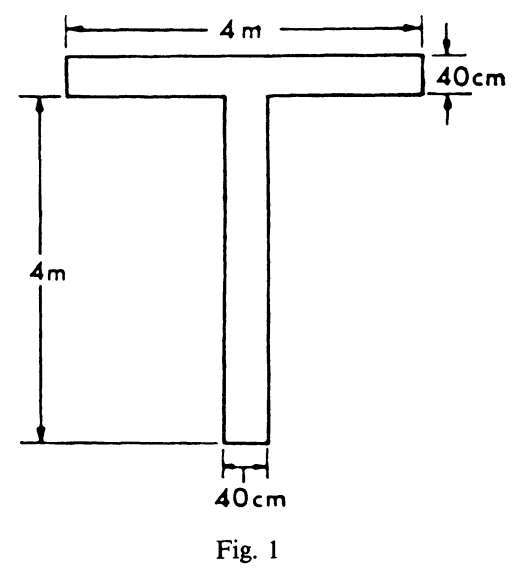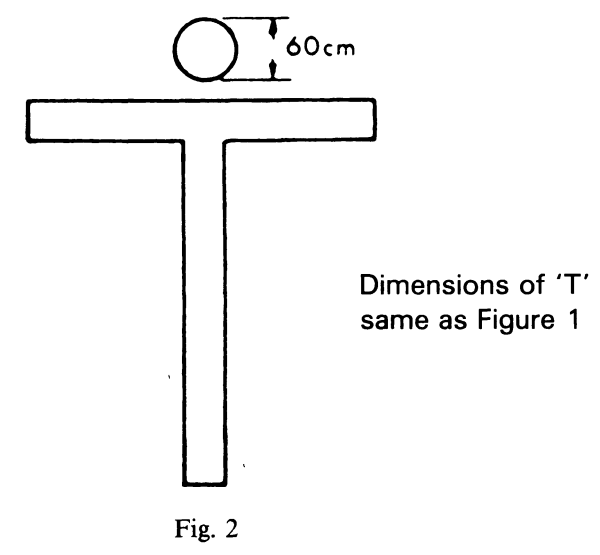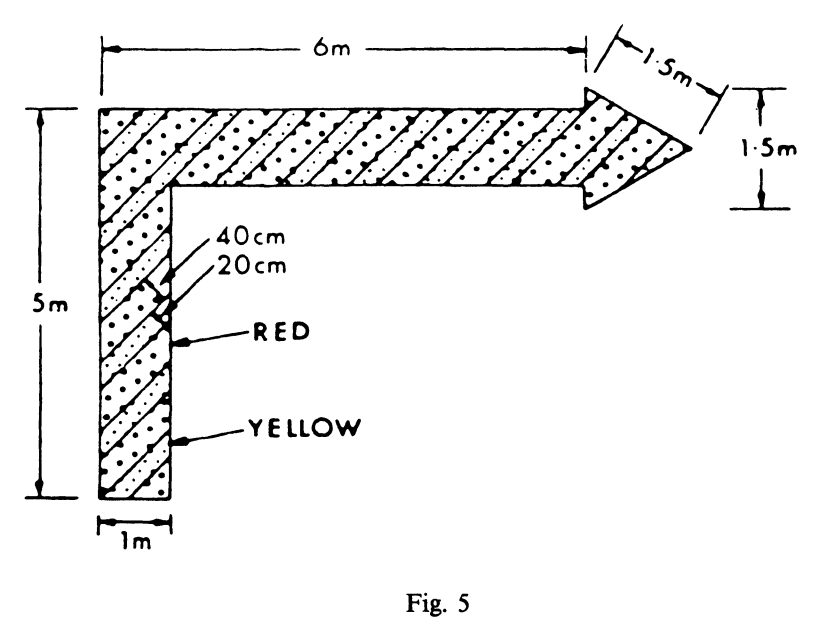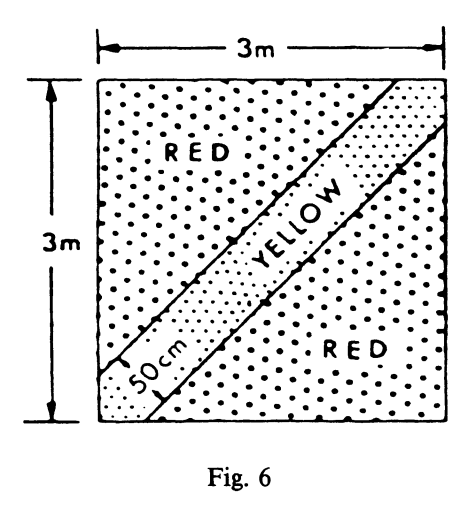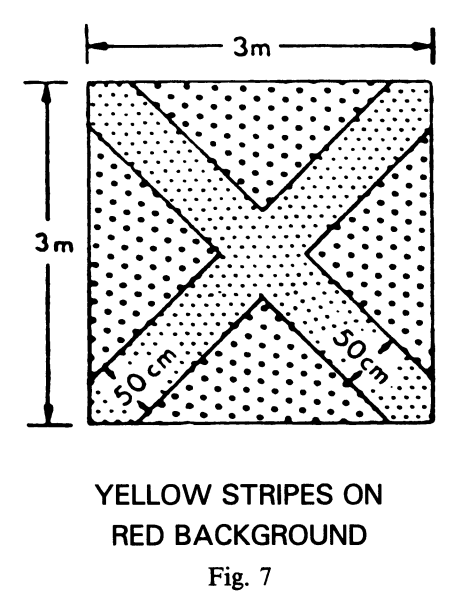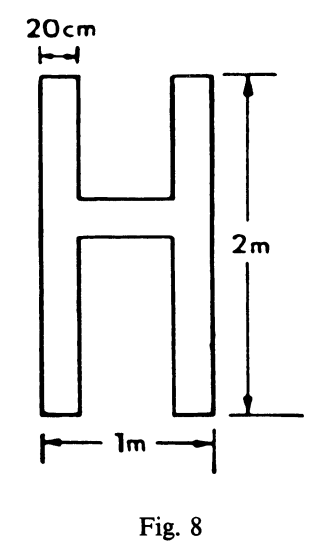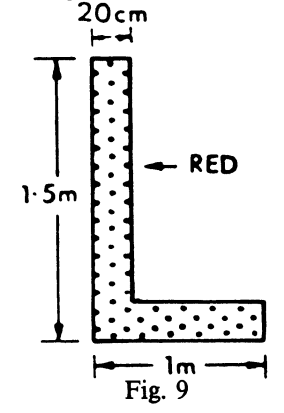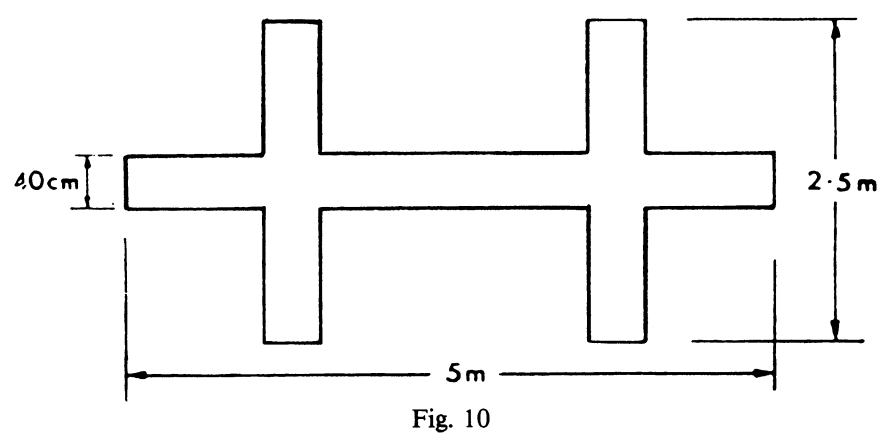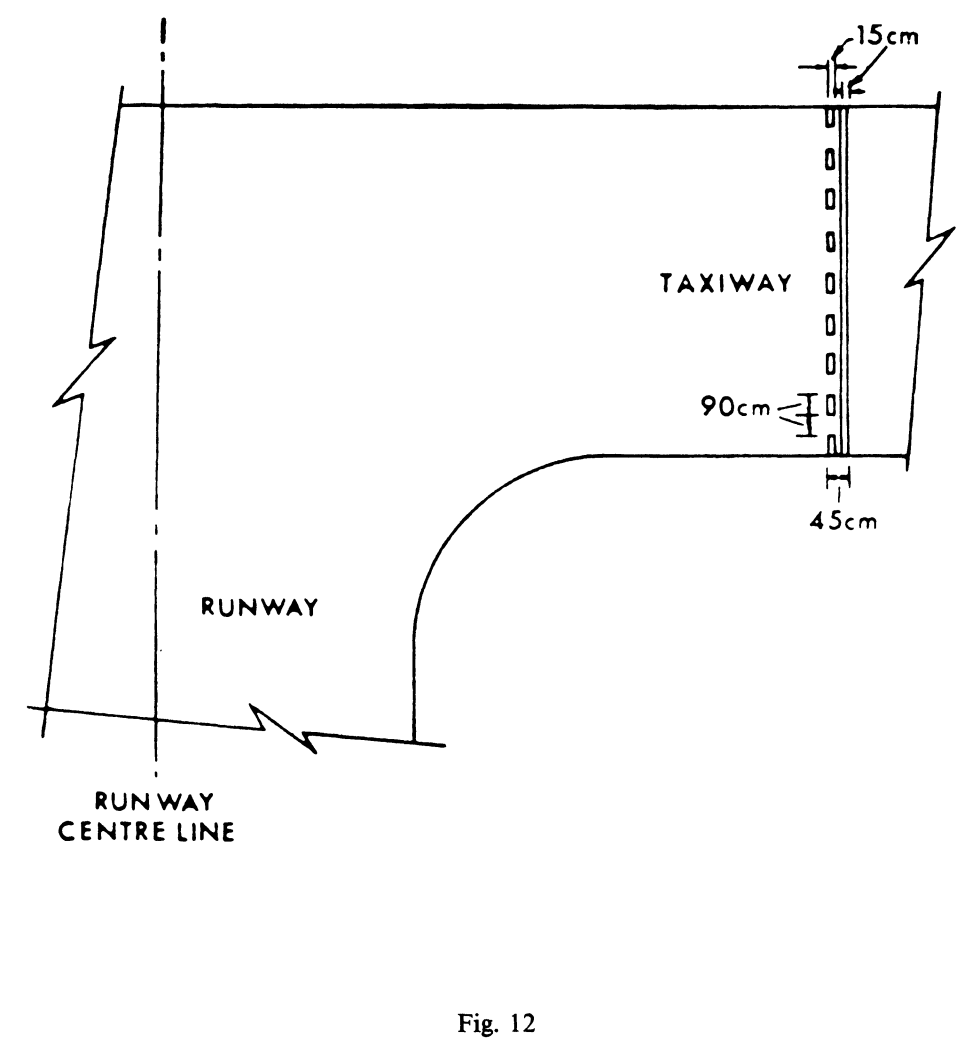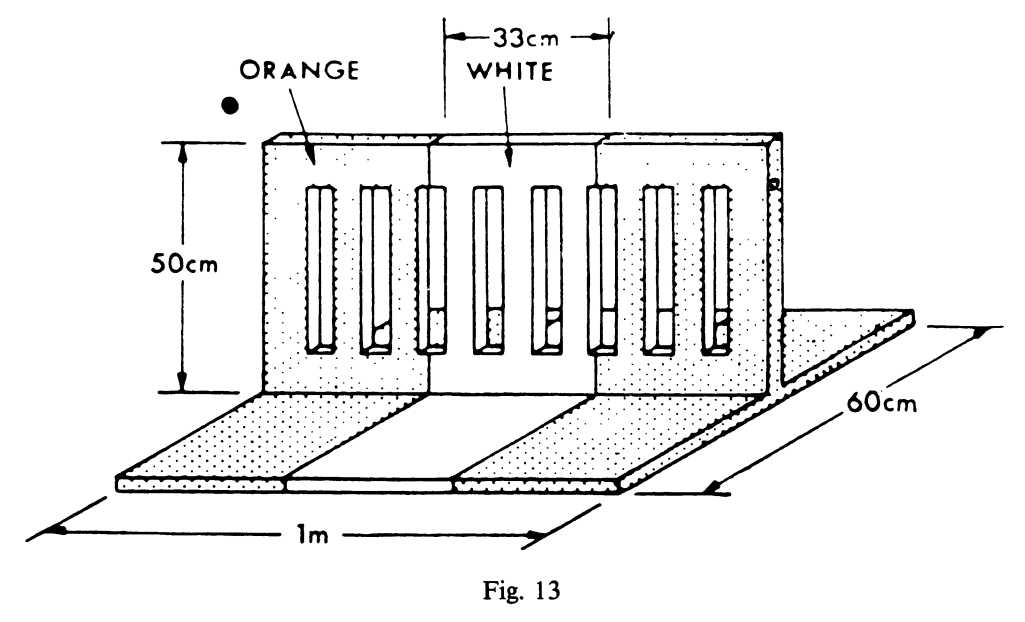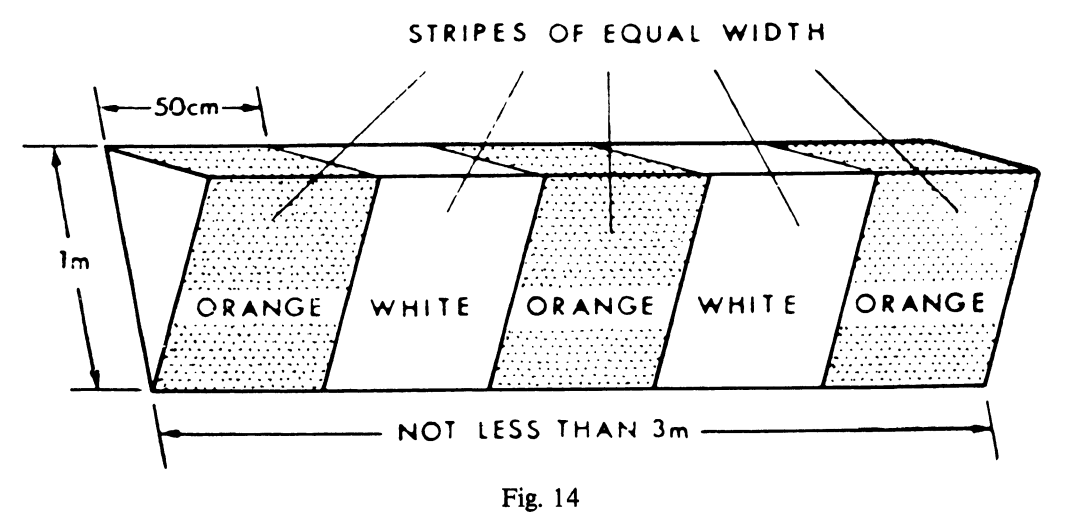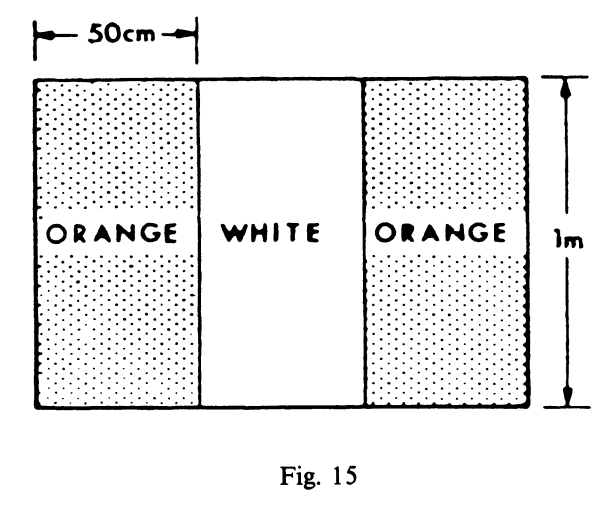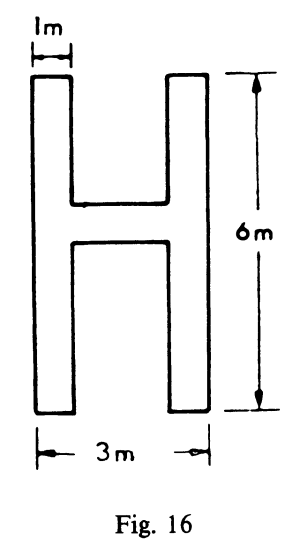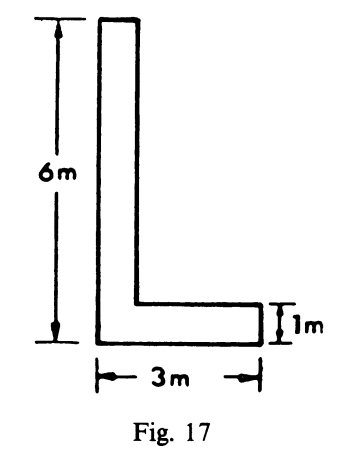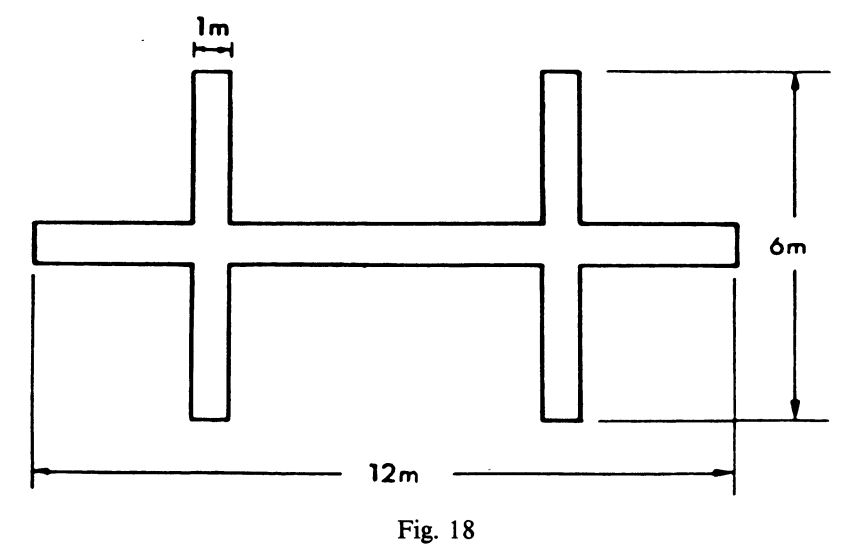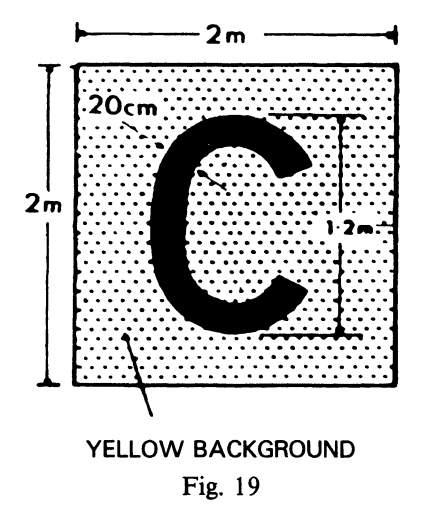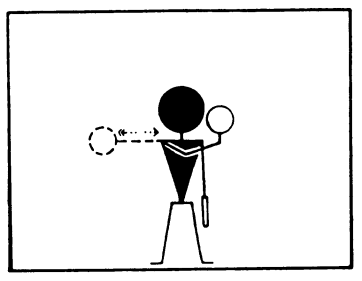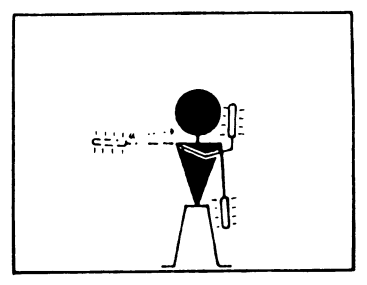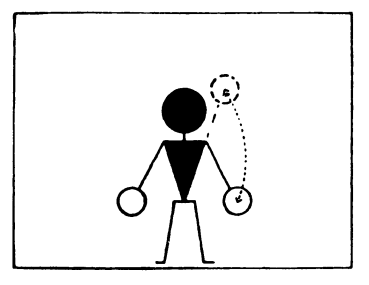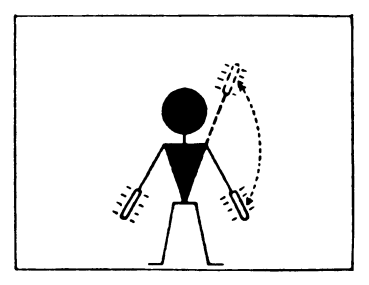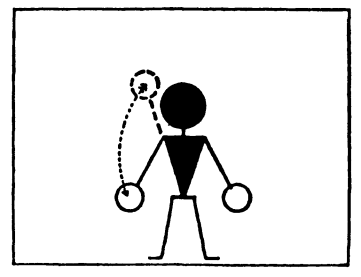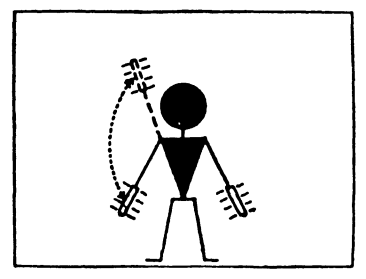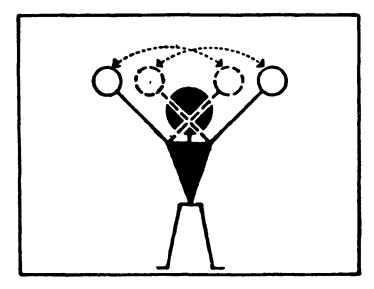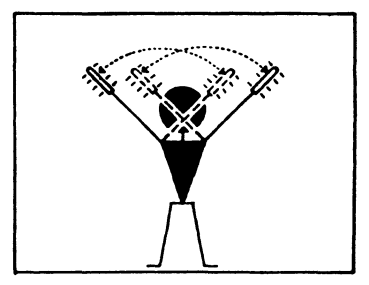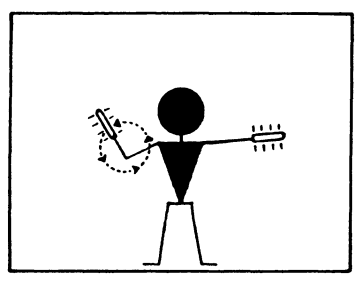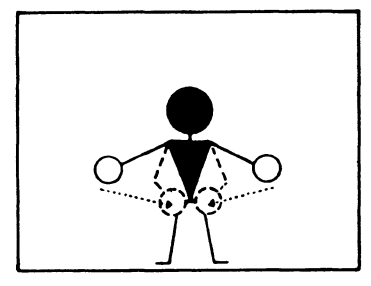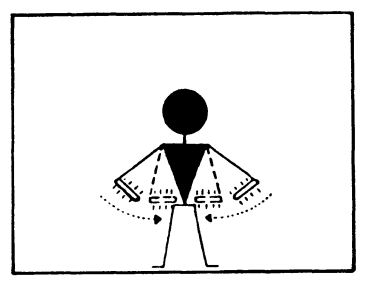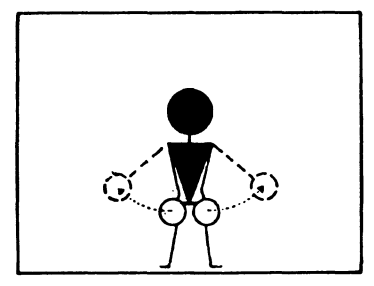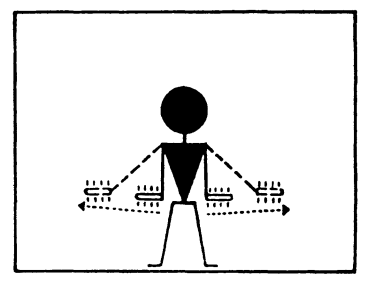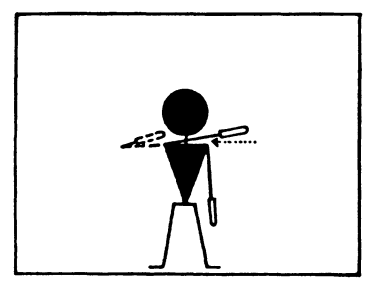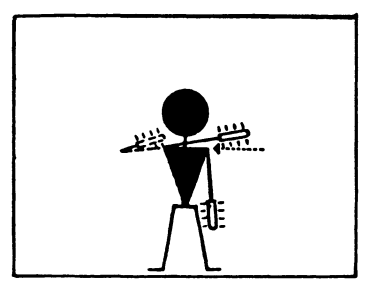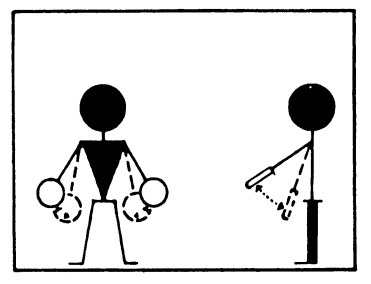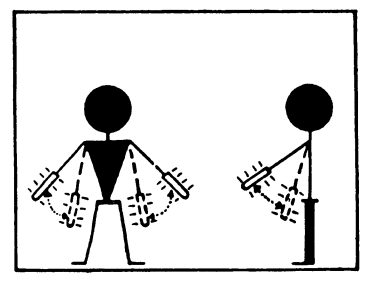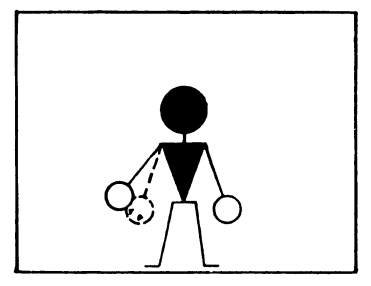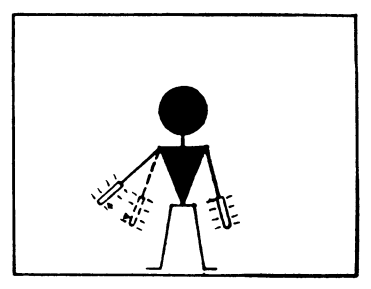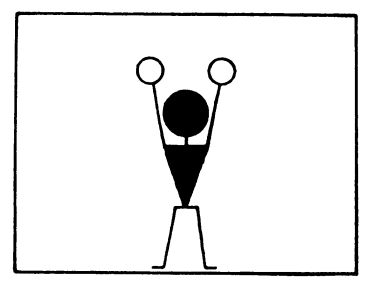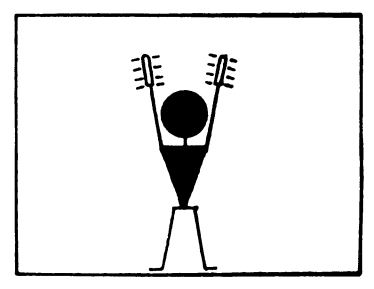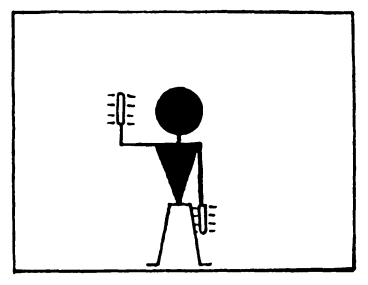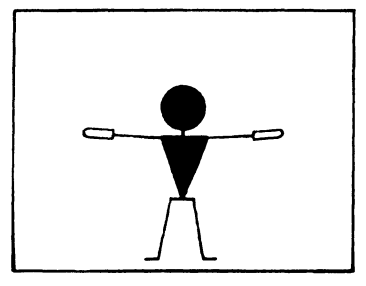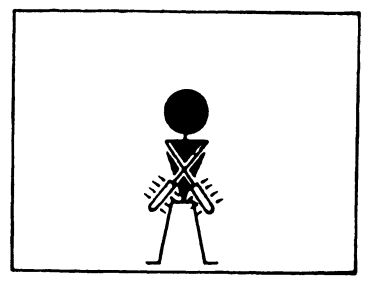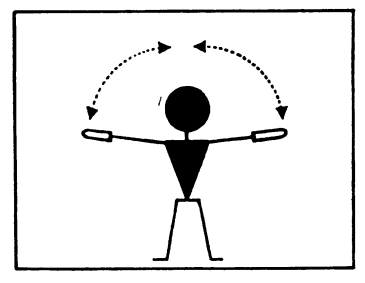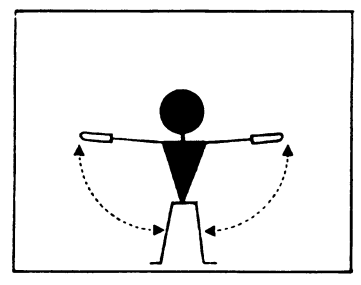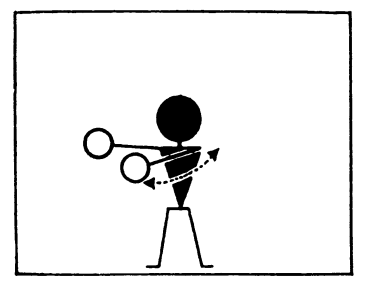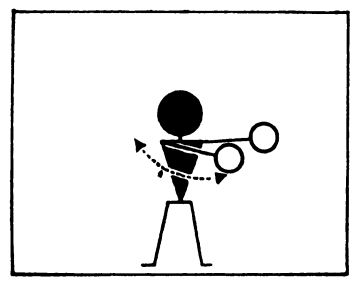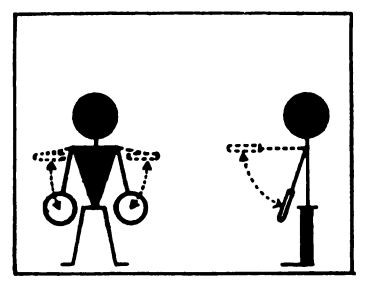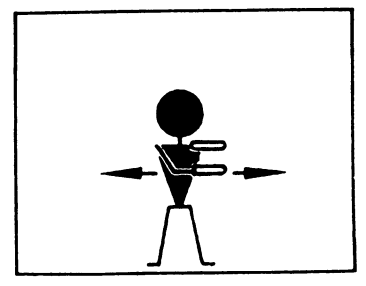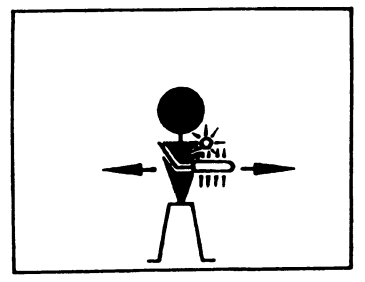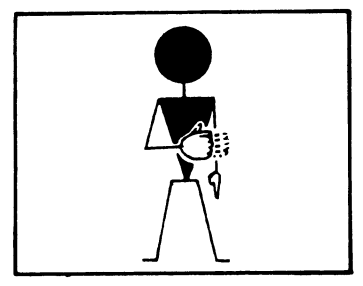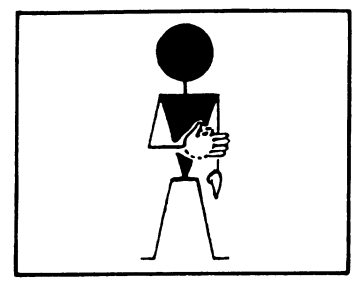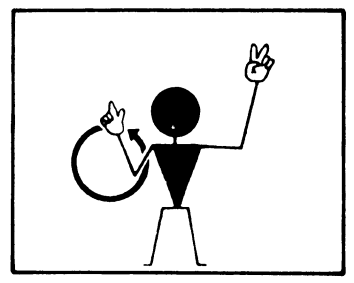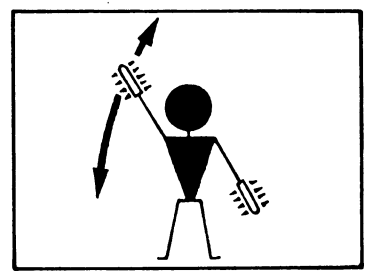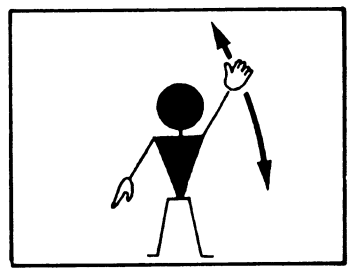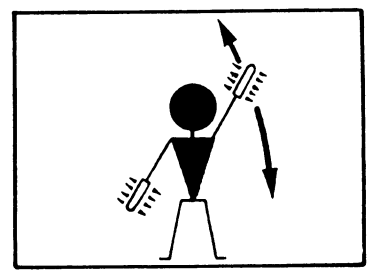- Latest available (Revised)
- Original (As made)
The Air Navigation (Overseas Territories) Order 1989
You are here:
- UK Statutory Instruments
- 1989 No. 2395
- Schedules only
More Resources
Status:
This is the original version (as it was originally made). This item of legislation is currently only available in its original format.
Article 4(6), 23(2) and 99(8)
SCHEDULE 1
PART ATABLE OF GENERAL CLASSIFICATION OF AIRCRAFT
| Col. 1 | Col. 2 | Col. 3 | Col. 4 | |
|---|---|---|---|---|
| Aircraft | { Lighter than air aircraft | { Non-power driven | { Free Balloon { Captive Balloon | |
| { Power driven | { Airship | |||
| { Heavier than air aircraft | { Non-power driven | { Glider { Kite | ||
| { Power driven (flying machines) | { Aeroplane (Landplane) { Aeroplane (Seaplane) { Aeroplane (Amphibian) { Aeroplane (Self-launching Motor Glider) | |||
| { Rotorcraft | { Helicopter { Gyroplane |
Article 5(2)
PART BNATIONALITY AND REGISTRATION MARKS OF AIRCRAFT REGISTERED IN THE TERRITORY
1. The nationality mark of the aircraft shall be a group of two capital letters in Roman character and the registration mark shall be a group of three capital letters in Roman character assigned by the Governor on the registration of the aircraft. The letters shall be without ornamentation and a hyphen shall be placed between the nationality mark and the registration mark.
2. The nationality and registration marks shall be displayed to the best advantage, taking into consideration the constructional features of the aircraft and shall always be kept clean and visible.
3. The nationality and registration marks shall also be inscribed, together with the name and address of the registered owner of the aircraft, on a fireproof metal plate affixed—
(a)in the case of an aeroplane having an empty weight not exceeding 150 kg. either in accordance with paragraph (b) or in a prominent position to the wing,
(b)in the case of any other aircraft in a prominent position on the fuselage or car or basket, as the case may be, and near to the main entrance to the aircraft.
4. The nationality and registration marks shall be painted on the aircraft or shall be affixed thereto by any other means ensuring a similar degree of permanence in the following manner:
I. Position of marks
(a)Flying Machines and Gliders
(i)Horizontal Surfaces of the Wings or Fuselage (or equivalent structure):
(aa)On aircraft having a fixed wing surface, the marks shall appear on the lower surface of the wing structure, and shall be on the left half of the lower surface of the wing structure unless they extend across the whole surface of both wings. So far as possible the marks shall be located equidistant from the leading and trailing edges of the wings. The tops of the letters shall be towards the leading edge of the wing.
(bb)On aircraft having no fixed wing surface and when owing to the structure of the aircraft the greatest height reasonably practicable for the marks on the vertical surface of the fuselage (or equivalent structure) is less than 15 centimetres the marks shall also appear on the lower surface of the fuselage on the line of symmetry and shall be placed with the tops of the letters towards the nose.
(ii)Vertical Surfaces of the Tail or Fuselage (or equivalent structure): The marks shall also be on each side of the aircraft either on the fuselage or on the upper halves of the vertical tail surfaces. On aircraft having a fixed wing surface, the marks, if placed on the fuselage (or equivalent structure), shall be between the horizontal tail surfaces and the wing. When on a single vertical tail surface, the marks shall be on both sides. When there is more than one vertical tail surface, the marks shall be on the outer sides of the outboard vertical tail surfaces.
(b)Airships and Free Balloons
(i)Airships: The marks shall be on each side of the airship. They shall be placed horizontally either on the hull near the maximum cross-section of the airship or on the lower vertical stabiliser.
(ii)Free Balloons: The marks shall be in two places diametrically opposite.
(iii)In the case of all airships and free balloons the side marks shall be so placed as to be visible both from the sides and from the ground.
II. Size of Marks
(a)Flying Machines and Gliders
(i)Wings: The letters constituting each group of marks shall be of equal height. The height of the letters shall be at least 50 centimetres.
(ii)Fuselage (or equivalent structure) or Vertical Tail Surfaces: The marks on the fuselage (or equivalent structure) shall not interfere with the visible outlines of the fuselage (or equivalent structure). The marks on the vertical tail surfaces shall be such as to leave a margin of at least 5 centimetres along each side of the vertical tail surface. The letters shall be of equal height. The height of the letters constituting each group of marks shall be at least 30 centimetres. Where marks are required to be carried on the lower surface of aircraft having no fixed wing surface, the height of the marks shall be at least 50 centimetres.
Provided that where owing to the structure of the aircraft the appropriate height specified in this sub-paragraph (ii) is not reasonably practicable, the height of the marks shall be the greatest height reasonably practicable in the circumstances consistent with compliance with Section III of this Part of this Schedule.
(b)Airships and Free Balloons
The letters constituting each group of marks shall be of equal height. The height of the letters shall be at least 50 centimetres.
III. Width and Spacing of Marks
(a)The width of each letter (except the letter I) and the length of the hyphen between the nationality mark and registration mark shall be two-thirds of the height of a letter.
(b)The letters and hyphen shall be formed by solid lines and shall be of a colour clearly contrasting with the background on which they appear. The thickness of the lines shall be one-sixth of the height of a letter.
(c)Each letter shall be separated from the letter which it immediately precedes or follows by a space equal to half the width of a letter. A hyphen shall be regarded as a letter for this purpose.
Article 4(8)
PART CAIRCRAFT DEALER'S CERTIFICATE—CONDITIONS
(1) The operator of the aircraft shall be the registered owner of the aircraft, who shall be the holder of an aircraft dealer’s certificate granted under this Order.
(2) The aircraft shall fly only for the purpose of:
(a)testing the aircraft; or
(b)demonstrating the aircraft with a view to the sale of that aircraft or of other similar aircraft; or
(c)proceeding to or from a place at which the aircraft is to be tested or demonstrated as aforesaid, or overhauled, repaired or modified; or
(d)delivering the aircraft to a person who has agreed to buy, lease or sell it; or
(e)proceeding to or from a place for the purpose of storage.
(3) Without prejudice to the provisions of Article 32 of this Order the operator of the aircraft shall satisfy himself before the aircraft takes off that the aircraft is in every way fit for the intended flight.
(4) The aircraft shall fly only within the Territory.
Articles 3(1), 7(1) and 39(7)
SCHEDULE 2A AND B CONDITIONS
The A Conditions and B Conditions referred to in Articles 3(1), 7(1) and 39(7) of this Order are as follows:
A Conditions
(1) The aircraft shall be either an aircraft in respect of which a certificate of airworthiness or validation has previously been in force under this Order, or an aircraft identical in design with an aircraft in respect of which such a certificate is or has been in force.
(2) The aircraft shall fly only for the purpose of enabling it to:
(a)qualify for the issue or renewal of a certificate of airworthiness or of the validation thereof or the approval of a modification of the aircraft, after an application has been made for such issue, renewal, validation or approval as the case may be; or
(b)proceed to or from a place at which any inspection, approval, test or weighing of, or the installation of equipment in, the aircraft is to take place for a purpose referred to in subparagraph (a), after such an application has been made, or at which the installation of furnishings in, or the painting of, the aircraft is to be undertaken; or
(c)proceed to or from a place at which the aircraft is to be or has been stored.
(3) The aircraft and its engines shall be certified as fit for flight by the holder of an aircraft maintenance engineer’s licence granted under this Order, being a licence which entitles him to issue that certificate or by a person approved by the Governor for the purpose of issuing certificates under this condition, and in accordance with that approval.
(4) The aircraft shall carry the minimum flight crew specified in any certificate of airworthiness or validation which has previously been in force under this Order respect of the aircraft, or is or has previously been in force in respect of any other aircraft of identical design.
(5) The aircraft shall not carry any persons or cargo except persons performing duties in the aircraft in connection with the flight or persons who are carried in the aircraft to perform duties in connection with a purpose referred to in paragraph (2) of these Conditions.
(6) The aircraft shall not fly over any congested area of a city, town or settlement except to the extent that it is necessary to do so in order to take off from or land at a Government aerodrome or a licensed aerodrome, in accordance with normal aviation practice.
(7) Without prejudice to the provisions of Article 18(2) of this Order, the aircraft shall carry such flight crew as may be necessary to ensure the safety of the aircraft.
B Conditions
(1) The flight shall be made under the supervision of a person approved by the Governor for the purposes of these Conditions, and subject to any additional conditions which may be specified in such approval.
(2) If it is not registered in the Territory or under the law of any country referred to in Article 3 of this Order, the aircraft shall be marked in a manner approved by the Governor for the purposes of these Conditions, and the provisions of Articles 14,15,19,32,35,57 and 59 of this Order shall be complied with in relation to the aircraft as if it was registered in the Territory so far as such provisions are applicable to the aircraft in the circumstances.
(3) The aircraft shall fly only for the purpose of—
(a)experimenting with or testing the aircraft (including in particular its engines) and its equipment; or
(b)enabling it to qualify for the issue of a certificate of airworthiness or the validation thereof, or the approval of a modification of the aircraft; or
(c)proceeding to or from a place at which any experiment, inspection, approval, test or weighing of, or the installation of equipment in, the aircraft is to take place for a purpose referred to in subparagraph (a) or (b), or at which the installation of furnishings in, or the painting of, the aircraft is to be undertaken; or
(d)demonstrating the aircraft with a view to the sale of that aircraft or of other similar aircraft.
(4) Without prejudice to the provisions of Article 18(2) of this Order, the aircraft shall carry such flight crew as may be necessary to ensure the safety of the aircraft.
(5) The aircraft shall not carry any cargo, or any persons other than the flight crew except the following:
(a)persons employed by the operator who carry out during the flight duties in connection with the purposes specified in paragraph (3) of these Conditions;
(b)persons employed by manufacturers of component parts of the aircraft (including its engines) who carry out during the flight duties in connection with the purposes so specified;
(c)persons approved by the Governor under Article 8(8) of this Order as qualified to furnish reports for the purposes of that Article;
(d)persons, other than those carried under the preceding provisions of this paragraph, who are carried in the aircraft in order to carry out a technical evaluation of the aircraft or its operation.
(6) The aircraft shall not fly, except in accordance with procedures which have been approved by the Governor in relation to that flight, over any congested area of a city, town or settlement.
Article 8
SCHEDULE 3
Transport Category (Passenger).
Transport Category (Cargo).
Aerial Work Category.
Private Category.
Special Category.
The purposes for which the aircraft may fly are as follows:
Transport Category (Passenger): Any purpose.
Transport Category (Cargo): Any purpose, other than the public transport of passengers.
Aerial Work Category: Any purpose other than public transport.
Private Category: Any purpose other than public transport or aerial work.
Special Category: Any purpose, other than public transport, specified in the certificate of airworthiness but not including the carriage of passengers unless expressly permitted.
Articles 11(4) and 13(2)
SCHEDULE 4AIRCRAFT EQUIPMENT
1. Every aircraft of a description specified in the first column of the Table set forth in paragraph 4 of this Schedule and which is registered in the Territory shall be provided, when flying in the circumstances specified in the second column of the said Table, with adequate equipment, and for the purpose of this paragraph the expression “adequate equipment” shall mean the scales of equipment respectively indicated in that Table:
Provided that, if the aircraft is flying in a combination of such circumstances, the scales of equipment shall not on that account be required to be duplicated.
2. The equipment carried in an aircraft as being necessary for the airworthiness of the aircraft shall be taken into account in determining whether this Schedule is complied with in respect of that aircraft.
3. The following items of equipment shall not be required to be of a type approved by the Governor:
(i)The equipment referred to in Scale A (ii).
(ii)First aid equipment and handbook, referred to in Scale B.
(iii)Time-pieces, referred to in Scale F.
(iv)Torches, referred to in Scales G, H, J and Z.
(v)Whistles, referred to in Scale H.
(vi)Sea anchors, referred to in Scales I and J.
(vii)Rocket signals, referred to in Scale I.
(viii)Equipment for mooring, anchoring or manoeuvring aircraft on the water, referred to in Scale I.
(ix)Paddles, referred to in Scale J.
(x)Food and water, referred to in Scales J, U and V.
(xi)First aid equipment, referred to in Scales J, U and V.
(xii)Stove, cooking utensils, snow shovels, ice saws, sleeping bags and Arctic suits, referred to in Scale V.
(xiii)Megaphones, referred to in Scale Y.
4. TABLE
| Description of aircraft | Circumstances of Flight | Scale of Equipment Required |
|---|---|---|
* For the purposes of this Table, flying time shall be calculated on the assumption that the aircraft is flying in still aid at the speed specified in the relevant Certificate of Airworthiness as the speed for compliance with regulations governing flights over water. | ||
* For the purposes of this Table, flying time shall be calculated on the assumption that the helicopter or gyroplane is flying in still air at the speed specified in the relevant Certificate of Airworthiness as the speed for compliance with regulations governing flights over water. | ||
(1) Gliders | (a)flying for purposes other than public transport or aerial work when flying by night. | A(ii) |
(b)Flying for the purpose of public transport or aerial work, and (i)when flying by night | A, B, D and F(i) C and G | |
(ii)when carrying out aerobatic manoeuvres | M | |
(2) Aeroplanes | (a)flying for purposes other than public transport; and | A |
(i)when flying by night | C and D | |
(ii)When flying under Instrument Flight Rules (aa)outside controlled airspace | D | |
(bb)within controlled airspace | E with E(iv) duplicated and F | |
(iii)when carrying out aerobatic manoeuvres | M | |
(iv)when flying for the purpose of aerial work | B(i) | |
(b)flying for the purpose of public transport; and | A, B, D and F(i) | |
(i)when flying under Instrument Flight rules except flightsw outside controplled airspace by aeroplanes having amaximum total weight authorised not exceeding 1,150 kg. | E with E(iv) duplicated and F, C and G | |
(ii)when flying by night; and in the case of aeroplanes of which the maximum total weight authorised exceeds 1,150 kg. | E with E(iv) duplicated and F | |
(iii)when flying over water beyond gliding distance from land | H | |
(iv)on all flights on which in the event of any emergency occurring during the take-off or during the landing at the intended destination or any likely alternate destination it is reasonably possible that the aeroplane would be forced to land onto water | H | |
(v)when flying over water— (aa)in the case of an aeroplane— (aaa)classified in its certificate of airworthiness as being of performance group A, C or X; or (bbb)having no performance group classification in its certificate of airworthiness and of such a weight and performance that with any one of its power units inoperative and the remaining power unit or units operating within the maximum continuous power conditions specified in the certificate of airworthiness, performance schedule or flight manual relating to the aeroplane issued or rendered valid by the Governor it is capable of a gradient of climb of at least 1 in 200 and an altitude of 5,000 feet in the International Standard Atmosphere specified in or ascertainable by reference to the certificate of airworthiness in force in respect of that aircraft when either more than 400 nautical miles or more than 90 minutes flying time* from the nearest aerodrome at which an emergency landing can be made | H and J | |
(bb)in the case of all other aeroplanes when more than 30 minutes flying time* from such an aerodrome | H and J | |
(vi)on all flights which involve manoeuvres on water | H, I and J | |
(vii)when flying at a height of 10,000 feet or more above mean sea level; (aa)having a certificate of airworthiness first issued (whether in the Territory or elsewhere) before 1st January 1991 | K1 or K2 | |
(bb)having a certificate of airworthiness first issued (whether in the Territory or elsewhere) on or after 1st January 1991 | K2 | |
(viii)on flights when the weather reports or forecasts available at the aerodrome at the time of departure indicate that conditions favouring ice for mation are likely to be met | L | |
(ix)when carrying out aerobatic manoeuvres | M | |
(x)on all flights on which the aircraft carries a flight crew of more than one person | N | |
(xi)on all flights for the purpose of the public transport of passenters | Q and Y | |
(xii)on all flights by a pressurised aircraft | R | |
(aa)before 1st January 1992 | R1 | |
(bb)on or after 1st January 1992 | R2 | |
(xiii)when flying over substantially uninhabited land areas where, in the event of an emergency landing, tropical conditions are likely to be met | U | |
(xiv)when flying over substantially uninhabited land or other areas where, in the event of an emergency landing, polar conditions are likely to be met | V | |
(xv)when flying at an altitude of more than 49,000 feet | W | |
(3) Turbine-jet aeroplanes having a maximum total weight authorised exceeding 5,700 kg. or ressurised aircraft having a maximum total weight authorised exceeding 11,400 kg. | When flying for the purpose of public transport | O |
(4) Turbine-engined aeroplanes having a maximum total weight authorised exceeding 5,700 kg. and piston-engined aeroplanes having a maximum total weight authorised exceeding 27,000 kg. (a)which are operated by an air transport undertaking under a certificate of airworthiness of the Transport category (Passenger) or the Transport Category (Cargo) | when flying on any flight | P |
(b)in respect of which application has been made and not withdrawn or refused for such a certificate, and which fly under the “A” Conditions or under a certificate of airworthiness of the Special Category | when flying on any flight | P |
Provided that this paragraph shall not apply to: (i) aeroplanes havinga maximum total weight authorised exceeding 230,000 kg. which conform to a type which was first issued with a type certificate in the Territory after 1st January 1970, or (ii) aeroplanes having a maximum total weight authorised exceeding 5,700 kg. but not exceeding 230,000 kg. which conform to a type whch was first issued with a type certificate (whether in the Territory or elsewhere) after 1st April 1971. | ||
(5) Aeroplanes— (a)which conform to a type first issued with a type certificate (whether in the Territory or elsewhere) on or after 1st April 1971 and which have a maximum total weight authorised exceeding 5,700 kg. and in respect of which there is in force a certificate of airworthiness in the Transport Category (Passenger) or Transport Category (Cargo); or | when flying on any flight | S |
(b)which conform to a type first issued with a type certificate in the Territory on or after 1st january 1970 and having a maximum total weight authorised exceeding 230,000 kg. and in respect of which there is in force such a certificate of airworthiness; or | when flying on any flight | S |
(c)having a maximum total weight authorized exceeding 5,700 kg. which conform to a type first issued with a type certificate on or after 1st April 1971 (or 1st January 1970 in the case of an aeroplane over 230,000 kg. maximum total weight authorized) in respect of which application has been made, and not withdrawn or refused, for such a certificate of airworthiness and which fly under the “A Conditions” or in respect of which there is in force a certificate of airworthiness in the Special category. | when flying on any flight | S |
(6) Aeroplanes— (a)which conform to a type first issued with a type certificate (whether in the Territory or elsewhere) on or after 1st April 1971 and which have maximum total weight authorized exceeding 27,000 kg. and in respect of which there is in force a certificate of airworthiness in the Transport Category (Passenger) or the Transport Category (Cargo); or | when flying on any flight | T |
(b)which conform to a type first issued with a type certificate in the Territory on or after 1st January 1970 and which have a maximum total weight authorized exceeding 230,000 kg. and in respect of which there is in force such a certificate of airworthiness; or | when flying on any flight | T |
(c)having a maximum total weight authorized exceeding 27,000 kg. which conform to a type first issued with a type certificate on or after 1st April 1971 (or 1st january 1970 in the case of an aeroplane having a maximum total weight authorized exceeding 230,000 kg.) in respect of which an application has been made, and not withdrawn or refused for such a certificate of airworthiness and which fly under the “A Conditions” or in respect of which there is in force a certifecate of airworthiness in the Special Category. | when flying on any flight | T |
(7) Aeroplanes which have a maximum total weight authorised exceeding 15,000 kg. or which in accordance with the certificate of airworthness in force in respect thereof may carry more than 30 passengers. | On all flights for the purpose of public transport | X |
(8) Aeroplanes— (a)which are4 a turbo-jet and which have a maximum total weight authorised exceeding22,700 kg.; or | when flying by night for the purpose of the public transport of passengers | Z(i) and (ii) |
(b)having a maximum total weight authorised exceeding 5,700 kg. and which conform to a type for which a certificate of airworthiness was first applied for (whether in the Territory or elsewhere) after 30th April 1972 but not including any aeroplane which in the opinion of the Governor is identical in all matters affecting the provision of emergency evacuation facilities to an aeroplane for which a certificate of airworthiness was first applied for before that date; or | when flying by night for the purpose of the public transport of passengers | Z(i) and (ii) |
(c)which in accordance with the certificate of airworthiness in force in respect thereof may carry more than 19 persons over 3 years of age. | when flying by night for the purpose of the public transport of passengers | Z(i) |
(9) Helicopters and Gyroplanes | (a) flying for purposes other than public transport; and | A |
(i)when flying by day under Visual Flight Rules with visual ground reference | D | |
(ii)when flying by day under Instrument Flight Rules or without visual ground reference (aa)outside controlled airspace | E with E(ii) duplicated | |
(bb)within controlled airspace | E with E(ii) and E(iv) duplicated and F with F(iv) for all weights | |
(iii)when flying at night. | ||
(aa)with visual ground reference. | C, E, G(iii) and G(v) | |
(bb)without visual ground reference— (aaa)outside controlled airspace | C, E with E(ii) duplicated G(iii) and G(v). | |
(bbb)within controlled airspace. | C, E, with bpoth E(ii) and E(iv) duplicated, F with F(iv) for all weights, G(iii) and G(v). | |
(b)flying for the purpose of public transport; and | A, B, F(i) and F(iv) for all weights. | |
(i)when flying by day under Visual Flight Rules with visual ground reference | D | |
(ii)when flying by day under Instrument Flight Rules or without visual ground reference | E with both E(ii) and E(iv) duplicated, F(ii)_, F(iii) and F(v). | |
(iii)when flying by night with visual ground reference (aa)in the case of a helicopter or gyroplane having a maximum total weight authorised not exceeding 2,000 kg. | C, E and G. | |
(bb)in the case of a helicopter or gyroplane having a maximum total weight authorised exceeding 2,000 kg. | C, E with E(ii) duplicated and either E(iv) duplicated or a radio altimeter, F(ii), F(iii), F(v) and G. | |
(iv)when flying by night without visual ground reference | C, E with both E(ii) and E(iv) duplicated, F(ii), F(iii) and F(v), and G. | |
(v)when flying over water (aa)in the case of a helicopter or a gyroplane classified in its Certificate of Airworthiness as being of performance group A2 or B when beyond autorotational gliding distance from land suitable for an emergency landing | E and H. | |
(bb)on all flights on which in the event of any emergency occurring during the take-off or during the landing at the intended destination or any likely alternate destination it is reasonably possible that the helicopter or gyroplane would be forced to land onto water | H. | |
(cc)in the case of a helicopter or a gyroplane classified in its Certificate of airworthiness as being of performance group A2 when beyond 10 minutes flying time* from land | E, H, J and T. | |
(dd)for more than a total of three minutes in any flight | EE | |
(ee)in the case of a helicopter or a gyroplane classified in its certificate of airworthiness as being of performance group A2 which is intended to fly beyond ten minutes flying time from land or which actually flies beyond ten minutes flying time from land, on a flight in support of or in connection with the offshore exploitation or exploration of mineral resources (including gas) when the weather report or forecasts available to the commander of the aircraft indicate that the sea temperature will be less than plus ten degrees centigrade during the flight or when any part of the flight is at night | HH | |
(vi)on all flights which involve manoeuvres on water | H, I and J. | |
(vii)when flying at a height of 10,000 feet or more above mean sea level: (aa)having a certificate of airworthiness first issued (whether in the Territory or elsewhere) before 1st January 1991 | K1 or K2 | |
(bb)having a certificate of airworthiness first issued (whether in the Territory or elsewhere) on or after 1st January 1991 | K2 | |
(viii)on flights when the weather reports or forecasts available at the aerodrome at the time of departure indicate that conditions favouring ice formation are likely to be met. | L | |
(ix)on all flights on which the aircraft carries a flight crew of more than one person | N | |
(x)on all flights for the purpose of the public transport of passengers | Y | |
(xi)when flying over substantially uninhabited land areas where, in the event of emergency landing, tropical conditions are likely to be met | U | |
(xii)when flying over substantially uninhabited land or other areas where, in the event of an emergency landing, polar conditions are likely to be met. | V | |
(10) Helicopters and Gyroplanes— (a)having a maximum total weight authorised exceeding 5,700 kg. and which conform to a type for which a certificate of airworthiness was first applied for (whether in the Territory or elsewhere) after 30th April 1972 but not including any helicopter or gyroplane which in the opinion of the Governor is identacal in all matters affecting the provision of emergency evacuation facilities to a helicopter or gyroplane for which a certificate or airworthiness was first applied for before that date; or | when flying by night for the purpose of the public transport of passenters | Z(i) and (ii) |
(b)which, in accordance with the certificate of airworthiness in force in respect thereof, may carry more than 19 persons over 3 years of age; or | when flying by night for the purpose of the public transport of passengers | Z(i) |
(c)which have a certificate or airworthiness issued in the Transport Category (passenger or cargo) and which has either a maximum total weight authorised exceeding 2,700 kg. or which may carry more than 9 passengers. | when flying on any flight beginning on or after 1st January 1991 | S |
5. The scales of equipment indicated in the foregoing Table shall be as follows:
Scale A
(i)Spare fuses for all electrical circuits the fuses of which can be replaced in flight, consisting of 10 per cent, of the number of each rating or three of each rating, whichever is the greater;
(ii)Maps, charts, codes and other documents and navigational equipment necessary, in addition to any other equipment required under this Order, for the intended flight of the aircraft, including any diversion which may reasonably be expected.
(iii)(a)Subject to Scale B(iii)(a), in all aeroplanes, helicopters and gyroplanes for every pilot’s seat and for any seat situated alongside a pilot’s seat, a safety belt with one diagonal shoulder strap or a safety harness:
Provided that the Governor may permit a safety belt without a diagonal shoulder strap to be fitted if he is satisfied that it is not reasonably practicable to fit a safety belt with one diagonal shoulder strap, or a safety harness.
(b)Subject to Scale B(iii)(b) for every seat in use (not being a seat referred to in sub-paragraph (a) above) a safety belt with or without one diagonal shoulder strap or a safety harness.
(c)In addition and for attachment to the equipment required in sub-paragraph (b) above, a child restraint device for every child under the age of two years on board.
Scale B
(i)First-aid equipment of good quality, sufficient in quantity, having regard to the number of persons on board the aircraft, and including the following:
Roller bandages, triangular bandages, adhesive plaster, absorbent gauze, cotton wool (or wound dressings in place of the absorbent gauze and cotton wool), burn dressings, safety pins;
Haemostatic bandages or tourniquets, scissors;
Antiseptic, analgesic and stimulant drugs;
Splints, in the case of aeroplanes the maximum total weight authorised of which exceeds 5,700 kg;
A handbook on First Aid.
(ii)In the case of a flying machine used for the public transport of passengers in which, while the flying machine is at rest on the ground, the sill of an external door intended for the disembarkation of passengers, whether normally or in an emergency.
(a)is more than 1.82 metres from the ground when the undercarriage of the machine is in the normal position for taxying, or
(b)would be more than 1.82 metres from the ground if the undercarriage or any part thereof should collapse, break or fail to function.
apparatus readily available for use at each such door consisting of a device or devices which will enable passengers to reach the ground safely in an emergency while the flying machine is on the ground, and can be readily fixed in position for use.
(iii)(a)If the maximum total weight authorised of the aircraft exceeds 2,730 kg, a safety harness for every pilot’s seat in use, in place of the safety belt with one diagonal shoulder strap referred to under Scale A:
Provided that the Governor may permit a safety belt with one diagonal shoulder strap to be fitted if he is satisfied that it is not reasonably practicable to fit a safety harness.
(b)On all flights for the public transport of passengers by aircraft, for each seat for use by cabin attendants who are required to be carried under this Order, a safety harness.
(iv)If the commander cannot, from his own seat, see all the passengers' seats in the aircraft, a means of indicating to the passengers that seat belts should be fastened.
Scale C
(i)Equipment for displaying the lights required by the Rules of the Air and Air Traffic Control;
(ii)Electrical equipment, supplied from the main source of supply in the aircraft, to provide sufficient illumination to enable the flight crew properly to carry out their duties during flight;
(iii)Unless the aircraft is equipped with radio, devices for making the visual signal specified in the Rules of the Air and Air Traffic Control as indicating a request for permission to land.
Scale D
(i)(a)In the case of a helicopter or a gyroplane, a slip indicator;
(b)In the case of any other flying machine either—
(aa)a turn indicator and a slip indicator; or
(bb)a gyroscopic bank and pitch indicator and a gyroscopic direction indicator,
(ii)a sensitive pressure altimeter adjustable for any sea level barometric pressure which the weather report or forecasts available to the commander of the aircraft indicate is likely to be encountered during the intended flight.
Scale E
(i)(a)In the case of a helicopter or a gyroplane, a slip indicator;
(b)In the case of any other flying machine, a turn indicator and a slip indicator;
(ii)A gyroscopic bank and pitch indicator;
(iii)A gyroscopic direction indicator;
(iv)A sensitive pressure altimeter adjustable for any sea level barometric pressure which the weather report or forecasts available to the commander of the aircraft indicate is likely to be encountered during the intended flight;
Provided that any aircraft may, at the option of the operator, be equipped with an additional gyroscopic bank and pitch indicator in lieu of the turn indicator referred to in (i) of this Scale.
Scale EE
On all flights beginning on or after 1st January 1991, a radio altimeter with an audio voice warning operating below a preset height and a visual warning capable of operating at a height selectable by the pilot.
Scale F
(i)A timepiece indicating the time in hours, minutes and seconds;
(ii)A means of indicating whether the power supply to the gyroscopic instruments is adequate;
(iii)A rate of climb and descent indicator;
(iv)If the maximum total weight authorised of the aircraft exceeds 5,700 kg. a means of indicating the outside air temperature;
(v)If the maximum total weight authorised of the aircraft exceeds 5,700 kg. two air speed indicators.
Scale G
(i)In the case of an aircraft other than a helicopter or gyroplane landing lights consisting of two single filament lamps, or one dual filament lamp with separately energised filaments;
(ii)An electric lighting system to provide illumination in every passenger compartment;
(iii)(a)one electric torch for each member of the crew of the aircraft; or
(b)(aa)one electric torch for each member of the flight crew of the aircraft; and
(bb)at least one electric torch affixed adjacent to each floor level exit intended for the disembarkation of passengers whether normally or in an emergency, provided that such torches shall:—
be readily accessible for use by the crew of the aircraft at all times; and
number in total not less than the minimum number of cabin attendants required to be carried with a full passenger complement;
(iv)In the case of an aircraft other than a helicopter or gyroplane of which the maximum total weight authorised exceeds 5,700 kg., means of observing the existence and build up of ice on the aircraft.
(v)(a)In the case of a helicopter or gyroplane in respect of which there is in force a certificate of airworthiness designating the helicopter or gyroplane as being of performance group A, either—
(aa)two landing lights both of which are adjustable so as to illuminate the ground in front and below the helicopter or gyroplane and one of which is adjustable so as to illuminate the ground on either side of the helicopter or gyroplane; or
(bb)one landing light or, if the maximum total weight authorised of the helicopter or gyroplane exceeds 5,700 kg., one dual filament landing light with separately energised filaments, or two single filament lights, each of which is adjustable so as to illuminate the ground in front and below the helicopter or gyroplane; and two parachute flares.
(b)In the case of a helicopter or gyroplane in respect of which there is in force a certificate of airworthiness designating the helicopter or gyroplane as being of performance group B, either—
(aa)one landing light and two parachute flares; or
(bb)if the maximum total weight authorised of the helicopter or gyroplane exceeds 5,700 kg. either one dual filament landing light with separately energised filaments or two single filament landing lights; and two parachute flares.
Scale H
For each person on board, a lifejacket equipped with a whistle and waterproof torch:
Provided that lifejackets constructed and carried solely for use by children under three years of age need not be equipped with a whistle.
Scale HH
A survival suit for each member of the crew.
Scale I
(i)Additional flotation equipment, capable of supporting one-fifth of the number of persons on board, and provided in a place of stowage accessible from outside the flying machine;
(ii)Parachute distress rocket signals capable of making, from the surface of the water, the pyrotechnical signal of distress specified in the Rules of the Air and Air Traffic Control and complying with Part III of Schedule 15 to the Merchant Shipping (Life-Saving Appliances) Regulations 1980(1);
(iii)A sea anchor and other equipment necessary to facilitate mooring, anchoring or manoeuvring the flying machine on water, appropriate to its size, weight and handling characteristics.
Scale J
(i)(a)In the case of a flying machine, other than a helicopter or gyroplane carrying 20 or more persons, liferafts sufficient to accommodate all persons on board;
(b)In the case of a helicopter or gyroplane carrying 20 or more persons, a minimum of two liferafts sufficient together to accommodate all persons on board.
Each liferaft shall contain the following equipment:
(a)means for maintaining buoyancy;
(b)a sea anchor;
(c)life lines, and means of attaching one liferaft to another;
(d)paddles or other means of propulsion;
(e)means of protecting the occupants from the elements;
(f)a waterproof torch;
(g)marine type pyrotechnical distress signals;
(h)means of making sea water drinkable, unless the full quantity of fresh water is carried as specified in sub-paragraph (i);
(i)for each 4 or proportion of 4 persons the liferaft is designed to carry:
100 grammes of glucose toffee tablets;
½ litre of fresh water in durable containers:
Provided that in any case in which it is not reasonably practicable to carry the quantity of water above specified, as large a quantity of fresh water as is reasonably practicable in the circumstances may be substituted. In no case however shall the quantity of water carried be less than is sufficient, when added to the amount of fresh water capable of being produced by means of the equipment specified in sub-paragraph (h), to provide one half litre of water for each 4 or proportion of 4 persons the liferaft is designed to carry.
(j)first aid equipment.
Items (f) to (j) inclusive shall be contained in a pack.
(ii)The number of survival beacon radio apparatus carried when the aircraft is carrying the number of liferafts specified in column 1 of the following Table shall be not less than the number specified in, or calculated in accordance with, column 2:
TABLE
Column 1 Column 2 Not more than 8 liferafts. 2 survival beacon radio apparatus. For every additional 4 or proportion of 4 liferafts. 1 additional survial beacon radio apparatus. (iii)In the case of a helicoper or gyroplane undertaking a flight on or after 1st January 1991, an emergency beacon which is automatically deployed and activated in the event of a crash.
Scale K1
PART I
(i)In every flying machine which is provided with means for maintaining a pressure greater than 700 millibars throughout the flight in the flight crew compartment and in the compartments in which passengers are carried—
(a)a supply of oxygen sufficient, in the event of failure to maintain such pressure, occurring in the circumstances specified in columns 1 and 2 of the Table set out in Part II of this Scale, for continuous use, during the periods specified in column 3 of the said Table, by the persons for whom oxygen is to be provided in accordance with column 4 of that Table, and
(b)in addition, in every case where the flying machine flies above flight level 350, a supply of oxygen in a portable container sufficient for the simultaneous first aid treatment of two passengers,
together with suitable and sufficient apparatus to enable such persons to use the oxygen.
(ii)In any other flying machine—
(a)a supply of oxygen sufficient for continuous use by all the crew, and if passengers are carried, by 10% of the number of passengers, for any period exceeding 30 minutes during which the flying machine flies above flight level 100 but not above flight level 130 except that on and after 1st January 1991 flight crews shall be supplied with oxygen sufficient for continuous use for any period during which the flying machine flies above flight level 100; and
(b)a supply of oxygen sufficient for continuous use by all persons on board for the whole time during which the flying machine flies above flight level 130,
PART II
Column 1 Column 2 Column 3 Column 4 Vertical displacement of the flying machine in relation to flight levels Capability of flying machine to descend (where relevant) Period of supply of oxygen Persons for whom oxygen is to be provided A.The whole period during which, after a failure to maintain a pressure greater than 700 millibars in the control compartment and in the compartments in which passengers are carried has occurred, the flying machine flies above flight level 100.
B.The whole period during which, after a failure to maintain such pressure has occurred, the flying machine flies above flight level 150.
C.The whole period during which, after a failure to maintain such pressure has occurred, the flying machine flies above flight level 100, but not above flight level 150.
X.The flying machine is capable, at the time when a failure to maintain such pressure occurs, of descending in accordance with the emergency descent procedure specified in the relevant flight manual and without flying below the minimum altitudes for safe flight specified in the operations manual relating to the aircraft, to flight level 150 within 6 minutes, and of continuing at or below that flight level to its place of intended destination or any other place at which a safe landing can be made.
Y.The flying machine is capable, at the time when a failure to maintain such pressure occurs, of descending in accordance with the emergency descent procedure specified in the relevant flight manual and without flying below the minimum altitudes for safe flight specified in the operations manual relating to the aircraft, to flight level 150 within 4 minutes, and of continuing at or below that flight level to its place of intended destination or any other place at which a safe landing can be made.
Above flight level 100 — 30 minutes or the period specified at A hereunder whichever is the greater In addition to any passengers for whom oxygen is provided as specified below, all the crew Above flight level 100 but not above flight level 300 { Flying machine is either flying at or below flight level 150 or is capable of descending and continuing to destination as specified at X hereunder 30 minutes or the period specified at A hereunder whichever is the greater 10% of number of passengers { Flying machine is flying above flight level 150 and is not so capable { 10 minutes or the period specified at B hereunder whichever is greater All passengers and in addition { 30 minutes or the period specified at C hereunder whichever is the greater 10% of number of passengers Above flight level 300 but not above flight level 350 { Flying machine is capable of descending and continuing to destination as specified at Y hereunder 30 minutes or the period specified at A hereunder whichever is the greater 15% of number of passengers { Flying machine is not so capable 10 minutes or the period specified at B hereunder whichever is the greater All passengers and in addition { 30 minutes or the period specified at C hereunder whichever is the greater 15% of number of passengers Above flight level 350 — { 10 minutes or the period specified at B hereunder whichever is the greater All pasengers and in addition { 30 minutes or the period specified at C hereunder whichever is the greater 15% of number of passengers together with suitable and sufficient apparatus to enable such person to use the oxygen.
(iii)The quantity of oxygen required for the purpose of complying with paragraphs (i) and (ii) of this Part of this Scale shall be computed in accordance with the information and instructions relating thereto specified in the operations manual relating to the aircraft pursuant to item (vi) of Part A of Schedule 10 to this Order.
Scale K2
A supply of oxygen and the associated equipment to meet the requirements set out in Parts I and II of this scale. The duration for the purposes of this scale shall be:
(i)that calculated in accordance with the operations manual prior to the commencement of the flight, being the period or periods which it is reasonably anticipated that the aircraft will be flown in the circumstances of the intended flight at a height where the said requirements apply and in calculating the said duration account shall be taken of:
(a)in the case of pressurised aircraft, the possibility of depressurisation when flying above flight level 100,
(b)the possibility of failure of one or more of the aircraft engines,
(c)restrictions due to required minimum safe altitude,
(d)fuel requirement, and
(e)the performance of the aircraft; or
(ii)the period or periods during which the aircraft is actually flown in the circumstances specified in the said Parts;
whichever is the greater.
PART I
Unpressurised Aircraft
(i)When flying at or below flight level 100:
Nil.
(ii)When flying above flight level 100 but not exceeding flight level 120:
Supply for Duration (a)Members of the flight crew
Any period during which the aircraft flies above flight level 100 (b)Cabin attendants and 10% of passengers
For any continuous period exceeding 30 minutes during which the aircraft flies above flight level 100 but not exceeding flight level 120, the duration shall be the period by which 30 minutes is exceeded (iii)When flying above flight level 120:
Supply for Duration (a)Members of the flight crew
Any period during which the aircraft flies above flight level 120 (b)Cabin attendants and all passengers
Any period during which the aircraft flies above flight level 120 PART II
Pressurised aircraft
(i)When flying at or below flight level 100:
Nil.
(ii)When flying above flight level 100 but not exceeding flight level 250:
Supply for Duration (a)Members of the flight crew
30 minutes or whenever the cabin pressure altitude exceeds 10,000 feet whichever is the greater (b)Cabin attendants and 10% of passengers
(aa)When the aircraft is capable of descending and continuing to its destination as specified at A hereunder, 30 minutes or whenever the cabin pressure altitude exceeds 10,000 feet, whichever is the greater
(bb)When the aircraft is not so capable, whenever the cabin pressure altitude is greater than 10,000 feet, but does not exceed 12,000 feet
(c)Cabin attendants and passengers
(aa)When the aircraft is capable of descending and continuing to its destination as specified at A hereunder, no requirement other than that at (ii)(b)(aa) of this part of this scale
(bb)When the aircraft is not so capable and the cabin pressure altitude exceeds 12,000 feet, the duration shall be the period when the cabin pressure altitude exceeds 12,000 feet or 10 minutes, whichever is the greater
(iii)When flying above flight level 250:
Supply for Duration A.The flying machine is capable, at the time when a failure to maintain cabin pressurisation occurs of descending in accordance with the emergency descent procedure specified in the relevant flight manual and without flying below the minimum altitudes for safe flight specified in the operations manual relating to the aircraft, to flight level 120 within 5 minutes and of continuing at or below that flight level to its place of intended destination or any other place at which a safe landing can be made.
(a)Members of the flight crew
2 hours or whenever the cabin pressure altitude exceeds 10,000 feet, whichever is the greater (b)Cabin attendants
Whenever the cabin pressure altitude exceeds 10,000 feet, and a portable supply for 15 minutes (c)10% of passengers
Whenever the cabin pressure altitude exceeds 10,000 feet but does not exceed 12,000 feet (d)30% of passengers
Whenever the cabin pressure altitude exceeds 12,000 feet but does not exceed 15,000 feet (e)All passengers
If the cabin pressure altitude exceeds 15,000 feet, the duration shall be the period when the cabin pressure altitude exceeds 15,000 feet or 10 minutes, whichever is the greater (f)2% of passengers or 2 passengers, whichever the greater, being a supply of first aid oxygen which must be available for simultaneous first aid treatment of 2% or 2 passengers wherever they are seated in the aircraft
Whenever, after decompression, the cabin pressure altitude exceeds 8000 feet
Scale L
Equipment to prevent the impairment through ice formation of the functioning of the controls, means of propulsion, lifting surfaces, windows or equipment of the aircraft so as to endanger the safety of the aircraft.
Scale M
Safety harness for every seat in use—
Provided that, in the case of an aircraft carrying out aerobatic manoeuvres consisting only of erect spinning, the Governor may permit a safety belt with one diagonal shoulder strap to be fitted if he is satisfied that such restraint is sufficient for the carrying out of erect spinning in that aircraft and that it is not reasonably practicable to fit a safety harness in that aircraft.
Scale N
An intercommunication system for use by all members of the flight crew and including microphones, not of a hand-held type, for use by the pilot and flight engineer (if any).
Scale O
A radar set capable of giving warning to the pilot in command of the aircraft and to the co-pilot of the presence of cumulo-nimbus clouds and other potentially hazardous weather conditions:
Provided that a flight may commence if the set is unserviceable or continue if the set becomes unserviceable thereafter:
(a)so as to give the warning only to one pilot, so long as the aircraft is flying only to the place at which it first becomes reasonably practicable for the set to be repaired; or
(b)when the weather report or forecasts available to the commander of the aircraft indicate that cumulo-nimbus clouds or other potentially hazardous weather conditions which can be detected by the set when in working order are unlikely to be encountered on the intended route or any planned diversion therefrom or the commander has satisfied himself that any such weather conditions will be encountered in daylight and can be seen and avoided, and the aircraft is in either case operated throughout the flight in accordance with any relevant instructions given in the operations manual.
Scale P
A flight data recorder which is capable of recording, by reference to a time-scale, the following data—
(a)indicated air speed;
(b)indicated altitude;
(c)vertical acceleration;
(d)magnetic heading;
(e)pitch attitude, if the equipment provided in the aeroplane is of such a nature as to enable this item to be recorded;
(f)engine power, if the equipment provided in the aeroplane is of such a nature as to enable this item to be recorded;
(g)flap position;
(h)roll attitude, if the equipment provided in the aeroplane is of such a nature as to enable this item to be recorded:
Provided that any aeroplane having a maximum total weight authorised not exceeding 11,400 kg. may be provided with:
(a)a flight data recorder capable of recording the data described in sub-paragraphs (a) to (h) of this Scale; or
(b)a 4 channel cockpit voice recorder.
In addition, a four channel cockpit voice recorder shall be provided:—
(a)on all flights by turbine-powered aeroplanes having a maximum total weight authorised exceeding 27,000 kg.;
(b)on all flights beginning on or after 1st January 1991 by turbine-powered aeroplanes having a maximum total weight authorised exceeding 11,400 kg.
The flight data recorder and cockpit voice recorder referred to above shall be so constructed that the record would be likely to be preserved in the event of an accident to the aeroplane.
Provided that an aeroplane shall not be required to carry the said equipment, if before take-off the equipment is found to be unserviceable, and the aircraft flies in accordance with arrangements approved by the Governor.
Scale Q
If the maximum total weight authorised of the flying machine exceeds 5,700 kg. and it was first registered, whether in the Territory or elsewhere, on or after 1st June 1965, a door between the flight crew compartment and any adjacent compartment to which passengers have access, which door shall be fitted with a lock or bolt capable of being worked from the flight crew compartment.
Scale R1
(i)Equipment sufficient to protect the eyes, nose and mouth of the pilot in command of the aircraft from the effects of smoke and noxious gases for a period of not less than 15 minutes; and
(ii)Portable equipment sufficient to protect the eyes, nose and mouth of one other member of the crew of the aircraft from the effects of smoke and noxious gases for a period of not less than 8 minutes; and
(iii)Equipment sufficient to protect from the effects of smoke and noxious gases the eyes of all members of the flight crew of the aircraft whose eyes are not adequately protected by other equipment.
Scale R2
(i)(a)In respect of aeroplanes having a maximum total weight authorised exceeding 5700 kg, equipment sufficient to protect the eyes, nose and mouth of all members of the flight crew required to be carried by virtue of Article 18 of this Order for a period of not less than 15 minutes and, in addition, where the minimum flight crew required as aforesaid is more than 1 and a cabin attendant is not required to be carried by virtue of Article 18 of this Order, portable equipment sufficient to protect the eyes, nose and mouth of one member of the flight crew for a period of not less than 15 minutes.
(b)In respect of aeroplanes having a maximum total weight authorised not exceeding 5700 kg, the equipment specified in (i)(a) of this Scale provided that in the case of such aeroplanes restricted by virtue of the operator’s operations manual to flight at or below flight level 250 and capable of descending as specified at A hereunder such equipment shall be sufficient to protect the eyes only.
(ii)(a)In respect of aeroplanes having a maximum total weight authorised exceeding 5700 kg, portable equipment to protect the eyes, nose and mouth of all cabin attendants required to be carried by virtue of Article 18 of this Order for a period of not less than 15 minutes.
(b)In respect of aeroplanes having a maximum total weight authorised not exceeding 5700 kg, the equipment specified in (ii)(a) of this Scale provided that this requirement shall not apply to such aeroplanes restricted by virtue of the operator’s operations manual to flight at or below flight level 250 and capable of descending as specified at A hereunder.
A.The aeroplane is capable of descending in accordance with the emergency descent procedure specified in the relevant flight manual and without flying below the minimum altitudes for safe flight specified in the operations manual relating to the aeroplane, to flight levy 100 within 4 minutes and of continuing at or below the flight level to its place of intended destination orb any other place at which a safe landing can be made.
Scale S
A flight recording system comprising:
(i)in respect of aeroplanes having a maximum total weight authorised not exceeding 11,400 kg. either a 4 channel cockpit voice recorder or a flight data recorder capable of recording by reference to a time scale data from which the following information can be ascertained: the flight path of the aeroplane; the attitude of the aeroplane; and the basic lift, thrust and drag forces acting upon the aeroplane;
(ii)in respect of aeroplanes having a maximum total weight authorised exceeding 11,400 kg. but not exceeding 27,000 kg, a 4 channel cockpit voice recorder and a flight data recorder capable of recording by reference to a time scale data from which the information specified in paragraph (i) can be ascertained;
(iii)in respect of aeroplanes having a maximum total weight authorised exceeding 27,000 kg, a 4 channel cockpit voice recorder and a flight data recorder capable of recording by reference to a time scale data from which the following information can be established: the flight path of the aeroplane; the attitude of the aeroplane; the basic lift, thrust and drag forces acting upon the aeroplane; the selection of high lift devices (if any) and airbrakes (if any); the position of primary flying control and pitch trim surfaces; cockpit warnings relating to engine fire and engine shutdown, cabin pressurisation, presence of smoke and hydraulic/pneumatic power supply; outside air temperature; instrument landing system deviations; use made of automatic flight control system; radio altitude (if any); and the level of essential AC electricity supply;
(iv)in respect of helicopters on any flight beginning on or after 1st January 1991 and having a maximum total weight authorised exceeding 2,700 kg. or a seating capacity exceeding 9 passengers, a 4 channel cockpit voice recorder which has attached to it an under-water sonar location device.
The cockpit voice recorder or flight data recorder, as the case may be, shall be so constructed that the record would be likely to be preserved in the event of an accident.
Provided that an aircraft shall not be required to carry the said equipment, if before take-off the equipment is found to be unserviceable and the aircraft flies in accordance with arrangements approved by the Governor.
Scale T
An underwater sonar location device, except in respect of those helicopters which have a device attached to a cockpit voice recorder in accordance with Scale S.
Scale U
(a)1 survival beacon radio apparatus;
(b)marine type pyrotechnical distress signals;
(c)for each 4 or proportion of 4 persons on board, 100 grammes of glucose toffee tablets;
(d)for each 4 or proportion of 4 persons on board, one half litre or fresh water in durable containers;
(e)first aid equipment.
Scale V
(a)1 survival beacon radio apparatus;
(b)marine type pyrotechnical distress signals;
(c)for each 4 or proportion of 4 persons on board, 100 grammes of glucose toffee tablets;
(d)for each 4 or proportion of 4 persons on board, one half litre of fresh water in durable containers;
(e)first aid equipment;
(f)for every 75 or proportion of 75 persons on board, 1 stove suitable for use with aircraft fuel;
(g)1 cooking utensil, in which snow or ice can be melted;
(h)2 snow shovels;
(i)2 ice saws;
(j)single or multiple sleeping-bags, sufficient for the use of one-third of all persons on board;
(k)1 Arctic suit for each member of the crew of the aircraft.
Scale W
Cosmic radiation detection equipment calibrated in millirems per hour and capable of indicating the action and alert levels of radiation dose rate:
Provided that an aircraft shall not be required to carry the said equipment if before take-off the equipment is found to be unserviceable and it is not reasonably practicable to repair or replace it at the aerodrome of departure and the radiation forecast available to the commander of the aircraft indicates that hazardous radiation conditions are unlikely to be encountered by the aircraft on its intended route or any planned diversion therefrom.
Scale X
Equipment capable of giving warning to the pilot of the potentially hazardous proximity of ground or water: provided that if the equipment becomes unserviceable, the aircraft may fly or continue to fly until it first lands at a place at which it is reasonably practicable for the equipment to be repaired or replaced.
Scale Y
(i)If the aircraft has a total seating capacity of not less than 60 and not exceeding 149 passengers, one portable battery-powered megaphone capable of conveying instructions to all persons in the passenger compartment and readily available for use by a member of the crew.
(ii)If the aircraft has a total seating capacity exceeding 149 passengers, two portable battery-powered megaphones together capable of conveying instructions to all persons in the passenger compartment and readily available for use by a member of the crew.
Scale Z
(i)An emergency lighting system to provide illumination in the passenger compartments sufficient to facilitate the evacuation of the aircraft notwithstanding the failure of the lighting systems specified in paragraph (ii) of Scale G;
(ii)An emergency lighting system to provide illumination outside the aircraft sufficient to facilitate evacuation of the aircraft.
Article 14
SCHEDULE 5RADIO AND RADIO NAVIGATION EQUIPMENT TO BE CARRIED IN AIRCRAFT
1. Every aircraft shall be provided, when flying in the circumstances specified in the first column of the Table set forth in paragraph 2 of this Schedule, with the scales of equipment respectively indicated in that Table:
Provided that, if the aircraft is flying in a combination of such circumstances, the scales of equipment shall not on that account be required to be duplicated.
TABLE
| Aircraft and Circumstances of Flight | Scale of Equipment Required | |||||||
|---|---|---|---|---|---|---|---|---|
| A | B | C | D | E | F | G | H | |
* Unless the appropriate air traffic control unit otherwise permits in relation to the particular flight and provided that the aircraft complies with any instructions which the air traffic control unit may give in the particular case. | ||||||||
(1) All aircraft within the United Kingdom: | ||||||||
(a)when flying under Instrument Flight Rules within controlled airspace | A* | E* | F* | |||||
(b)when flying within any airspace in respect of which special rules are prescribed by the Rules of the Air and Air Traffic Control in relation to a particular aerodrome, so as to require two-way radio communication with that aerodrome | A* | |||||||
(c)when making an approach to landing at an aerodrome notified for the purpose of this sub-paragraph | G* | |||||||
(2) All aircraft (other than gliders) within the Territory: | ||||||||
(a)when flying at or above flight level 245 | A* | E* | F* | |||||
(b)when flying within such airspace as may be notified for the purposes of this sub-paragraph, being airspace in respect of which special rules are prescribed by the said Rules | A* | E* | ||||||
(c)when flying on or after 1st January 1991 at or above flight level 100 | E* | |||||||
(3) All aircraft registered in the Territory, when flying to, from or over Berlin, Germany | A | E | H | |||||
(4) All aircraft registered in the Territory, wherever they may be: (a)when flying for the purpose of public transport under Instrument Flight Rules: | ||||||||
(i)while making an approach to landing | A | C | D | H | ||||
(ii)on all other occasions | A | C | H | |||||
(b)multi-engined aircraft when flying for the purpose of public transport under Visual Flight Rules | A | H | ||||||
(c)single-engined aircraft when flying for the purpose of public transport under Visual Flight Rules: | ||||||||
(i)over a route on which navigation is effected solely by visual reference to landmarks | A | |||||||
(ii)on all other occasions | A | B | ||||||
Provided that aircraft which come within paragraphs 4(b) and 4(c) above solely by virtue of the provisions of article 99(7)(a)(iii) may carry instead of the requirements of the said paragraphs 4(b) and 4(c): | ||||||||
(aa)over a route on which navigation is not effected solely by visual reference to landmarks | A | B | ||||||
(bb)over water, beyond gliding distance from any land | A | |||||||
(d)when flying under Instrument Flight Rules within controlled airspace and not required to comply with paragraph 4(a) above | A* | |||||||
3. The scales of radio and radio navigation equipment indicated in the foregoing Table shall be as follows:
Scale A
Radio equipment capable of maintaining direct two-way communication with the appropriate aeronautical radio stations.
Scale B
Radio navigation equipment capable of enabling the aircraft to be navigated on the intended route including such equipment as may be prescribed.
Scale C
Radio equipment capable of receiving from the appropriate aeronautical radio stations meteorological broadcasts relevant to the intended flight.
Scale D
Radio navigation equipment capable of receiving signals from one or more aeronautical radio stations on the surface to enable the aircraft to be guided to a point from which a visual landing can be made at the aerodrome at which the aircraft is to land.
Scale E
Secondary surveillance radar equipment.
Scale F
Radio and radio navigation equipment capable of enabling the aircraft to be navigated along the intended route including either—
(a)(i)automatic direction finding equipment; and
(ii)distance measuring equipment; and
(iii)VHF omni-range equipment; or
(b)equipment, including the Decca Flight Log, which will enable the aircraft to be navigated by means of signals received from radio navigation land stations forming part of the Decca radio navigation system and which provides the pilot with a visual indication of the aircraft’s position relative to the intended route.
Scale G
Radio navigation equipment capable of enabling the aircraft to make an approach to landing using the Instrument Landing System.
Scale H
Radio navigation equipment capable of enabling the aircraft to be navigated on the intended route including—
(a)automatic direction finding equipment; and
(b)distance measuring equipment; and
(c)duplicated VHF omni-range equipment; and
(d)a 75 MHz marker beacon receiver;
Except that an aircraft may fly notwithstanding that it does not carry the equipment specified in this scale if it carries alternate radio navigation equipment or navigational equipment approved by the Governor in writing in accordance with the provisions of Article 13(7) of this Order;
Where not more than one item of equipment specified in this Scale is unserviceable when the aircraft is about to begin a flight, the aircraft may nevertheless take off on that flight if—
(i)it is not reasonably practicable for the repair or replacement of that item to be carried out before the beginning of the flight; and
(ii)the aircraft has not made more than one flight since the item was last serviceable; and
(iii)the commander of the aircraft has satisfied himself that, taking into account the latest information available as to the route and aerodrome to be used (including any planned diversion) and the weather conditions likely to be encountered, the flight can be made safely and in accordance with any relevant requirements of the appropriate air traffic control unit.
4. In this Schedule—
(1) “automatic direction finding equipment” means radio navigation equipment which automatically indicates the bearing of any radio station transmitting the signals received by such equipment; and
(2) “VHF omni-range equipment” means radio navigation equipment capable of giving visual indications of bearings of the aircraft by means of signals received from very high frequency omni-directional radio ranges; and
(3) “distance measuring equipment” means radio equipment capable of providing a continuous indication of the aircraft’s distance from the appropriate aeronautical radio stations; and
(4) “secondary surveillance radar equipment” means such type of radio equipment as may be notified as being capable of (a) replying to an interrogation from secondary surveillance radar units on the surface and (b) being operated in accordance with such instructions as may be given to the aircraft by the appropriate air traffic control unit.
Article 15
SCHEDULE 6AIRCRAFT, ENGINE AND PROPELLER LOG BOOKS
1. Aircraft Log Book
The following entries shall be included in the aircraft log book:
(a)the name of the constructor, the type of the aircraft, the number assigned to by the constructor and the date of the construction of the aircraft;
(b)the nationality and registration marks of the aircraft;
(c)the name and address of the operator of the aircraft;
(d)the date of each flight and the duration of the period between take-off and landing, or, if more than one flight was made on that day, the number of flights and the total duration of the periods between take-offs and landings on that day;
(e)particulars of all maintenance work carried out on the aircraft or its equipment;
(f)particulars, of any defects occurring in the aircraft or in any equipment required to be carried therein by or under this Order, and of the action taken to rectify such defects including a reference to the relevant entries in the technical log required by Article 10(2) and (3) of this Order;
(g)particulars of any overhauls, repairs, replacements and modifications relating to the aircraft or any such equipment as aforesaid:
Provided that entries shall not be required to be made under sub-paragraphs (e), (f) and (g) in respect of any engine or variable pitch propeller.
Engine Log Book
2. The following entries shall be included in the engine log book:
(a)the name of the constructor, the type of the engine, the number assigned to it by the constructor and the date of the construction of the engine;
(b)the nationality and registration marks of each aircraft in which the engine is fitted;
(c)the name and address of the operator of each such aircraft;
(d)either
(i)the date of each flight and the duration of the period between take-off and landing or, if more than one flight was made on that day, the number of lights and the total duration of the periods between take-offs and landings on that day; or,
(ii)the aggregate duration of periods between take-off and landing for all flights made by that aircraft since the immediately preceding occasion that any maintenance, overhaul, repair, replacement, modification or inspection was undertaken on the engine;
(e)particulars of all maintenance work done on the engine;
(f)particulars of any defects occurring in the engine, and of the rectification of such defects, including a reference to the relevant entries in the technical log required by Article 10(2) and (3) of this Order;
(g)particulars of all overhauls, repairs, replacements and modifications relating to the engine or any of its accessories.
Variable Pitch Propeller Log Book
3. The following entries shall be included in the variable pitch propeller log book:
(a)the name of the constructor, the type of the propeller, the number assigned to it by the constructor and the date of the construction of the propeller;
(b)the nationality and registration marks of each aircraft, and the type and number of each engine, to which the propeller is fitted;
(c)the name and address of the operator of each such aircraft;
(d)either
(i)the date of each flight and the duration of the period between take off and landing-or, if more than one flight was made on that day, the number of flights and the total duration of the periods between take-offs and landings on that day; or,
(ii)the aggregate duration of periods between take-off and landing for all flights made by that aircraft since the immediately preceding occasion that any maintenance, overhaul, repair, replacement, modification or inspection was undertaken on the propeller;
(e)particulars of all maintenance work done on the propeller;
(f)particulars of any defects occurring in the propeller, and of the rectification of such defects, including a reference to the relevant entries in the technical log required by Article 10(2) and (3) of this Order;
(g)particulars of any overhauls, repairs, replacements and modifications relating to the propeller.
Article 18(4)
SCHEDULE 7AREAS SPECIFIED IN CONNECTION WITH THE CARRIAGE OF FLIGHT NAVIGATORS AS MEMBERS OF THE FLIGHT CREWS OR APPROVED NAVIGATIONAL EQUIPMENT ON PUBLIC TRANSPORT AIRCRAFT
The following areas are hereby specified for the purposes of Article 18(4) of this Order:—
Area A—Arctic
All that area north of latitude 67 degrees north, but excluding any part thereof lying within 300 nautical miles of Norway.
Area B—Antarctic
All that area south of latitude 55 degrees south.
Area C—Sahara
All that area enclosed by rhumb lines joining successively the following points:
32°north latitude 03°west longitude
24° north latitude 14°west longitude
14° north latitude 14°west longitude
18° north latitude 28°east longitude
24° north latitude 28°east longitude
28° north latitude 23°east longitude
32° north latitude 03°west longitude
Area D—Arabian Desert
All that area enclosed by rhumb lines joining successively the following points:
22°north latitude 42°east longitude
16° north latitude 46°east longitude
20° north latitude 55°east longitude
24° north latitude 48°east longitude
22° north latitude 42°east longitude
Area E—South America (Central)
All that area enclosed by rhumb lines joining successively the following points:
04°north latitude 72°west longitude
04° north latitude 60°west longitude
08° south latitude 42°west longitude
18° south latitude 54°west longitude
18° south latitude 60°west longitude
14° south latitude 72°west longitude
05° south latitude 76°west longitude
04° north latitude 72°west longitude
Area F—Pacific Ocean
All that area enclosed by rhumb lines joining successively the following points:
55°south latitude 75°west longitude
20° south latitude 73°west longitude
05° south latitude 85°west longitude
05° north latitude 80°west longitude
15° north latitude 105°west longitude
30° north latitude 125°west longitude
55° north latitude 140°west longitude
67° north latitude 180°west longitude
60° north latitude 180°west longitude
20° north latitude 128°east longitude
04° north latitude 128°east longitude
00° north latitude 165°west longitude
55° south latitude 180°west longitude
55° south latitude 75°west longitude
Area G—Australia
All that area enclosed by rhumb lines joining successively the following points:
18°south latitude 123°east longitude
30° south latitude 118°east longitude
30° south latitude 135°east longitude
18° south latitude 123°east longitude
Area H—Indian Ocean
All that area enclosed by rhumb lines joining successively the following points:
35°south latitude 110°east longitude
20° south latitude 110°east longitude
13° south latitude 120°east longitude
10° south latitude 100°east longitude
13° north latitude 91°east longitude
13° north latitude 86°east longitude
00° north latitude 80°east longitude
20° north latitude 67°east longitude
20° north latitude 62°east longitude
05° south latitude 43°east longitude
20° south latitude 60°east longitude
25° south latitude 60°east longitude
40° south latitude 10°east longitude
55° south latitude 10°east longitude
55° south latitude 180°east longitude
35° south latitude 110°east longitude
Area I—North Atlantic Ocean
All that area enclosed by rhumb lines joining successively the following points:
55°north latitude 15°west longitude
67° north latitude 40°west longitude
67° north latitude 60°west longitude
45° north latitude 45°west longitude
40° north latitude 63°west longitude
40° north latitude 19°west longitude
55° north latitude 15°west longitude
Area J—South Atlantic Ocean
All that area enclosed by rhumb lines joining successively the following points:
40°north latitude 63°west longitude
19° north latitude 63°west longitude
05° south latitude 30°west longitude
55° south latitude 55°west longitude
55° south latitude 10°east longitude
05° south latitude 10°east longitude
02° north latitude 05°east longitude
02° north latitude 10°west longitude
15° north latitude 25°west longitude
40° north latitude 19°west longitude
40° north latitude 63°west longitude
Area K—Northern Canada
All that area enclosed by rhumb lines joining successively the following points:
67°north latitude 130°west longitude
55° north latitude 115°west longitude
55° north latitude 70°west longitude
67° north latitude 60°west longitude
67° north latitude 130°west longitude
Article 20
SCHEDULE 8FLIGHT CREW OF AIRCRAFT: LICENCES AND RATINGS
PART A—LICENCES
Minimum Age Period of Validity, Privileges
Aeroplane Pilots
1. Private Pilots Licence (Aeroplanes)
Minimum Age—17 years
No Maximum Period of Validity
Privileges: The holder of the licence shall be entitled to fly as pilot in command or co-pilot of an aeroplane of any of the types specified or otherwise falling within the aircraft rating included in the licence:
Provided that:—
(a)he shall not fly such an aeroplane for the purpose of public transport or aerial work save as hereinafter provided—
(i)he may fly such an aeroplane for the purpose of aerial work which consists of:—
(aa)the giving of instruction in flying, if his licence includes a flying instructor’s rating or an assistant flying instructor’s rating; or
(bb)the conducting of flying tests for the purposes of this Order,
in either case in an aeroplane owned, or operated under arrangements entered into, by a flying club of which the person giving the instruction or conducting the test and the person receiving the instruction or undergoing the test are both members;
(ii)he may fly such an aeroplane for the purpose of aerial work which consists of:
(aa)towing a glider in flight; or
(bb)a flight for the purpose of dropping of persons by parachute,
in either case in an aeroplane owned, or operated under arrangements entered into, by a club of which the holder of the licence and any person carried in the aircraft or in any glider towed by the aircraft are members;
(b)he shall not receive any remuneration for his services as a pilot on a flight save that—
(i)if his licence includes at any time between 1st January 1991 and 1st May 1991 (both dates inclusive) a flying instructor’s rating or an assistant flying instructor’s rating he may, prior to 1st January 1994 receive remuneration for the giving of such instruction or the conducting of such flying tests as are specified in sub-paragraph (a)(i) of this proviso; or
(ii)if his licence includes a flying instructor’s rating or an assistant flying instructor’s rating by virtue of which he is entitled to give instruction in flying microlight aircraft or self-launching motor gliders he may receive remuneration for the giving of such instruction or the conducting of such flying tests as are specified in sub-paragraph (a)(i) of this proviso in a microlight aircraft or a self-launching motor glider;
(c)he shall not, unless his licence includes an instrument rating (aeroplanes) or an instrument meteorological conditions rating (aeroplanes), fly as pilot in command of such an aeroplane—
(i)on a flight outside controlled airspace—
(aa)when the flight visibility is less than one half nautical miles; or
(bb)when any passenger is carried and the aeroplane is flying either above 3,000 feet above mean sea level in Instrument Meteorological Conditions or at or below 3,000 feet above mean sea level in a flight visibility of less than 3 nautical miles;
(ii)on a special VFR flight in a control zone in a flight visibility of less than 5 nautical miles except on a route or in an aerodrome traffic zone notified for the purposes of this sub-paragraph;
(iii)out of sight of the surface; and
(d)he shall not fly as pilot in command of such an aeroplane at night unless—
(i)his licence includes a night rating (aeroplanes), and
(ii)his licence includes an instrument rating (aeroplanes) or he has within the immediately preceding 13 months carried out as pilot in command not less than 5 take-offs and 5 landings at a time when the depression of the centre of the sun was not less than 12 degrees below the horizon.
Basic Commercial Pilot’s Licence (Aeroplanes)
Minimum Age—18 years.
Maximum Period of Validity—10 years.
Privileges:
(1) The holder of the licence shall be entitled to exercise the privileges of a Private Pilot’s Licence (Aeroplanes); and
(2) He shall be entitled to fly as pilot in command of an aeroplane of a type specified in Part 1 of the aircraft rating included in the licence when the aeroplane is engaged on a flight for any purpose whatsoever:
Provided that—
(a)he shall not fly such an aeroplane on a flight for the purpose of public transport if he has less than 400 hours of flying experience as pilot in command of aeroplanes other than self launching motor gliders or microlight aircraft;
(b)he shall not fly such an aeroplane on a flight for the purpose of public transport if its maximum total weight authorised exceeds 2300 kg;
(c)he shall not fly such an aeroplane on any scheduled journey;
(d)he shall not fly any such aeroplane on a flight for the purpose of public transport except a flight beginning and ending at the same aerodrome and not extending beyond 25 nautical miles from that aerodrome;
(e)he shall not fly any such aeroplane on any flight for the purpose of public transport after he attains the age of 60 years unless the aeroplane is fitted with dual controls and carries a second pilot who has not attained the age of 60 years and who holds an appropriate licence under this Order entitling him to act as pilot in command or co-pilot of that aeroplane;
(f)he shall not fly such an aeroplane at night, unless—
(i)his licence includes a night rating (aeroplanes); and
(ii)his licence includes an instrument rating (aeroplanes) or he has within the immediately preceding 13 months carried out as pilot in command not less than 5 take-offs and 5 landings at a time when the depression of the centre of the sun was not less than l2 degrees below the horizon; and
(g)he shall not, unless his licence includes an instrument rating (aeroplanes) or an instrument meteorological conditions rating (aeroplanes), fly as pilot in command of such an aeroplane—
(i)on a flight outside controlled airspace:—
(aa)when the flight visibility is less than 1½ nautical miles; or
(bb)when any passenger is carried and the aeroplane is flying either above 3,000 feet above mean sea level in Instrument Meteorological Conditions or at or below 3,000 feet above mean sea level in a flight visibility of less than 3 nautical miles;
(ii)on a special VFR flight in a control zone in a flight visibility of less than 5 nautical miles except on a route or in an aerodrome traffic zone notified for the purposes of this sub-paragraph;
(iii)out of sight of the surface.
(3) He shall be entitled to fly as pilot in command of an aeroplane of a type specified in any flying instructor’s rating or assistant flying instructor’s rating included in the licence on a flight for the purpose of aerial work which consists of the giving of instruction in flying or the conducting of flying tests for the purposes of this Order.
(4) He shall be entitled to fly as co-pilot of any aeroplane of a type specified in the aircraft rating included in the licence when the aeroplane is engaged on a flight for any purpose whatsoever, provided that he shall not be entitled to fly as a co-pilot of an aeroplane which is engaged on a flight for the purpose of public transport unless he has more than 400 hours of flying experience as pilot in command of aeroplanes other than self launching gliders and microlight aircraft and the maximum total weight authorised of the aeroplane does not exceed 5700 kg.
(5) He shall not at any time after he attains the age of 65 years act as pilot in command or co-pilot of any aeroplane on a flight for the purpose of public transport.
Commercial Pilot’s Licence (Aeroplanes)
Minimum Age—18 years
Maximum Period of Validity—10 years
Privileges:
(1) The holder of the licence shall be entitled to exercise the privileges of a Private Pilot’s Licence (Aeroplanes) which includes an instrument meteorological conditions rating (aeroplanes) and a night rating (aeroplanes) and shall be entitled to fly as pilot in command of an aeroplane—
(a)on a special VFR flight notwithstanding that the flight visibility is less than 1½ nautical miles;
(b)when the aeroplane is taking off or landing at any place notwithstanding that the flight visibility below cloud is less than 1 nautical mile; and
(2) he shall be entitled to fly as pilot in command of an aeroplane of a type specified in Part 1 of the aircraft rating included in the licence when the aeroplane is engaged on a flight for any purpose whatsoever:
Provided that—
(a)he shall not, unless his licence includes an instrument rating (aeroplanes), fly such an aeroplane on any scheduled journey;
(b)he shall not fly such an aeroplane at night unless his licence includes an instrument rating (aeroplanes) or he has within the immediately preceding 13 months carried out as pilot in command not less than 5 take-offs and 5 landings at a time when the depression of the centre of the sun was not less than 12 degrees below the horizon;
(c)he shall not, unless his licence includes an instrument rating (aeroplanes), fly any such aeroplane of which the maximum total weight authorised exceeds 2,300 kg. on any flight for the purpose of public transport, except a flight beginning and ending at the same aerodrome and not extending beyond 25 nautical miles from that aerodrome;
(d)he shall not fly such an aeroplane on a flight for the purpose of public transport if its maximum total weight authorised exceeds 5,700 kg.; and
(e)he shall not fly such an aeroplane on any flight for the purpose of public transport after he attains the age of 60 years unless the aeroplane is fitted with dual controls and carries a second pilot who has not attained the age of 60 year and who holds an appropriate licence under this Order entitling him to act as pilot in command or co-pilot of that aeroplane.
(3) he shall be entitled to fly as co-pilot of any aeroplane of a type specified in the aircraft included in the licence when the aeroplane is engaged on a flight for any purpose whatsoever:
Provided that he shall not act as co-pilot of any plane whose maximum total weight authorised exceeds 20,000 kg. on any flight for the purpose of public transport after he attains the age of 60 years.
(4) he shall not at any time after he attains the age of 65 years act as pilot in command or co-pilot of any aeroplane on a flight for the purpose of public transport.
Senior Commercial Pilots Licence (Aeroplanes)
Minimum Age—21 years
Maximum Period of Validity—10 years
Privileges: The holder of the licence shall be entitled to exercise the privileges of a Commercial Pilot’s Licence (Aeroplanes) except that in proviso (d) to paragraph (2) of those privileges, 20,000 kg. shall be substituted for 5,700 kg.
Airline Transport Pilot’s Licence (Aeroplanes)
Minimum Age—21 years
Maximum Period of Validity—10 years
Privileges: The holder of the licence shall be entitled to exercise the privileges of a Commercial Pilot’s Licence (Aeroplanes) except that proviso (d) to paragraph (2) of those privileges shall not apply and the holder of the licence shall not at any time after he attains the age of 60 years act as pilot in command or co-pilot of any aeroplane for the purpose of public transport if its maximum total weight authorised exceeds 20,000 kg.
Helicopter and Gyroplane Pilots
2. Private Pilot’s Licence (Helicopters and Gyroplanes)
Minimum Age—17 years
No Maximum Period of Validity
Privileges: The holder of the licence shall be entitled to fly as pilot in command or co-pilot of a helicopter or gyroplane of any of the types specified in the aircraft rating included in the licence:
Provided that—
(a)he shall not fly such a helicopter or gyroplane for the purpose of public transport or aerial work other than aerial work which consists of—
(i)the giving of instruction in flying if his licence includes a flying instructor’s rating or an assistant flying instructor’s rating; or
(ii)the conducting of flying tests for the purposes of this Order
in either case in a helicopter or gyroplane owned, or operated under arrangements entered into, by a flying club of which the person giving the instruction or conducting the test and the person receiving the instruction or undergoing the test are both members;
(b)he shall not receive any remuneration for his services as a pilot on a flight other than remuneration for the giving of such instruction or the conducting of such flying tests as are specified in paragraph (a) of this proviso;
(c)he shall not fly as pilot in command of such a gyroplane at night unless his licence includes a night rating (helicopters and gyroplanes) and he has within the immediately preceding 13 months carried out as pilot in command not less than 5 take-offs and 5 landings at a time when the depression of the centre of the sun was not less than 12 degrees below the horizon;
(d)he shall not fly as pilot in command of such a helicopter at night unless—
(i)his licence includes a night rating (helicopters and gyroplanes); and
(ii)his licence includes an instrument rating (helicopters) or he has within the immediately preceding 13 months carried out as pilot in command not less than 5 flights, each consisting of a take-off a transition from hover to forward flight, a climb to at least 500 feet and a landing, at a time when the depression of the centre of the sun was not less than 12 degrees below the horizon.
Commercial Pilot’s Licence (Helicopters and Gyroplanes)
Minimum Age—18 years
Maximum Period of Validity—10 years
Privileges:
(1) The holder of the licence shall be entitled to exercise the privileges of a Private Pilot’s Licence (Helicopters and Gyroplanes) which includes a night rating (helicopters and gyroplanes); and
(2) he shall be entitled to fly as pilot in command of any helicopter or gyroplane specified in Part 1 of the aircraft rating included in the licence when the helicopter gyroplane is engaged on a flight for any purpose whatsoever:
Provided that—
(a)he shall not, unless his licence includes an instrument rating (helicopters), fly such a helicopter on any scheduled journey or on any flight for the purpose of public transport in Instrument Meteorological Conditions;
(b)he shall not fly such a helicopter or gyroplane on a flight for the purpose of public transport if its maximum total weight authorised exceeds 5,700 kg.;
(c)he shall not fly such a gyroplane at night unless he has within the immediately preceding 13 months carried out as a pilot in command not less than 5 take-offs and 5 landings at a time when the depression of the centre of the sun was not less than 12 degrees below the horizon;
(d)he shall not fly such a helicopter at night unless his licence includes an instrument rating (helicopters) or he has within the immediately preceding 13 months carried out as pilot in command not less than 5 flights, each consisting of a take-off, a transition from hover to forward flight, a climb to at least 500 feet and a landing, at a time when the depression of the centre of the sun was not less than 12 degrees below the horizon;
(e)he shall not fly such a helicopter or gyroplane on any flight for the purpose of public transport after he attains the age of 60 years unless the helicopter or gyroplane is fitted with dual controls and carries a second pilot who has not attained the age of 60 years and who holds an appropriate licence under this Order entitling him to act as pilot in command or co-pilot of that helicopter or gyroplane.
(3) he shall be entitled to fly as co-pilot of any helicopter or gyroplane specified in the aircraft rating included in the licence when the helicopter or gyroplane is engaged on a flight for any purpose whatsoever:
Provided that he shall not act as co-pilot of any helicopter or gyroplane whose maximum total weight authorised exceeds 20,000 kg. on any flight for the purpose of public transport after he attains the age of 60 years.
(4) he shall not at any time after he attains the age of 65 years act as pilot in command or co-pilot of any helicopter or gyroplane on a flight for the purpose of public transport.
Airline Transport Pilot’s Licence (Helicopters and Gyroplanes)
Minimum Age—21 years
Maximum Period of Validity—10 years
Privileges: The holder of the licence shall be entitled to exercise the privileges of a Commercial Pilot’s Licence (Helicopters and Gyroplanes) except that proviso (b) to paragraph (2) of those privileges shall not apply and the holder of the licence shall not at any time after he attains the age 60 years act as pilot in command or co-pilot of any helicopter or gyroplane for the purpose of public transport if its maximum total weight authorised exceeds 20,000 kg.
Balloon and Airship Pilots
3. Private Pilot’s Licence (Balloons and Airships)
Minimum Age—17 years
No Maximum Period of Validity
Privileges: The holder of the licence shall be entitled to fly as pilot in command of any type of balloon or airship specified in Part 1 of the aircraft rating included in the licence and co-pilot of any type of balloon or airship specified in such aircraft rating:
Provided that—
(a)he shall not fly such balloon or airship for the purpose of public transport or aerial work, other than aerial work which consists of the giving of instruction in flying or the conducting of flying tests in either case in a balloon or airship owned, or operated under arrangements entered into, by a flying club of which the person giving the instruction or conducting the test and the person receiving the instruction or undergoing the test are both members;
(b)he shall not receive any remuneration for his services as a pilot on a flight other than remuneration for the giving of such instruction or the conducting of such flying tests as are specified in paragraph (a) of this proviso.
Commercial Pilot’s Licence (Balloons)
Minimum Age—18 years
Maximum Period of Validity—6 months*
Privileges:
(1) The holder of the licence shall be entitled to exercise the privileges of a Private Pilot’s Licence (Balloons and Airships); and
(2) he shall be entitled to fly, when the balloon is flying for any purpose whatsoever, as pilot in command or co-pilot of any type of balloon specified in the aircraft rating included in the licence.
Commercial Pilot’s Licence (Airships)
Minimum Age—18 years
Maximum Period of Validity—10 years
Privileges:
(1) The holder of the licence shall be entitled to exercise the privileges of a Private Pilot’s Licence (Balloons and Airships); and
(2) he shall be entitled to fly, when the airship is flying for any purpose whatsoever, as pilot in command of any type of airship specified in Part 1 of the aircraft rating included in the licence and as co-pilot of any type of airship specified in such aircraft rating.
Glider Pilots
4. Commercial Pilots Licence (Gliders),
Minimum Age—18 years
Maximum Period of Validity—6 months
Privileges: The holder of the licence shall be entitled to fly for any purpose as pilot in command or co-pilot of—
(a)any glider of which the maximum total weight authorised does not exceed 680 kg.;
(b)any glider of which the maximum total weight authorised exceeds 680 kg. and which is of a type specified in the rating included in the licence.
Other Flight Crew
5. Flight Navigator’s Licence
Minimum Age—21 years
Maximum Period of Validity—10 years
Privileges: The holder of the licence shall be entitled to act as flight navigator in any aircraft.
Flight Engineer’s Licence
Minimum Age—21 years
Maximum Period of Validity—10 years
Privileges: The holder of the licence shall be entitled to act as flight engineer in any type of aircraft specified in the aircraft rating included in the licence.
Flight Radiotelephony Operator’s General Licence
Minimum Age—18 years
Maximum Period of Validity—10 years
Privileges: The holder of the licence shall be entitled to operate radiotelephony apparatus in any aircraft.
Flight Radiotelephony Operator’s Restricted Licence
Minimum Age—17 years
Maximum Period of Validity—10 years
Privileges: The holder of the licence shall be entitled to operate radiotelephony apparatus in any aircraft if the stability of the frequency radiated by the transmitter is maintained automatically but shall not be entitled to operate the transmitter, or to adjust its frequency, except by the use of external switching devices.
Flight Radio telegraphy Operator’s Licence
Minimum Age—20 years
Maximum Period of Validity—12 months
Privileges: The holder of the licence shall be entitled to operate radiotelegraphy and radiotelephony apparatus in any aircraft.
Flight Radiotelegraphy Operator’s Temporary Licence
Minimum Age—18 years
Maximum Period of Validity—12 months
Privileges: The holder of the licence shall be entitled to operate radiotelegraphy and radiotelephony apparatus in any aircraft under the supervision of a person who is the holder of a flight radiotelegraphy operator’s licence.
PART B—RATINGS
1. The following ratings may be included in a pilot’s licence granted under Part IV of this Order, and, subject to the provisions of this Order and of the licence, the inclusion of a rating in a licence shall have the consequences respectively specified as follows—
Aircraft Ratings: The licence shall entitle the holder to act as pilot of aircraft of the types specified in the aircraft rating and different types of aircraft may be specified in respect of different privileges of a licence.
Instrument Meteorological Conditions Rating (Aeroplanes) shall entitle the holder of a private pilot’s licence (aeroplanes) or a basic commercial pilot’s licence (aeroplanes) to fly as pilot in command of an aeroplane without being subject to the restrictions contained respectively in proviso (c) or 2(g) to the privileges of such licences set out in
Part A of this Schedule provided that he shall not fly—
(a)on a special VFR flight in a control zone in a flight visibility of less than 1½ nautical miles;
(b)when the aeroplane is taking off or landing at any place if the flight visibility below cloud is less than 1 nautical mile.
Instrument Rating (Aeroplanes) shall entitle the holder of the licence to act as pilot in command or co-pilot of an aeroplane flying in controlled airspace in circumstances which require compliance with the Instrument Flight Rules.
Instrument Rating (Helicopters) shall entitle the holder of the licence to act as pilot in command or co-pilot of a helicopter in controlled airspace in circumstances which require compliance with the Instrument Flight Rules.
Night Rating (Aeroplanes) shall entitle the holder of a private pilot’s licence (aeroplanes) or a basic commercial pilot’s licence (aeroplanes) to act as pilot in command at night of an aeroplane at night.
Night Rating (Helicopters and Gyroplanes) shall entitle the holder of a private pilot’s licence (helicopters and gyroplanes) to act as pilot in command at night of a helicopter or gyroplane at night.
Towing Rating (Flying Machines) shall entitle the holder of the licence to act as pilot of a flying machine while towing a glider in flight for the purposes of public transport or aerial work.
Flying Instructor’s Rating shall entitle the holder of the licence to give instruction in flying aircraft of such types as may be specified in the rating for that purpose.
Assistant Flying Instructor’s Rating shall entitle the holder of the licence to give instruction in flying aircraft of such types as may be specified in the rating for that purpose:—
Provided that—
(a)such instruction shall only be given under the supervision of a person present during the take-off and landing at the aerodrome at which the instruction is to begin and end and holding a pilot’s licence endorsed with a flying instructor’s rating; and
(b)an assistant flying instructor’s rating shall not entitle the holder of the licence to give directions to the person undergoing instruction in respect of the performance by that person of—
(i)his first solo flight; or
(ii)his first solo flight by night; or
(iii)his first solo cross-country flight otherwise than by night; or
(iv)his first solo cross-country flight by night.
2. An aircraft rating included in a flight engineer’s licence shall entitle the holder of the licence to act as flight engineer only of aircraft of a type specified in the aircraft rating.
3. For the purposes of this Schedule—
“Solo flight” means a flight on which the pilot of the aircraft is not accompanied by a person holding a pilot’s licence granted or rendered valid under this Order.
“Cross-country flight” means any flight during the course of which the aircraft is more than 3 nautical miles from the aerodrome of departure.
PART C—CERTIFICATE OF TEST OR EXPERIENCE
1.—(a) A certificate of test or a certificate of experience required by article 21(5) of this Order shall not be appropriate to the functions to be performed on a flight unless it is a certificate appropriate to the description of the flight according to the following Table—
| Case | Class of Licence | Description of Flight | Certificate Required |
|---|---|---|---|
| A | Private Pilot’s Licence (Aeroplanes) Private Pilot’s Licence (Helicopters and Gyroplanes) | Any flight within the privileges of the licence | Certificate of test or certificate of experience |
| B | Basic Commercial Pilot’s Licence (Aeroplanes) Commercial Pilot’s Licence (Aeroplanes) Commercial Pilot’s Licence (Helicopters and Gyroplanes) Commercial Pilot’s Licence (Gliders) Commercial Pilot’s Licence (Airships) Senior Commercial Pilot’s Licence (Aeroplanes) Airline Transport Pilot’s Licence (Aeroplanes) Airline Transport Pilot’s Licence (Helicopters and Gyroplanes) | Carriage of passengers on a flight in respect of which the holder of the licence receives remuneration | Certificate of test |
| C | Basic Commercial Pilot’s Licence (Aeroplanes) Commercial Pilot’s Licence (Aeroplanes) Commercial Pilot’s Licence (Helicopters and Gyroplanes) Commercial Pilot’s Licence (Gliders) Commercial Pilot’s Licence (Airships) Senior Commercial Pilot’s Licence (Aeroplanes) Airline Transport Pilot’s Licence (Aeroplanes) Airline Transport Pilot’s Licence (Helicopters and Gyroplanes) | For public transport | Certificate of test |
| D | Basic Commercial Pilot’s Licence (Aeroplanes) Commercial Pilot’s Licence (Aeroplanes) Commercial Pilot’s Licence (Helicopters and Gyroplanes) Commercial Pilot’s Licence (Gliders) Commercial Pilot’s Licence (Airships) Senior Commercial Pilots Licence (Aeroplanes) Airline Transport Pilot’s Licence (Aeroplanes) Airline Transport Pilot’s Licence (Helicopters and Gyroplanes) | For aerial work | Certificate of test or certificate of experience |
| E | Basic Commercial Pilot’s Licence (Aeroplanes) Commercial Pilot’s Licence (Aeroplanes) Commercial Pilot’s Licence (Helicopters and Gyroplanes) Commercial Pilot’s Licence (Gliders) Commercial Pilot’s Licence (Airships) Senior Commercial Pilot’s Licence (Aeroplanes) Airline Transport Pilot’s Licence (Aeroplanes) Airline Transport Pilot’s Licence (Helicopters and Gyroplanes) | Any flight within the privileges of a Private Pilot’s Licence | Certificate of test or certificate of experience |
| F | Flight Navigator’s Licence | Flights to which article 19(4) of this Order applies | Certificate of experience |
| G | Flight Engineer’s Licence | For public transport | Certificate of test |
| H | Flight Engineer’s Licence | Any flight other than for public transport | Certificate of test or certificate of experience |
(b)For the purposes of this Part of this Schedule references to Cases are references to the Cases indicated in the first Column of the Table in paragraph 1(a) of this Part of this Schedule.
Certificate of test
2. A certificate of test required by Article 20(4) or 20(5) of this Order shall be signed by a person authorised by the Governor to sign certificates of this kind and shall certify the following particulars:
(a)the functions to which the certificate relates;
(b)that the person signing the certificate is satisfied that on a date specified in the certificate the holder of the licence or personal flying logbook of which the certificate forms part, as the case may be, passed an appropriate test of his ability to perform the functions to which the certificate relates;
(c)the type of aircraft or flight simulator in or by means of which the test was conducted;
(d)the date on which it was signed.
Nature of test
3. The appropriate test referred to in paragraph 2 of this Part of this Schedule shall be:
(a)in the case of a test which entitles the holder of the licence of which the certificate forms part to act as pilot in command and/or co-pilot of aircraft of the type specified in the certificate, a test of the pilot’s competence to fly the aircraft as pilot in command and/or co-pilot and shall where the Governor so specifies in respect of the whole or part of a test be conducted in an aircraft in flight or by means of a flight simulator approved by the Governor;
(b)in the case of a test which entitles the holder of the licence of which the certificate forms part to act as flight engineer of aircraft of the type specified in the certificate, a test of the flight engineer’s competence to perform the duties of a flight engineer in the type of aircraft to be used on the flight and shall, where the Governor so specifies in respect of the whole or part of a test, be conducted in an aircraft in flight or by means of a flight simulator approved by the Governor;
(c)in the case of a test which entitles the holder of the licence of which the certificate forms part to perform the functions to which an Instrument Rating relates a test of his ability to perform the functions to which the rating relates and shall, where the Governor so specifies in respect of the whole or part of the test, be conducted in an aircraft in flight or by means of a flight simulator approved by the Governor;
(d)in the case of a test which entitles the holder of the licence of which the certificate forms part to perform the functions to which a flying instructor’s rating, an assistant flying instructor’s rating or an instrument meteorological conditions rating relates, a test of his ability to perform the functions to which the rating relates and shall where the Governor so specifies in respect of the whole or part of the test be conducted in an aircraft in flight.
Period of Validity of Certificate of Test
4.
(a)A certificate of test required by Article 20(4) of this Order shall not be valid in relation to a flight made more than 13 months in Cases A, B, E and H, or more than 6 months in Cases C, D and G, after the date of the test which it certifies:
Provided that in the case of Cases C, D and G two certificates of test shall together be deemed to constitute a valid certificate of test if they certify flying tests conducted on two occasions within the period of 13 months preceding the flight on which the functions are to be performed, such occasions being separated by an interval of not less than 4 months, and if both certificates are appropriate to those functions.
(b)A certificate of test required by Article 20(5) of this Order shall not be valid in relation to a flight made more than 13 months in the case of an instrument rating (aeroplanes) and an assistant flying instructor’s rating or more than 25 months in the case of an instrument meteorological conditions rating (aeroplanes) and a flying instructor’s rating, after the date of the test which it certifies.
Certificate of experience
5. A certificate of experience required by Article 20(4) of this Order shall be signed by a person authorised by the Governor to sign such a certificate and shall certify the following particulars:
(a)the functions to which the certificate relates;
(b)in the case of a pilot or flight engineer, that on the date on which the certificate was signed the holder of the licence or personal flying logbook of which it forms part, as the case may be, produced his personal flying logbook to the person signing the certificate and satisfied him that he had appropriate experience in the capacity to which his licence relates within the appropriate period specified in paragraph 6 of this Part of this Schedule;
(c)in the case of a flight navigator, that on the date on which the certificate was signed the holder of the licence of which it forms part produced his navigation logs, charts and workings of astronomical observations to the person signing the certificate and satisfied him that he had appropriate experience in the capacity to which the licence relates within the appropriate period specified in paragraph 6 of this Part of this Schedule;
(d)in the case of a pilot or flight engineer, the type or types of aircraft in which the experience was gained;
(e)the date on which it was signed.
Period of experience
6. A certificate of experience shall not be valid unless the experience certified was gained within the period of 13 months preceding the signing of the certificate in the case of Cases A, E, F and H, or 6 months preceding the signing of the certificate in the case of Case D.
Period of Validity of Certificate of Experience
7. A certificate of experience shall not be valid more than 6 months after it was signed for Case D, nor more than 13 months after it was signed for any other Case.
Article 66(2)
SCHEDULE 9AIR TRAFFIC CONTROLLERS: RATINGS
1. The holder of a licence which includes ratings of two or more of the classes specified in paragraph 2 of this Schedule shall not at any one time perform the functions specified in respect of more than one of those ratings:
Provided that the functions of any one of the following groups of ratings may be exercised at the same time—
(a)The aerodrome control rating and the approach control rating;
(b)The approach control rating and the approach radar control rating; except that the functions of the approach control rating shall not be exercised at the same time as the functions of the approach radar control rating if the service being provided under the latter is a surveillance radar approach terminating at a point less than 2 nautical miles from the point of intersection of the glide path with the runway;
(c)The area control rating and the area radar control rating.
2. Ratings of the following classes may be included in an air traffic controller’s licence (other than a student air traffic controller’s licence) granted under Article 65 of this Order and, subject to the provisions of this Order and of the licence, the inclusion of a rating in a licence shall have the consequences respectively specified as follows—
(1) Aerodrome Control Rating shall entitle the holder of the licence, at any aerodrome for which the rating is valid, to provide air traffic control service (but not with any type of radar equipment for which a radar control rating is required under this paragraph) for any aircraft on the manoeuvring area or apron of that aerodrome or which is flying in the vicinity of the aerodrome traffic zone by visual reference to the surface.
(2) Approach Control Rating shall entitle the holder of the licence, at any aerodrome for which the rating is valid, to provide air traffic control service (but not with any type of radar equipment for which a radar control rating is required under this paragraph) for any aircraft which is flying in the vicinity of the aerodrome traffic zone whether or not it is flying by visual reference to the surface.
(3) Approach Radar Control Rating shall entitle the holder of the licence, at any aerodrome at which the rating is valid, to provide air traffic control service with the aid of any type of surveillance radar equipment for which the rating is valid for any aircraft which is flying within 40 nautical miles of the aerodrome traffic zone whether or not it is flying by visual reference to the surface.
(4) Precision Approach Radar Control Rating shall entitle the holder of the licence, at any aerodrome for which the rating is valid, to provide air traffic control service with the aid of any type of precision approach radar equipment for which the rating is valid.
(5) Area Control Rating shall entitle the holder of the licence at any place for which the rating is valid to provide an air traffic control service without the aid of any surveillance radar equipment.
(6) Area Radar Control Rating shall entitle the holder of the licence, at any place for which the rating is valid, to provide air traffic control service with the aid of any type of surveillance radar equipment for which the rating is valid.
SCHEDULE 10PUBLIC TRANSPORT—OPERATIONAL REQUIREMENTS
Article 25
PART A.—OPERATIONS MANUEL
Information and instructions relating to the following matters shall be included in the operations manual referred to in Article 25(2) of this Order:
(i)the number of the crew to be carried in the aircraft, on each stage of any route to be flown, and the respective capacities in which they are to act, and instructions as to the order and circumstances in which command is to be assumed by members of the crew;
(ii)the respective duties of each member of the crew and the other members of the operating staff;
(iii)the scheme referred to in Article 54(1)(c)(i)
of this Order;
(iv)such technical particulars concerning the aircraft, its engines and equipment and concerning the performance of the aircraft as may be necessary to enable the flight crew of the aircraft to perform their respective duties;
(v)the manner in which the quantities of fuel and oil to be carried by the aircraft are to be computed and records of fuel and oil carried and consumed on each stage of the route to be flown are to be maintained; the instructions shall take account of all circumstances likely to be encountered on the flight including the possibility of failure of one or more of the aircraft engines;
(vi)the manner in which the quantity, if any, of oxygen and oxygen equipment to be carried in the aircraft for the purpose of complying with Scale K in Schedule 4 to this Order is to be computed;
(vii)the check system to be followed by the crew of the aircraft prior to and on take-off, on landing and in an emergency, so as to ensure that the operating procedures contained in the operations manual and in the flight manual or performance schedule forming part of the relevant certificate of airworthiness are complied with;
(viii)the circumstances in which a radio watch is to be maintained;
(ix)the circumstances in which oxygen is to be used by the crew of the aircraft, and by passengers;
(x)communication, navigational aids, aerodromes, local regulations, in-flight procedures, approach and landing procedures and such other information as the operator may deem necessary for the proper conduct of flight operations; the information referred to in this paragraph shall be contained in a route guide, which may be in the form of a separate volume;
(xi)the reporting in flight to the notified authorities of meteorological observations;
(xii)the minimum altitudes for safe flight on each stage of the route to be flown and any planned diversion therefrom, such minimum altitudes being not lower than any which may be applicable under the law of the Territory or of the countries whose territory is to be flown over;
(xiii)the particulars referred to in Article 30 of this Order;
(xiv)emergency flight procedures, including procedures for the instruction of passengers in the position and use of emergency equipment and procedures to be adopted when the commander of the aircraft becomes aware that another aircraft or a vessel is in distress and needs assistance;
(xv)in the case of aircraft intended to fly at an altitude of more than 49,000 feet the procedures for the use of cosmic radiation detection equipment;
(xvi)in the case of any flight beginning on or after 1st June 1990 the labelling and marking of dangerous goods, the manner in which they must be loaded on an aircraft and the responsibilities of members of the crew in respect of the carriage of dangerous goods:
Provided that in relation to any flight which is not one of a series of flights between the same two places it shall be sufficient if, to the extent that it is not practicable to comply with paragraphs (x) and (xii), the manual contains such information and instructions as will enable the equivalent data to be ascertained before take-off.
Article 27
PART B.—CREW TRAINING AND TESTS
1. The training, experience, practice and periodical tests required under Article 27(2) of this Order in the case of members of the crew of an aircraft engaged on a flight for the purpose of public transport shall be as follows:
(1) The Crew
Every member of the crew shall—
(a)have been tested within the relevant period by or on behalf of the operator as to his knowledge of the use of the emergency and life saving equipment required to be carried in the aircraft on the flight; and
(b)have practised within the relevant period under the supervision of the operator or of a person appointed by him for the purpose, the carrying out of the duties required of him in case of an emergency occurring to the aircraft, either in an aircraft of the type to be used on the flight or in apparatus approved by the Governor for the purpose and controlled by persons so approved.
(2) Pilots
(a)Every pilot included in the flight crew who is intended by the operator to fly as pilot in circumstances requiring compliance with the Instrument Flight Rules shall within the relevant period have been tested by or on behalf of the operator—
(i)as to his competence to perform his duties while executing normal manoeuvres and procedures in flight, in an aircraft of the type to be used on the flight including the use of the instruments and equipment provided in the aircraft;
(ii)as to his competence to perform his duties in instrument flight conditions while executing emergency manoeuvres and procedures in flight, in an aircraft of the type to be used on the flight, including the use of the instruments and equipment provided in the aircraft.
A pilot’s ability to carry out normal manoeuvres and procedures shall be tested in the aircraft in flight.
The other tests required by this sub-paragraph may be conducted either in the aircraft in flight, or under the supervision of a person approved by the Governor for the purpose by means of a flight simulator approved by the Governor under Article 20(10) of this Order. The tests specified in sub-paragraph (2)(a)(ii) of this paragraph when conducted in the aircraft in flight shall be carried out either in actual instrument flight conditions or in instrument flight conditions simulated by means approved by the Governor.
(b)Every pilot included in the flight crew whose licence does not include an instrument rating or who, notwithstanding the inclusion of such a rating in his licence, is not intended by the operator to fly in circumstances requiring compliance with the Instrument Flight Rules, shall within the relevant period have been tested, by or on behalf of the operator, in flight in an aircraft of the type to be used on the flight—
(i)as to his competence to act as pilot thereof while executing normal manoeuvres and procedures, and
(ii)as to his competence to act as pilot thereof while executing emergency manoeuvres and procedures.
(c)Every pilot included in the flight crew who is seated at the flying controls during take-off or landing shall within the relevant period—
(i)have been tested as to his proficiency in using instrument approach-to-land systems of the type in use at the aerodromes of intended landing and any alternate aerodromes, such test being carried out either in flight in instrument flight conditions or in instrument flight conditions simulated by means approved by the Governor or under the supervision of a person approved by the Governor for the purpose by means of a flight simulator approved by the Governor; and
(ii)have carried out when seated at the flying controls not less than three take-offs and three landings in aircraft of the type to be used on the flight.
(3) Flight Engineers
Every flight engineer included in the flight crew shall within the relevant period have been tested by or on behalf of the operator—
(a)as to his competence to perform his duties while executing normal procedures in flight, in an aircraft of the type to be used on the flight;
(b)as to his competence to perform his duties while executing emergency procedures in flight, in an aircraft of the type to be used on the flight.
A flight engineer’s ability to carry out normal procedures shall be tested in an aircraft in flight. The other tests required by this sub-paragraph may be conducted either in the aircraft in flight, or under supervision of a person approved by the Governor for the purpose by means of a flight simulator approved by the Governor.
(4) Flight Navigators and Flight Radio Operators
Every flight navigator and flight radio operator whose inclusion in the flight crew is required under Article 18(4) and (5) respectively of this Order shall within the relevant period have been tested by or on behalf of the operator as to his competence to perform his duties in conditions corresponding to those likely to be encountered on the flight—
(a)in the case of a flight navigator, using equipment of the type to be used in the aircraft on the flight for purposes of navigation;
(b)in the case of a flight radio operator using radio equipment of the type installed in the aircraft to be used on the flight, and including a test of his ability to carry out emergency procedures.
(5) Aircraft Commanders
(a)The pilot designated as commander of the aircraft for the flight shall within the relevant period have demonstrated to the satisfaction of the operator that he has adequate knowledge of the route to be taken, the aerodromes of take-off and landing, and any alternate aerodromes, including in particular his knowledge of—
the terrain,
the seasonal meteorological conditions,
the meteorological communications, and air traffic facilities,
services and procedures,
the search and rescue procedures, and
the navigational facilities,
relevant to the route.
(b)In determining whether a pilot’s knowledge of the matters referred to in sub-paragraph (a) is sufficient to render him competent to perform the duties of aircraft commander on the flight, the operator shall take into account the pilot’s flying experience in conjunction with the following—
(i)the experience of other members of the intended flight crew;
(ii)the influence of terrain and obstructions on departure and approach procedures at the aerodromes of take-off and intended landing and at alternate aerodromes;
(iii)the similarity of the instrument approach procedures and let-down aids to those with which the pilot is familiar;
(iv)the dimensions of runways which may be used in the course of the flight in relation to the performance limits of aircraft of the type to be used on the flight;
(v)the reliability of meteorological forecasts and the probability of difficult meteorological conditions in the areas to be traversed;
(vi)the adequacy of the information available regarding the aerodrome of intended landing and any alternate aerodromes;
(vii)the nature of air traffic control procedures and familiarity of the pilot with such procedures;
(viii)the influence of terrain on route conditions and the extent of the assistance obtainable en-route from navigational aids and air-to-ground communication facilities;
(ix)the extent to which it is possible for the pilot to become familiar with unusual aerodrome procedures and features of the route by means of ground instruction and training devices.
(6) For the purposes of this paragraph—
“instrument flight conditions” means weather conditions such that the pilot is unable to fly by visual reference to objects outside the aircraft;
“relevant period” means a period which immediately precedes the commencement of the flight, being a period—
in the case of sub-paragraph (2)(c)(ii) of this paragraph, of 3 months;
in the case of sub-paragraphs (2)(a)(ii), (2)(b)(ii), (2)(c)(i) and (3)(b) of this paragraph, of 6 months;
in the case of sub-paragraphs (1), (2)(a)(i), (2)(b)(i), (3)(a), (4) and (5)(a) of this paragraph, of 13 months:
Provided that—
(i)any pilot of the aircraft to whom the provisions of sub-paragraphs (2)(a)(ii), (2)(b)(ii) or (2)(c)(i) and any flight engineer of the aircraft to whom the provisions of sub-paragraph (3)(b) of this paragraph apply shall for the purposes of the flight be deemed to have complied with such requirements respectively within the relevant period if he has qualified to perform his duties in accordance therewith on two occasions within the period of 13 months immediately preceding the flight, such occasions being separated by an interval of not less than 4 months;
(ii)the requirements of sub-paragraph (5)(a) shall be deemed to have been complied with within the relevant period by a pilot designated as commander of the aircraft for the flight if, having become qualified so to act on flights between the same places over the same route more than 13 months before commencement of the flight, he has within the period of 13 months immediately preceding the flight flown as pilot of an aircraft between those places over that route.
2.—(1) The records required to be maintained by an operator under Article 27(2) of this Order shall be accurate and up-to-date records so kept as to show, on any date, in relation to each person who has during the period of two years immediately preceding that date flown as a member of the crew of any public transport aircraft operated by that operator—
(a)the date and particulars of each test required by this Schedule undergone by that person during the said period including the name and qualifications of the examiner;
(b)the date upon which that person last practised the carrying out of duties referred to in paragraph 1(1)(b) of this Schedule;
(c)the operator’s conclusions based on each such test and practice as to that person’s competence to perform his duties;
(d)the date and particulars of any decision taken by the operator during the said period in pursuance of paragraph 1(5)(a) of this Schedule including particulars of the evidence upon which that decision was based.
(2) The operator shall whenever called upon to do so by any authorised person produce for the inspection of any person so authorised all records referred to in the preceding sub-paragraph and furnish to any such person all such information as he may require in connection with any such records and produce for his inspection all log books, certificates, papers and other documents, whatsoever which he may reasonably require to see for the purpose of determining whether such records are complete or of verifying the accuracy of their contents.
(3) The operator shall at the request of any person in respect of whom he is required to keep records as aforesaid furnish to that person, or to any operator of aircraft for the purpose of public transport by whom that person may subsequently be employed, particulars of any qualifications in accordance with this Schedule obtained by such person whilst in his service.
PART C.—TRAINING MANUAL
The following information and instructions in relation to the training, experience, practice and periodical tests required under Article 27(2) of this Order shall be included in the training manual referred to in Article 26(2) of this Order—
(i)the manner in which the training, practice and periodical tests required under Article 27(2) and specified in Part B of Schedule 10 to this Order are to be carried out;
(ii)(a)the minimum qualifications and experience which the operator requires of persons appointed by him to give or to supervise the said training, practice and periodical tests; and
(b)the type of training, practice and periodical tests which each such person is appointed to give or to supervise; and
(c)the type of aircraft in respect of which each such person is appointed to give or to supervise the said training, practice and periodical tests;
(iii)the minimum qualifications and experience required of each member of the crew undergoing the said training, practice and periodical tests;
(iv)the syllabus for, and specimen forms for recording, the said training, practice and periodical tests;
(v)the manner in which instrument flight conditions and engine failure are to be simulated in the aircraft in flight;
(vi)the extent to which the said training and testing is permitted in the course of flights for the purpose of public transport;
(vii)the use to be made in the said training and testing of apparatus approved for the purpose by the Governor.
Articles 57 and 59
SCHEDULE 11DOCUMENTS TO BE CARRIED BY AIRCRAFT REGISTERED IN THE TERRITORY
On a flight for the purpose of public transport:
Documents A, B, C, D, E, F, H and, if the flight is international air navigation, Document G.
On a flight for the purpose of aerial work:
Documents A, B, C, E, F and, if the flight is international air navigation, Document G.
On a flight, being international air navigation, for a purpose other than public transport or aerial work:
Documents A, B, C and G.
For the purposes of this Schedule:
“A” means the licence in force in respect of the aircraft radio station installed in the aircraft, and the current telecommunication log book required by this Order;
“B” means the certificate of airworthiness in force in respect of the aircraft;
Provided that, with the permission in writing of the Governor, an aircraft to which article 25 of this Order applies need not carry the flight manual as part of this document if it carries an operation manual which includes—
(i)the information shown in the Limitations and Emergency Procedures section of the flight manual, and
(ii)performance instructions which are derived from the material contained in the performance section of the flight manual.
“C” means the licences of the members of the flight crew of the aircraft;
“D” means one copy of the load sheet, if any, required by Article 28 of this Order in respect of the flight;
“E” means one copy of each certificate of maintenance review, if any, in force in respect of the aircraft;
“F” means the technical log, if any, in which entries are required to be made under Article 10;
“G” means the certificate of registration in force in respect of the aircraft;
“H” means the operation manual, if any, required by Article 25(2)(a)(iii) of this Order to be carried on the flight;
“International air navigation” means any flight which includes passage over the territory of any country other than the Territory.
Article 91
SCHEDULE 12PENALTIES
PART A—PROVISIONS REFERRED TO IN ARTICLE 91(5)
| Article of Order | Subject Matter |
|---|---|
| 3 | Aircraft flying unregistered |
| 5 | Aircraft flying with false or incorrect markings |
| 9(1)(a) | Flight without appropriate maintenance |
| 9(1)(b) | Flight without a certificate of maintenance review |
| 10 | Failure to keep a technical log |
| 11 | Flight without a certificate of release to service |
| 13 | Flight without required equipment |
| 14 | Flight without required radio equipment |
| 15 | Failure to keep log books |
| 16 | Requirement to weigh aircraft and keep weight schedule |
| 18 | Crew requirement |
| 19 | Requirement for appropriate licence |
| 20(4) and (4) | Requirement for appropriate certificates |
| 20(6) | Prohibition of flight after failure of test |
| 20(7)(a) | Flight without valid medical certificate |
| 20(8) | Flight in unfit condition |
| 23 | Instruction in flying without appropriate licence and rating |
| 25 | Operations manual requirement |
| 26 | Training manual requirement |
| 27 | Operator’s responsibilities in connection with crew |
| 28 | Requirements for loading aircraft |
| 29 | Operational restrictions on aircraft |
| 30 | Aerodrome operating minima—aircraft registered in the Territory |
| 31 | Aerodrome operating minima—foreign registered aircraft |
| 32 | Preflight action by commander of aircraft |
| 33 | Requirement for pilot to remain at controls |
| 34 | Duties of commander on flight for public transport of passengers |
| 35 | Requirements for radio station in aircraft to be licensed and for operation of same |
| 36 | Requirement for minimum navigation performance system |
| 37 | Use of flight recording systems and preservation of records |
| 38 | Towing of gliders |
| 39 | Towing, picking up and raising of persons and articles by aircraft |
| 40 and 41 | Dropping of articles and animals from aircraft |
| 42 | Requirement for aerial application certificate |
| 44 | Carriage of persons in or on any part of an aircraft not designed for that purpose |
| 46 | Requirement for exits and break-in markings |
| 50 | Prohibition of smoking in aircraft |
| 51 | Requirement to obey lawful commands of aircraft commander |
| 52 | Prohibition of stowaways |
| 54(3) | Operator’s obligation to obtain flight time records of flight crew |
| 55(2) | Flight crew member’s obligation to inform operator of flight times |
| 56 | Flight time limitations |
| 64(2) | Breach of the Rules of the Air and Air Traffic Control |
| 66 (except (4)) | Requirement for licensing of air traffic controllers and aerodrome flight information service officers |
| 67 | Requirement for aerodrome information service manual |
| 69 | Flight in contravention of restriction of flying regulations |
| 70 | Flight by balloons, kites and airships |
| 71 | Requirement for licensed aerodrome |
| 73(5) | Contravention of conditions of aerodrome licence |
| 74 | Use of radio equipment at aerodromes |
| 75 | Requirement to keep records at aerodromes |
| 79 | Use of aeronautical lights |
| 80(1) | Prohibition of dangerous lights |
| 80(2) | Failure to extinguish or screen dangerous lights |
| 82(1) and (2) | Management of aviation fuel at aerodromes |
| 86 (except (4)) | Requirement to report occurrences |
| 89 | Obstruction of persons performing duties under the Order |
PART B—PROVISIONS REFERRED TO IN ARTICLE 91(6)
| Article of Order | Subject Matter |
|---|---|
| 6 | Flight for the purpose of public transport without an air operator’s certificate |
| 7 | Flight without a certificate of airworthiness |
| 43 | Prohibition of carriage of weapons and munitions of war |
| 44 | Prohibition of carriage of dangerous goods |
| 47 | Endangering safety of aircraft |
| 48 | Endangering safety of persons or property |
| 49 | Prohibition of drunkenness in aircraft |
| 54(1) | Operator’s obligation to regulate flight times of flight crew |
| 54(2) | Operator’s obligation not to allow flight by crew in dangerous state of fatigue |
| 55(1) | Crew’s obligation not to fly in dangerous state of fatigue |
| 63 (except (3)) | Use of false or unauthorised documents and records |
| 82(3) | Use of aviation fuel which is unfit for use in aircraft |
| 83 | Restrictions with respect to carriage for hire or reward in aircraft registered outside the Territory |
| 84 | Restrictions of flights for aerial photography and survey by aircraft registered outside the Territory |
| 85 | Operators' or commanders' obligations in respect of flights over any foreign country |
| 86(4) | Making false reports |
| 87 | Flight in contravention of direction not to fly |
Article 64
SCHEDULE 13RULES OF THE AIR AND AIR TRAFFIC CONTROL
SECTION IINTERPRETATION
1. In these Rules, unless the context otherwise requires—
“Air traffic control clearance” means authorisation by an air traffic control unit for an aircraft to proceed under conditions specified by that unit.
“Anti-collision light” means:
in relation to rotorcraft a flashing red light;
in relation to any other aircraft a flashing red or flashing white light;
and in either case showing in all directions for the purpose of enabling the aircraft to be more readily detected by the pilots of distant aircraft.
“Apron” means the part of an aerodrome provided for the stationing of aircraft for the embarkation and disembarkation of passengers, the loading and unloading of cargo and for parking.
“Ground visibility” means the horizontal visibility at ground level.
“IFR flight” means a flight conducted in accordance with the Instrument Flight Rules in Section VI of these Rules.
“Manoeuvring area” means the part of an aerodrome provided for the take-off and landing of aircraft and for the movement of aircraft on the surface, excluding the apron and any part of the aerodrome provided for the maintenance of aircraft.
“Runway” means an area, whether or not paved, which is provided for the take-off or landing run of aircraft.
“VFR Flight” means a flight conducted in accordance with the Visual Flight Rules in Section V of these Rules.
SECTION IIGENERAL
Application of Rules to aircraft
2. These Rules, in so far as they are applicable in relation to aircraft, shall, subject to the provisions of Rule 29 of these Rules, apply in relation to—
(a)all aircraft within the Territory; and
(b)all aircraft registered in the Territory, wherever they may be.
Misuse of Signals and Markings
3.—(1) A signal or marking to which a meaning is given by these Rules, or which is required by these Rules to be used in circumstances or for a purpose therein specified, shall not be used except with that meaning, or for that purpose.
(2) A person in an aircraft or on an aerodrome or at any place at which an aircraft is taking off or landing shall not make any signal which may be confused with a signal specified in these Rules, and, except with lawful authority, shall not make any signal which he knows or ought reasonably to know to be a signal in use for signalling to or from any of Her Majesty’s naval, military or air force aircraft.
Reporting hazardous conditions
4. The commander of an aircraft shall, on meeting with hazardous conditions in the course of a flight, or as soon as possible thereafter, send to the appropriate air traffic control unit by the quickest means available information containing such particulars of the hazardous conditions as may be pertinent to the safety of other aircraft.
Low flying
5.—(1) Subject to the provisions of paragraphs (2) and (3) of this Rule:
(a)An aircraft other than a helicopter shall not fly over any congested area of a city, town or settlement below—
(i)such height as would enable the aircraft to alight clear of the area and without danger to persons or property on the surface, in the event of failure of a power unit and if such an aircraft is towing a banner such height shall be calculated on the basis that the banner shall not be dropped within the congested area; or
(ii)a height of 1,500 feet above the highest fixed object within 2,000 feet of the aircraft,
whichever is the higher.
(b)A helicopter shall not fly below such height as would enable it to alight without danger to persons or property on the surface, in the event of failure of a power unit.
(c)Except with the permission in writing of the Governor and in accordance with any conditions therein specified a helicopter shall not fly over a congested area of a city, town or settlement below a height of 1,500 feet above the highest fixed object within 2,000 feet of the helicopter.
(d)An aircraft shall not fly—
(i)over, or within 3,000 feet of, any assembly in the open air of more than 1,000 persons assembled for the purpose of witnessing or participating in any organised event, except with the permission in writing of the Governor and in accordance with any conditions therein specified and with the consent in writing of the organisers of the event; or
(ii)below such height as would enable it to alight clear of the assembly in the event of the failure of a power unit and if such an aircraft is towing a banner such height shall be calculated on the basis that the banner shall not be dropped within 3,000 feet of the assembly:
Provided that, where a person is charged with an offence under this Order by reason of a contravention of this sub-paragraph, it shall be a good defence to prove that the flight of the aircraft over, or within 3,000 feet of, the assembly was made at a reasonable height and for a reason not connected with the assembly or with the event which was the occasion for the assembly.
(e)An aircraft shall not fly closer than 500 feet to any person, vessel, vehicle or structure.
(2) (a) The provisions of paragraphs (1)(a)(ii) and (1)(c) of this Rule shall not apply to an aircraft flying—
(i)on a route notified for the purposes of this Rule, or
(ii)on a special VFR flight as defined in Rule 23 of these Rules in accordance with instructions given for the purposes of that Rule by the appropriate air traffic control unit.
(b)Paragraphs (1)(d) and (e) of this Rule shall not apply to an aircraft which is being used for police purposes.
(c)Paragraphs (1)(d) and (e) of this Rule shall not apply to the flight of an aircraft over or within 3,000 feet of an assembly of persons gathered for the purpose of witnessing an event which consists wholly or principally of an aircraft race or contest or an exhibition of flying, if the aircraft is taking part in such race, contest or exhibition or is engaged on a flight arranged by, or made with the consent in writing of, the organisers of the event.
(d)Paragraph (1)(e) of this Rule shall not apply to—
(i)any aircraft while it is landing or taking off in accordance with normal aviation practice;
(ii)any glider while it is hill-soaring;
(iii)any aircraft while it is flying in accordance with proviso (f)
of Article 40(2) of this Order;
(iv)any aircraft while it is flying under and in accordance with the terms of an aerial application certificate granted to the operator thereof under Article 42 of this Order.
(v)any aircraft while it is flying for the purpose of picking up or dropping tow ropes, banners or similar articles at an aerodrome in accordance with article 39(2) or proviso (e) of article 40(2) of this Order.
(3) Nothing in this Rule shall prohibit an aircraft from flying in such a manner as is necessary for the purpose of saving life.
(4) Nothing in this Rule shall prohibit any aircraft from flying in accordance with normal aviation practice, for the purpose of taking off from, landing at or practising approaches to landing at, or checking navigational aids or procedures at, a Government aerodrome or a licensed aerodrome in the Territory or at any aerodrome in any other country:
Provided that the practising of approaches to landing shall be confined to the airspace customarily used by aircraft when landing or taking off in accordance with normal aviation practice at the aerodrome concerned.
(5) Nothing in this Rule shall apply to any captive balloon or kite.
Simulated instrument flight
6. An aircraft shall not be flown in simulated instrument flight conditions unless—
(a)the aircraft is fitted with dual controls, which are functioning properly;
(b)an additional pilot (in this Rule called “a safety pilot”) is carried in a second control seat of the aircraft for the purpose of rendering such assistance as may be necessary to the pilot flying the aircraft; and
(c)if the safety pilot’s field of vision is not adequate both forward and to each side of the aircraft, a third person, being a competent observer, occupies a position in the aircraft which from his field of vision makes good the deficiencies in that of the safety pilot, and from which he can readily communicate with the safety pilot.
For the purposes of this Rule the expression “simulated instrument flight” means a flight during which mechanical or optical devices are used in order to reduce the field of vision or the range of visibility from the cockpit of the aircraft.
Practice Instrument Approaches
7. Within the Territory an aircraft shall not carry out instrument approach practice when flying in Visual Meteorological Conditions unless—
(a)the appropriate air traffic control unit has previously been informed that the flight is to be made for the purpose of instrument approach practice; and
(b)if the flight is not being carried out in simulated instrument flight conditions, a competent observer is carried in such a position in the aircraft that he has an adequate field of vision and can readily communicate with the pilot flying the aircraft.
SECTION IIILIGHTS AND OTHER SIGNALS TO BE SHOWN OR MADE BY AIRCRAFT
General
8.—(1) For the purposes of this Section of these Rules the horizontal plane of a light shown in an aircraft means the plane which would be the horizontal plane passing through the source of that light, if the aircraft were in level flight.
(2) Where by reason of the physical construction of an aircraft it is necessary to fit more than one lamp in order to show a light required by this Section of these Rules, the lamps shall be so fitted and constructed that, so far as is reasonably practicable, not more then one such lamp is visible from any one point outside the aircraft.
(3) Where in these Rules a light is required to show through specified angles in the horizontal plane, the lamps giving such light shall be so constructed and fitted that the light is visible from any point in any vertical plane within those angles throughout angles of 90 degrees above and below the horizontal plane, but, so far as is reasonably practicable, through no greater angle, either in the horizontal plane or the vertical plane.
(4) Where in these Rules a light is required to show in all directions, the lamps giving such light shall be so constructed and fitted that, so far as is reasonably practicable, the light is visible from any point in the horizontal plane and on any vertical plane passing through the source of that light.
Display of lights by aircraft
9.—(1) (a) By night an aircraft shall display such of the lights specified in these Rules as may be appropriate to the circumstances of the case, and shall not display any other lights which might obscure or otherwise impair the visibility of, or be mistaken for, such lights.
(b)By day an aircraft fitted with an anti-collision light shall display such a light in flight.
(2) A flying machine on an aerodrome in the Territory shall:—
(a)display by night either the lights which it would be required to display when flying or the lights specified in rule 11(2)(c) of these Rules unless it is stationary on the apron or part of the aerodrome provided for the maintenance of aircraft;
(b)display when stationary on the apron by day or night with engines running a red anti-collision light, if fitted.
(3) Notwithstanding the provisions of this section of these Rules the commander of a aircraft may switch off or reduce the intensity of any flashing light fitted to the aircraft if such a light does or is likely to:
(a)adversely affect the performance of the duties of any member of the flight crew; or
(b)subject an outside observer to unreasonable dazzle.
Failure of navigation and anti-collision lights
10.—(1) In the Territory, in the event of the failure of any light which is required by these Rules to be displayed at night, if the light cannot be immediately repaired or replaced the aircraft shall not depart from the aerodrome and, if in flight, shall land as soon as in the opinion of the commander of the aircraft it can safely do so, unless authorised by the appropriate air traffic control unit to continue its flight.
(2) In the Territory, in the event of a failure of an anti-collision light when flying by day, an aircraft may continue to fly by day provided that the light is repaired at the earliest practicable opportunity.
11.—(1) A flying machine when flying at night shall display lights as follows:—
(a)in the case of a flying machine registered in the Territory having a maximum total weight authorised of more than 5700 kg or any other flying machine registered in the Territory which conforms to a type first issued with a type certificate on or after 1st January 1991 the system of lights in paragraph (2)(b) of this rule;
(b)in the case of a flying machine registered in the Territory which conforms to a type first issued with a type certificate before 1st January 1991 having a maximum total weight authorised of 5700 kg or less, any one of the following systems of lights:—
(i)that specified in paragraph (2)(a) of this rule, or that specified in paragraph (2)(b); or
(ii)that specified in paragraph (2)(d), excluding sub-paragraph (ii);
(c)in the case of any other flying machine one of the systems of lights specified in paragraph (2) of this rule.
(2) The systems of lights referred to in paragraph (1) of this Rule are as follows:—
(a)(i)a steady green light of at least five candela showing to the starboard side through an angle of 110 degrees from dead ahead in the horizontal plane; and
(ii)a steady red light of at least five candela showing to the port side through an angle of 110 degrees from dead ahead in the horizontal plane; and
(iii)a steady white light of at least three candela showing through angles of 70 degrees from dead astern to each side in the horizontal plane.
(b)(i)the lights specified in sub-paragraph (a) of this paragraph; and
(ii)an anti-collision light;
(c)the lights specified in sub-paragraph (a) of this paragraph, but all being flashing lights flashing together;
(d)the lights specified in sub-paragraph (a) of this paragraph, but all being flashing lights flashing together in alternation with one or both of the following:
(i)a flashing white light of at least twenty candela showing in all directions;
(ii)a flashing red light of at least twenty candela showing through angles of 70 degrees from dead astern to each side in the horizontal plane.
(3) If the lamp showing either the red or green light specified in paragraph (2)(a) of this Rule is fitted more than 2 metres from the wing tip, a lamp may, notwithstanding the provisions of Rule 9(1) of these Rules, be fitted at the wing tip to indicate its position showing a steady light of the same colour through the same angle.
Gliders
12. A glider while flying at night shall display either a steady red light of at least five candela, sowing in all directions, or lights in accordance with Rule 11(2) and (3) of these Rules.
Free balloons
13. A free balloon while flying at night shall display a steady red light of at least five candela showing in all directions, suspended not less than 5 metres and not more than 10 metres below the basket, or if there is no basket, below the lowest part of the balloon.
Captive balloons and kites
14.—(1) A captive balloon or kite while flying at night at a height exceeding 60 metres above the surface shall display lights as follows:—
(a)a group of two steady lights consisting of a white light placed 4 metres above a red light, both being of at least five candela and showing in all directions, the white light being placed not less than 5 metres or more than 10 metres below the basket, or if there is no basket, below the lowest part of the balloon or kite;
(b)on the mooring cable, at intervals of not more than 300 metres measured from the group of lights referred to in sub-paragraph (a) of this paragraph, groups of two lights of the colour and power and in the relative positions specified in that sub-paragraph, and, if the lowest group of lights is obscured by cloud, an additional group below the cloud base; and
(c)on the surface, a group of three flashing lights arranged in a horizontal plane at the apexes of a triangle, approximately equilateral, each side of which measures at least 25 metres; one side of the triangle shall be approximately at right angles to the horizontal projection of the cable and shall be delimited by two red lights; the third light shall be a green light so placed that the triangle encloses the object on the surface to which the balloon or kite is moored.
(2) A captive balloon while flying by day at a height exceeding 60 metres above the surface shall have attached to its mooring cable at intervals of not more than 200 metres measured from the basket, or, if there is no basket, from the lowest part of the balloon, tubular streamers not less than 40 centimetres in diameter and 2 metres in length, and marked with alternate bands of red and white 50 centimetres wide.
(3) A kite flown in the circumstances referred to in paragraph (2) of this Rule shall have attached to its mooring cable either:—
(a)tubular streamers as specified in paragraph (2) of this Rule, or
(b)at intervals of not more than 100 metres measured from the lowest part of the kite, streamers of not less than 80 centimetres long and 30 centimetres wide at their widest point and marked with alternate bands of red and white l0 centimetres wide.
Airships
15.—(1) Except as provided in paragraph (2) of this Rule, an airship while flying at night shall display the following lights:—
(a)a steady white light of at least five candela showing through angles of 110 degrees from dead ahead to each side in the horizontal plane;
(b)a steady green light of at least five candela showing to the starboard side through an angle of 110 degrees from dead ahead in the horizontal plane;
(c)a steady red light of at least five candela showing to the port side through an angle of 110 degrees from dead ahead in the horizontal plane;
(d)a steady white light of at least five candela showing through angles of 70 degrees from dead astern to each side in the horizontal plane; and
(e)an anti-collision light.
(2) An airship while flying at night shall display, if it is not under command, or has voluntarily stopped its engines, or is being towed, the following steady lights—
(a)the white lights referred to in paragraph (1)(a) and (d) of this Rule;
(b)two red lights, each of at least five candela and showing in all directions suspended below the control car so that one is at least 4 metres above the other and at least 8 metres below the control car; and
(c)if the airship is making way but not otherwise, the green and red lights referred to in paragraph (1)(b) and (c) of this Rule:
Provided that an airship while picking up its moorings, notwithstanding that it is not under command, shall display only the lights specified in paragraph (1) of this Rule.
(3) An airship, while moored within the Territory by night, shall display the following steady lights:—
(a)when moored to a mooring mast, at or near the rear a white light of at least five candela showing in all directions;
(b)when moored otherwise than to a mooring mast:—
(i)a white light of at least five candela showing through angles of 110 degrees from dead ahead to each side in the horizontal plane;
(ii)a white light of at least five candela showing through angles of 70 degrees from dead astern to each side in the horizontal plane.
(4) An airship while flying by day, if it is not under command, or has voluntarily stopped its engines, or is being towed, shall display two black balls suspended below the control car so that one is at least 4 metres above the other and at least 8 metres below the control car.
(5) For the purposes of this Rule:—
(a)an airship shall be deemed not to be under command when it is unable to execute a manoeuvre which it may be required to execute by or under these Rules;
(b)an airship shall be deemed to be making way when it is not moored and is in motion relative to the air.
SECTION IVGENERAL FLIGHT RULES
Weather reports and forecasts
16.—(1) Immediately before an aircraft flies the commander of the aircraft shall examine the current reports and forecasts of the weather conditions on the proposed flight path, being reports and forecasts which it is reasonably practicable for him to obtain, in order to determine whether Instrument Meteorological Conditions prevail or are likely to prevail during any part of the flight.
(2) An aircraft which is unable to communicate by radio with an air traffic control unit at the aerodrome of destination shall not begin a flight to an aerodrome within a control zone if the information which it is reasonably practicable for the commander of the aircraft to obtain indicates that it will arrive at that aerodrome when the ground visibility is less than 5 nautical miles or the cloud ceiling is less than 1500 feet, unless the commander of the aircraft has obtained from an air traffic control unit at that aerodrome permission to enter the aerodrome traffic zone.
Rules for avoiding aerial collisions
17.—(1) General
(a)Notwithstanding that the flight is being made with air traffic control clearance it shall remain the duty of the commander of an aircraft to take all possible measures to ensure that his aircraft does not collide with any other aircraft.
(b)An aircraft shall not be flown in such proximity to other aircraft as to create a danger of collision.
(c)Aircraft shall not fly in formation unless the commanders of the aircraft have agreed to do so.
(d)An aircraft which is obliged by these Rules to give way to another aircraft shall avoid passing over or under the other aircraft, or crossing ahead of it, unless passing well clear of it.
(e)An aircraft which has the right-of-way under this Rule shall maintain its course and speed.
(f)For the purposes of this Rule a glider and a flying machine which is towing it shall be considered to be a single aircraft under the command of the commander of the towing flying machine.
(2) Converging
(a)Subject to the provisions of paragraphs (3) and (4) of this Rule, an aircraft in the air shall give way to other converging aircraft as follows:—
(i)flying machines shall give way to airships, gliders and balloons;
(ii)airships shall give way to gliders and balloons;
(iii)gliders shall give way to balloons.
(b)Subject to the provisions of sub-paragraph (a) of this paragraph, when two aircraft are converging in the air at approximately the same altitude, the aircraft which has the other on its right shall give way:
Provided that mechanically driven aircraft shall give way to aircraft which are towing other aircraft or objects.
(3) Approaching head-on
When two aircraft are approaching head-on or approximately so in the air and there is danger of collision, each shall alter its course to the right.
(4) Overtaking
An aircraft which is being overtaken in the air shall have the right-of-way and the overtaking aircraft, whether climbing, descending or in horizontal flight, shall keep out of the way of the other aircraft by altering course to the right, and shall not cease to keep out of the way of the other aircraft until that other aircraft has been passed and is clear, notwithstanding any change in the relative positions of the two aircraft:
Provided that a glider overtaking another glider in the Territory may alter its course to the right or to the left.
(5) Flight in the vicinity of an aerodrome
Without prejudice to the provisions of Rule 35, a flying machine, glider or airship while flying in the vicinity of what the commander of the aircraft knows or ought reasonably to know to be an aerodrome or moving on an aerodrome shall unless in the case of an aerodrome having an air traffic control unit that unit otherwise authorises—
(a)conform to the pattern of traffic formed by other aircraft intending to land at that aerodrome, or keep clear of the airspace in which the pattern is formed;
(b)make all turns to the left unless ground signals otherwise indicate.
(6) Order of landing
(a)An aircraft while landing or on final approach to land shall have the right-of-way over other aircraft in flight or on the ground or water;
(b)In the case of two or more flying machines, gliders or airships approaching any place for the purpose of landing, the aircraft at the lower altitude shall have the right-of-way, but it shall not cut in front of of another aircraft which is in the final approach to land or overtake that aircraft;
Provided that—
(i)when an air traffic control unit has communicated to any aircraft an order of priority for landing, the aircraft shall approach to land in that order; and
(ii)when the commander of an aircraft is aware that another aircraft is making an emergency landing, he shall give way to that aircraft, and at night, notwithstanding that he may have received permission to land, shall not attempt to land until he has received further permission to do so.
(7) Landing and take-off
(a)A flying machine, glider or airship shall take-off and land in the direction indicated by the ground signals or, if no such signals are displayed, into the wind, unless good aviation practice demands otherwise.
(b)A flying machine or glider shall not land on a runway at an aerodrome if the runway is not clear of other aircraft unless, in the case of an aerodrome having an air traffic control unit, that unit otherwise authorises.
(c)Where take-offs and landing are not confined to a runway—
(i)a flying machine or glider when landing shall leave clear on its left any aircraft which has landed or is already landing or about to take-off; if such a flying machine or glider is about to turn it shall turn to the left after the commander of the aircraft has satisfied himself that such action will not interfere with other traffic movements; and
(ii)a flying machine about to take-off, shall take up position and manoeuvre in such a way as to leave clear on its left any aircraft which has already taken-off or is about to take-off.
(d)A flying machine after landing shall move clear of the landing area as soon as it is possible to do so unless, in the case of an aerodrome having an air traffic control unit, that unit otherwise authorises.
Aerobatic manoeuvres
18. —An aircraft shall not carry out any aerobatic manoeuvre:—
(a)over the congested area of any city, town or settlement; or
(b)within controlled airspace except with the consent of the appropriate air traffic control unit.
Right-hand traffic Rule
19. An aircraft which is flying within the Territory in sight of the ground and following a road, railway, canal or coastline, or any other line of landmarks, shall keep such line of landmarks on its left.
Provided that this rule shall not apply to an aircraft flying within controlled airspace notified for the purposes of Rule 21 of these Rules in accordance with instructions given by the appropriate air traffic control unit.
Notification of arrival and departure
20.—(1) The commander of an aircraft who has caused notice of its intended arrival at any aerodrome to be given to the air traffic control unit or other authority at that aerodrome shall ensure that the air traffic control unit or other authority at that aerodrome is informed as quickly as possible of any change of intended destination and any estimated delay in arrival of 45 minutes or more.
(2) The commander of of an aircraft arriving at or departing from an aerodrome in the Territory shall take all reasonable steps to ensure upon landing or prior to departure, as the case may be, that notice of that event it given to the person in charge of the aerodrome, or to the air traffic control unit or aerodrome flight information unit at the aerodrome.
(3) Without prejudice to the provisions of Rule 27 to these Rules, before taking off on any flight from an aerodrome in the Territory, being a flight whose intended destination is more than 40 kilometres from the aerodrome of departure, the commander of an aircraft of which the maximum total weight authorised exceeds 5,700 kg. shall cause a flight plan containing such particulars of the intended flight as may be necessary for search and rescue purposes to be communicated to the air traffic control unit notified for the purpose of this Rule.
Flight in notified airspace
21. Subject to Rule 21A of these Rules, in relation to flights in Visual Meteorological Conditions in controlled airspace notified for the purposes of this Rule, the commander of an aircraft shall comply with Rules 27 and 28 of these Rules as if the flights were IFR flights:
Provided that the commander of the aircraft shall not elect to continue the flight in compliance with the Visual Flight Rules for the purposes of Rule 27(3).
“Flight by gliders in notified airspace
21A. Rule 21 of these Rules shall not apply to the commander of a glider which is flying in controlled airspace notified for the purposes of this rule if the glider is flown in accordance with conditions such as may also be notified for the purposes of this rule in respect of that controlled airspace.”.
Choice of VFR or IFR
22. Subject to the provisions of Rule 21 of these Rules an aircraft shall always be flown in accordance with the Visual Flight Rules or the Instrument Flight Rules:
Provided that in the Territory an aircraft flying at night:—
(a)outside a control zone shall be flown in accordance with the Instrument Flight Rules; or
(b)in a control zone shall be flown in accordance with the Instrument Flight Rules or the provisions of the proviso to Rule 23(b) of these Rules.
SECTION VVISUAL FLIGHT RULES
23. The Visual Flight Rules shall be as follows:—
(a)Outside controlled airspace
(i)An aircraft flying outside controlled airspace above 3,000 feet above mean sea level shall remain at least 1 nautical mile horizontally and 1,000 feet vertically away from cloud and in a flight visibility of at least 5 nautical miles;
(ii)An aircraft other than a helicopter flying outside controlled airspace at or below 3,000 feet above mean sea level shall remain at least 1 nautical mile horizontally and 1,000 feet vertically away from cloud and in a flight visibility of at least 3 nautical miles:
Provided that this sub-paragraph shall be deemed to be complied with if the aircraft is flown at a speed which according to its air speed indicator is 140 knots or less and remains clear of cloud, in sight of the surface and in a flight visibility of at least 1 nautical mile;
(iii)A helicopter flying outside controlled airspace at or below 3,000 feet above mean sea level shall remain clear of cloud and in sight of the surface, or at least 1 nautical mile horizontally and 1,000 feet vertically away from cloud and in a flight visibility of at least 3 nautical miles.
(b)Within controlled airspace
An aircraft flying within controlled airspace shall remain at least 1 nautical mile horizontally and 1,000 feet vertically away from cloud and in a flight visibility of at least 5 nautical miles:
Provided that in a control zone, in the case of a Special VFR flight, the aircraft shall be flown in accordance with any instructions given by the appropriate air traffic control unit.
For the purposes of this Rule, “Special VFR flight” means a flight made in Instrument Meteorological Conditions or at night in a control zone or in a control zone notified for the purposes of Ru1e 21 of these Rules in respect of which the appropriate air traffic control unit has given permission for the flight to be made in accordance with special instructions given by that unit instead of in accordance with the Instrument Flight Rules.
SECTION VIINSTRUMENT FLIGHT RULES
24. The Instrument Flight Rules shall be as follows:
(a)Outside controlled airspace
In relation to flights outside controlled airspace Rules 25 and 26 of these Rules shall apply.
(b)Within controlled airspace
In relation to flights within controlled airspace Rules 25, 27 and 28 of these Rules shall apply.
Minimum height
25. Without prejudice to the provisions of Rule 5 of these Rules, in order to comply with the Instrument Flight Rules an aircraft shall not fly at a height of less than 1,000 feet above the highest obstacle within a distance of 5 nautical miles of the aircraft unless:—
(a)it is necessary for the aircraft to do so in order to take off or land; or
(b)the aircraft is flying on a route notified for the purposes of this Rule; or
(c)the aircraft has been otherwise authorised by the competent authority; or
(d)the aircraft is flying at an altitude not exceeding 3,000 feet above mean sea level and remains clear of cloud and in sight of the surface.
Quadrantal Rule and semi-circular Rule
26. In order to comply with the Instrument Flight Rules, an aircraft when in level flight above 3,000 feet above mean sea level or above the appropriate transition altitude, whichever is the higher, shall be flown at a level appropriate to its magnetic track, in accordance with the appropriate Table set forth in this Rule. The level of flight shall be measured by an altimeter set according to the system published by the competent authority in relation to the area over which the aircraft is flying:
Provided that an aircraft may be flown at a level other than the level required by this Rule if it is flying in conformity with instructions given by an air traffic control unit or in accordance with notified en-route holding patterns or in accordance with holding procedures notified in relation to an aerodrome.
For the purposes of this Rule “transition altitude” means the altitude so notified in relation to flight over such area or areas as may be notified.
TABLE I—Flights at levels below 24,500 feet
| Magnetic Track | Cruising Level |
|---|---|
| Less than 90° | Odd thousands of feet. |
| 90° but less than 180° | Odd thousands of feet + 500 feet. |
| 180° but less than 270° | Even thousands of feet. |
| 270° but less than 360° | Even thousands of feet + 500 feet. |
TABLE II—Flights at levels above 24,500 feet
| Magnetic Track | Cruising Level |
|---|---|
| Less than 180° | 25,000 feet. |
| 27,000 feet. | |
| 29,000 feet or higher levels at intervals of 4,000 feet. | |
| 180° but less than 360° | 26,000 feet. |
| 28,000 feet. | |
| 31,000 feet or higher levels at intervals of 4,000 feet. |
Flight plan and air traffic control clearance
27.—(1) In order to comply with the Instrument Flight Rules, before an aircraft either takes off from a point within any controlled airspace or otherwise flies within any controlled airspace the commander of the aircraft shall cause a flight plan to be communicated to the appropriate air traffic control unit and shall obtain an air traffic control clearance based on such flight plan.
(2) The flight plan shall contain such particulars of the intended flight as may be necessary to enable the air traffic control unit to issue an air traffic control clearance, or for search and rescue purposes.
(3) The commander of the aircraft shall fly in conformity with—
(a)the air traffic control clearance issued for the flight, as amended by any further instructions given by an air traffic control unit; and
(b)the holding and instrument approach procedures notified in relation to the aerodrome of destination, unless he is otherwise authorised by the air traffic control unit there:
Provided that he shall not be required to comply with the foregoing provisions of this paragraph if—
(i)he is able to fly in uninterrupted Visual Meteorological Conditions for so long as he remains in controlled airspace, and
(ii)he has informed the appropriate air traffic control unit of his intention to continue the flight in compliance with Visual Flight Rules and has requested that unit to cancel his flight plan.
(4) If for the purpose of avoiding immediate danger any departure is made from the provisions of paragraph (3) of this Rule (as is permitted by Article 64(3) of this Order) the commander of the aircraft shall, in addition to causing particulars to be given in accordance with Article 64(4) of this Order, as soon as possible inform the appropriate air traffic control unit of the deviation.
(5) The commander of the aircraft after it has flown in controlled airspace shall, unless he has requested the appropriate air traffic control unit to cancel his flight plan, forthwith inform that unit when the aircraft lands within or leaves the controlled airspace.
Position reports
28. In order to comply with the Instrument flight Rules the commander of an aircraft in IFR flight who flies in or is intending to enter controlled airspace shall report to the appropriate air traffic control unit the time, and the position and level of the aircraft at such reporting points or at such intervals of time as may be notified for this purpose or as may be directed by the air traffic control unit.
SECTION VIIAERODROME TRAFFIC RULES
Application of aerodrome traffic Rules
29. The Rules in this Section of these Rules which are expressed to apply to flying machines shall also be observed, so far as is practicable, in relation to all other aircraft.
Visual signals
30. The commander of a flying machine on, or in the pattern of traffic at, an aerodrome shall observe such visual signals as may be displayed at, or directed to him from, the aerodrome by the authority of the person in charge of the aerodrome and shall obey any instructions which may be given to him by means of such signals:
Provided that he shall not be required to obey the signals referred to in Rule 43 of these Rules (Marshalling Signals) if in his opinion it is inadvisable to do so in the interests of safety.
Movement of aircraft on aerodromes
31. An aircraft shall not taxi on the apron or the manoeuvring area of an aerodrome without the permission of the person in charge of the aerodrome or, where the aerodrome has an air traffic control unit for the time being notified as being on watch, without the permission of that unit.
Access to and movement of persons and vehicles on the aerodrome
32.—(1) A person or vehicle shall not go on to any part of an aerodrome (not being a part of the aerodrome which is a public right of way) without the permission of the person in charge of that part of the aerodrome, and except in accordance with any conditions subject to which that permission may have been granted.
(2) A vehicle or person shall not go or move on the manoeuvering area of an aerodrome having an air traffic control unit without the permission of that unit, and except in accordance with any conditions subject to which that permission may have been granted.
(3) Any permission granted for the purposes of this Rule may be granted whether in respect of persons or vehicles generally, or in respect of any particular person or vehicle or any class of person or vehicle.
Right of way on the ground
33.—(1) This Rule shall apply to:—
(a)flying machines; and
(b)vehicles
on any part of a land aerodrome provided for the use of aircraft and under the control of the person in charge of the aerodrome.
(2) Notwithstanding any air traffic control clearance it shall remain the duty of the commander of an aircraft to take all possible measures to ensure that his aircraft does not collide with any other aircraft or with any vehicle.
(3) (a) Flying machines and vehicles shall give way to aircraft which are taking off or landing.
(b)Vehicles, and flying machines which are not taking off or landing, shall give way to vehicles towing aircraft.
(c)Vehicles which are not towing aircraft shall give way to aircraft.
(4) Subject to the provisions of paragraph (3) of this Rule and of Rule 17(7)(c) of these Rules, in case of danger of collision between two flying machines—
(a)when the two flying machines are approaching head-on or approximately so, each shall alter its course to the right;
(b)when the two flying machines are on converging courses, the one which has the other on its right shall give way to the other and shall avoid crossing ahead of the other unless passing well clear of it;
(c)a flying machine which is being overtaken shall have the right-of-way, and the overtaking flying machine shall keep out of the way of the other flying machine by altering its course to the left until that other flying machine has been passed and is clear, notwithstanding any change in the relative positions of the two flying machines.
(5) Subject to the provisions of paragraph (3)(b) of this Rule a vehicle shall—
(a)overtake another vehicle so that the other vehicle is on the left of the overtaking vehicle;
(b)keep to the left when passing another vehicle which is approaching head-on or approximately so.
Launching, picking up and dropping of tow ropes etc.
34.—(1) Tow ropes, banners or similar articles towed by aircraft shall not be launched at an aerodrome except in accordance with arrangements made with an air traffic control unit at the aerodrome or, if there is no such unit, with the person in charge of the aerodrome.
(2) Tow ropes, banners or similar articles towed by aircraft shall not be picked up by or dropped from aircraft at an aerodrome except:—
(a)in accordance with arrangements with an air traffic control unit at the aerodrome or, if there is no such unit, with the person in charge of the aerodrome; or
(b)in the area designated by the marking described in rule 40(7) of these Rules, and the ropes, banners or similar articles shall be picked up and dropped when the aircraft is flying in the direction appropriate for landing.
Flight within aerodrome traffic zones
35.—(1) Paragraphs (2) and (3) of this Rule shall apply only in relation to such of the aerodromes described in Column 1 of the following Table as are notified for the purposes of this Rule and at such times as are specified in Column 2 thereof.
TABLE
| Column 1 | Column 2 |
|---|---|
(a)A Government aerodrome | at such times as are notified |
(b)An aerodrome having an air traffic control unit or an earodrome flight information unit | during the notified hours of watch of the air traffic control unit or the aerodrome flight information unit |
(c)A licensed aerodrome having a means of two-way radio communication with aircraft | during the notified hours of watch of the air/ground radio station |
(2) An aircraft shall not fly, take off or land, within the aerodrome traffic zone of an aerodrome to which this paragraph applies unless the commander of the aircraft has obtained the permission of the air traffic control unit at the aerodrome or, where there is no air traffic control unit, has obtained from the aerodrome flight information unit at that aerodrome information to enable the flight within the zone to be conducted with safety or, where there is no air traffic control unit nor aerodrome flight information unit, has obtained information from the air/ground radio station at that aerodrome to enable the flight to be conducted with safety.
(3) The commander of an aircraft flying within the aerodrome traffic zone of an aerodrome to which this paragraph applies shall:
(a)cause a continuous watch to be maintained on the appropriate radio frequency notified for communications at the aerodrome or, if this is not possible, cause a watch to be kept for such instructions as may be issued by visual means;
(b)where the aircraft is fitted with means of communication by radio with the ground, communicate his position and height to the air traffic control unit, the aerodrome flight information unit or the air/ground radio station at the aerodrome (as the case may be), on entering the zone and immediately prior to leaving it.
Use of radio navigation aids
36. The commander of an aircraft shall not make use of any radio navigation aid without complying with such restrictions and appropriate procedures as may be notified in relation to that aid unless authorised by an air traffic control unit;
Provided that he shall not be required to comply with this rule if he is required to comply with rule 27 of these Rules.
SECTION VIIIAERODROME SIGNALS AND MARKINGS; VISUAL AND AURAL SIGNALS
General
37.—(1) Whenever any signal specified in this Section of these Rules is given or displayed, or whenever any marking so specified is displayed, by any person in an aircraft, or at an aerodrome, or at any other place which is being used by aircraft for landing or take-off, it shall, when given or displayed in the Territory, have the meaning assigned to it in this Section.
(2) All dimensions specified in this Section of these Rules shall be subject to a tolerance of 10 per cent, plus or minus.
Signals in the signals area
38.—(1) When any signal specified in the following paragraphs of this Rule is displayed it shall be placed in a signals area, which shall be a square visible in all directions bordered by a white strip 30 centimetres wide the internal sides measuring 12 metres.
(2) A white landing T, as illustrated in this paragraph,
signifies that aeroplanes and gliders taking off or landing shall do so in a direction parallel with the shaft of the T and towards the cross arm, unless otherwise authorised by the appropriate air traffic control unit.
(3) A white disc 60 centimetres in diameter displayed alongside the cross arm of the T and in line with the shaft of the T, as illustrated in this paragraph,
signifies that the direction of landing and take-off do not necessarily coincide.
(4) A white dumb-bell, as illustrated in this paragraph,
signifies that movements of aeroplanes and gliders on the ground shall be confined to paved, metalled or similar hard surfaces.
(5) A white dumb-bell as described in (4) above but with a black strip 60 centimetres wide across each disc at right angles to the shaft of the dumb-bell, as illustrated in this paragraph,
signifies that aeroplanes and gliders taking off or landing shall do so on a runway but that movement on the ground is not confined to paved, metalled or similar hard surfaces.
(6) A red and yellow striped arrow, as illustrated in this paragraph,
the shaft of which is at least one metre wide placed along the whole or not less than a total of 11 metres of two adjacent sides of the signals area and pointing in a clockwise direction signifies that a right-hand circuit is in force.
(7) A red panel 3 metres square with a yellow strip along one diagonal at least 50 centimetres wide, as illustrated in this paragraph,
signifies that the state of the manoeuvring area is poor and pilots must exercise special care when landing.
(8) A red panel 3 metres square with a yellow strip, at least 50 centimetres wide, along each diagonal, as illustrated in this paragraph,
signifies that the aerodrome is unsafe for the movement of aircraft and that landing on the aerodrome is prohibited.
(9) A white letter H, as illustrated in this paragraph,
signifies that helicopters shall take off and land only within the area designated by the marking specified in Rule 40(5) of these Rules.
(10) A red letter L displayed on the dumb-bell specified in paragraph (4) and (5) of this Rule, as illustrated in this paragraph,
signifies that light aircraft are permitted to take off and land either on a runway or on the area designated by the marking specified in Rule 40(6) of these Rules.
(11) A white double cross, as illustrated in this paragraph,
signifies that glider flying is in progress.
Markings for Paved Runways and Taxiways
39.—(1) Two or more white crosses, as illustrated in this paragraph,
displayed on a runway or taxiway, with the arms of the crosses at an angle of 45° to the centre line of the runway, at intervals of not more than 300 metres signify that the section of the runway or taxiway marked by them is unfit for the movement of aircraft.
(2) A white broken line and a continuous line, as illustrated in this paragraph,
signify a holding position beyond which no part of an aircraft or vehicle shall project in the direction of the runway without permission from an air control unit.
(3) Orange and white markers, as illustrated in this paragraph,
spaced not more than 15 metres apart, signify the boundary of that part of a paved runway, taxiway or apron which is unfit for the movement of aircraft.
Markings on unpaved manoeuvring areas
40.—(1) Markers with orange and white stripes of an equal width of not less than 50 centimetres, with an orange stripe at each end, as illustrated in this paragraph,
alternating with flags not less than 60 centimetres square showing equal orange and white triangular areas, indicate the boundary of an area unfit for the movement of aircraft and one or more white crosses as specified in Rule 39(1) of these Rules indicate the said area. The distance between any two successive orange and white flags shall not exceed 90 metres.
(2) Striped markers, as specified in paragraph (1) of this Rule, spaced not more than 45 metres apart, indicate the boundary of an aerodrome.
(3) On structures, markers with orange and white vertical stripes, of an equal width of not less than 50 centimetres, with an orange stripe at each end, as illustrated in this paragraph,
spaced not more than 45 metres apart, indicate the boundary of an aerodrome. The pattern of the marker shall be visible from inside and outside the aerodrome and the marker shall be affixed not more than 15 centimetres from the top of the structure.
(4) White flat rectangular markers 3 metres long and 1 metres wide at intervals not exceeding 90 metres, flush with the surface of the unpaved runway or stopway, as the case may be, indicate the boundary on an unpaved runway or of a stopway.
(5) A white letter H, as illustrated in this paragraph,
indicates an area which shall be used only for the taking off and landing of helicopters.
(6) A white letter L, as illustrated in this paragraph,
indicates a part of the manoeuvring area which shall be used only for the taking off and landing of light aircraft.
(7) A yellow cross with two arms 6 metres long by 1 metre wide at right angles, indicates that tow ropes and similar articles towed by aircraft shall only be picked up and dropped in the area in which the cross is placed.
(8) A white double cross, as illustrated in this paragraph,
indicates an area which shall be used only for the taking off and landing of gliders.
(9) A white landing T as specified in Rule 38(2) of these Rules placed at the left hand side of the runway when viewed from the direction of landing indicates the runway to be used, and at an aerodrome with no runway it indicates the direction for take-off and landing.
Signals visible from the ground
41.—(1) A black ball 60 centimetres in diameter suspended from a mast signifies that the directions of take-off and landing are not necessarily the same.
(2) A checkered flag or board, 1.2 metres by 90 centimetres containing twelve equal squares, 4 horizontally and 3 vertically, coloured red and yellow alternately, signifies that aircraft may move on the manoeuvring area and apron only in accordance with the permission of the air traffic control unit at the aerodrome.
(3) Two red balls 60 centimetres in diameter, disposed vertically one above the other, 60 centimetres apart and suspended from a mast, signify that glider flying is in progress at the aerodrome.
(4) Black Arabic numerals in two-figure groups and, where parallel runways are provided the letter or letters L (left), LC (left centre), C (centre), RC (right centre) and R (right), placed against a yellow background, indicate the direction for take-off or the runway in use.
(5) A black letter C against a yellow background, as illustrated in this paragraph,
indicates the position at which a pilot can report to the air traffic control unit or to the person in charge of the aerodrome.
(6) A rectangular green flag of not less than 60 centimetres square flown from a mast indicates that a right hand circuit is in force.
Lights and pyrotechnic signals for control of aerodrome traffic
42. Each signal described in the first column of Table A, when directed from an aerodrome to an aircraft or to a vehicle, or from an aircraft, shall have the meanings respectively appearing in the second, third and fourth columns of that Table opposite the description of the signal.
Table A
Meaning of Lights and Pyrotechnic Signals
| From an aerodrome | |||
|---|---|---|---|
| Characteristic and colour of light beam or pyrotechnic | to an aircraft in flight | to an aircraft or vehicle on the aerodrome | From an aircraft in flight to an aerodrome |
(a)Continuous red light | Give way to other aircraft and continue circling. | Stop | — |
(b)Red pyrotechnic light, or red flare } | Do not land; wait for permission. | — | Immediate assistance is requested. |
(c)Red flashes | Do not land; aerodrome not available for landing. | Move clear of landing area. | — |
(d)Green flashes | Return to aerodrome; wait for permission to land. | To an aircraft: You may move on the manoeuvring area and apron; To a vehicle: You may move on the manoeuvring area. | — |
(e)Continuous green light | You may land. | You may take off (not applicable to a vehicle). | — |
(f)Continuous green light, or green flashes, or green pyrotechnic light } | — | — | { By night: May I land? { By day: May I land in direction different from that indicated by landing T? |
(g)White flashes | Land at this aerodrome after receiving continuous green light, and then, after receiving green flashes, proceed to the apron. | Return to starting point on the aerodrome. | I am compelled to land. |
(h)White pyrotechnic lights }
| — | — | I am compelled to land. |
Marshalling signals (from a marshaller to an aircraft)
43. Each of the signals for the guidance of aircraft manoeuvring on or off the ground, described in the first column of Table B, paragraphs (a) to (x) shall, in the Territory, have the meanings set forth in the second column of that Table opposite the description of the signal. By day any such signals shall be given by hand or by circular bats and by night by torches or illuminated wands.
Table B—Meaning of marshalling signals (rule 47)
| Description of signal | Meaning of signal | In daylight | By night |
|---|---|---|---|
(a)Right or left arm down, the other arm extended across body and extended to indicate position of the other marshaller. | Proceed under guidance of another marshaller. | ||
(b)Arms repeatedly moved upward and backward, beckoning onward. | Move ahead. | ||
(c)Right arm down, left arm repeatedly moved up and backward. The speed of arm movement indicates the rate of turn. | Open up starboard engine or turn to port. | ||
(d)Left arm down, the right arm repeatedly moved upward and backward. The speed of arm movement indicates the rate of turn. | Open up port engine or turn to starboard. | ||
(e)Arms repeatedly crossed above the head. The speed of arm movement indicates the urgency of the stop. | Stop. | ||
(f)A circular motion of the right hand at head level, with the left arm pointing to the appropriate engine. | Start engines. | ||
(g)Arms extended, the palms facing inwards, then swung from the extended position inwards. | Chocks inserted. | ||
(h)Arms down, the palms facing outwards, then swung outwards. | Chocks away. | ||
(j)Either arm and hand placed level with the chest, then moved laterally with the palms downwards. | Cut engines. | ||
(k)Arms placed down, with the palms towards the ground, then moved up and down several times. | Slow down. | ||
(l)Arms placed down, with the palms towards the ground, then either the right or left arm moved, up and down indicating that the motors on the left or right side, as the case may be, should be slowed down. | Slow down engines on indicated side. | ||
(m)Arms placed above the head in a vertical position. | This bay. | ||
(n)The right arm raised at the elbow, with the arm facing forward. | All clear: marshalling finished. | ||
(o)Arms placed horizontally sideways. | Hover. | ||
(p)Arms placed down and crossed in front of the body. | Land. | ||
(q)Arms placed horizontally sideways with the palms up beckoning upwards. The speed of arm movement indicates the rate of ascent. | Move upwards. | ||
(r)Arms placed horizontally sideways with the palms towards the ground beckoning downwards. The speed of arm movement indicates the rate of descent. | Move downwards. | ||
(s)Either arm placed horizontally sideways, then the other arm sideways, then the other arm moved in front of the body to that side, in the direction of the movement, indicating that the helicopter should move horizontally to the left or right side, as the case may be; repeated several times. | Move horizontally. | ||
(t)Arms placed down, the palms facing forward, then repeatedly swept up and down to shoulder level. | Move back. | ||
(u)Left arm extended horizontally forward, then right arm making a horizontal slicing movement below left arm. | Release load. | ||
(v)Raise arm, with fist clenched, horizontally in front of body, then extend fingers. | Release brakes. | ||
| Engage brakes. | ||
(w)Left hand overhead with the number of fingers extended, to indicate the number of the engine to be started, and circular motion of right hand at head level. | Start engine(s). | ||
(x)Point left arm down, move right arm down from overhead, vertical position to horizontal forward position, repeating right arm movement. | Back aircraft’s tail to starboard. | ||
| Back aircraft’s tail to port. |
Marshalling signals (from a pilot of an aircraft to a marshaller)
44. The following signals made by a pilot in an aircraft to a marshaller on the ground shall respectively have the following meanings:—
| Description of Signal | Meaning of Signal |
|---|---|
(a)Raise arm and hand with fingers extended horizontally in front of face, then clench fist. | Brakes engaged. |
(b)Raise arm with fist clenched horizontally in front of face, then extend fingers. | Brakes released. |
(c)Arms extended palms facing outwards, move hands inwards to cross in front of face. | Insert chocks. |
(d)Hands crossed in front of face, palms facing outwards, move arms outwards. | Remove chocks. |
(e)Raise the number of fingers on one hand indicating the number of the engine to be started. For this purpose the aircraft engines shall be numbered in relation to the marshaller facing the aircraft, from his right to his left, for example, No. 1 engine shall be the port outer engine, No. 2 engine shall be the port inner engine, No. 3 engine shall be the starboard inner engine, and No, 4 engine shall be the starboard outer engine. | Ready to start engines. |
Distress, urgency and safety signals
45.—(1) The following signals, given either together or separately before the sending of a message, signify that an aircraft is threatened by grave and imminent danger and requests immediate assistance—
(a)by radiotelephony—
the spoken word “MAYDAY”;
(b)visual signalling—
(i)the signal SOS (...———...);
(ii)a succession of pyrotechnic lights fired at short intervals each showing a single red light;
(iii)a parachute flare showing a red light;
(c)by sound signalling other than radiotelephony
(i)the signal SOS (...———...);
(ii)a continuous sounding with any sound apparatus.
(2) The following signals, given either together or separately, before the sending of a message, signify that the commander of the aircraft wishes to give notice of difficulties which compel it to land but that he does not require immediate assistance—
(a)a succession of white pyrotechnic lights;
(b)the repeated switching on and off of the aircraft landing lights;
(c)the repeated switching on and off of its navigation lights, in such a manner as to be clearly distinguishable from the flashing navigation lights described in Rule 11 of these Rules.
(3) The following signals, given either together or separately, indicate that the commander of the aircraft has an urgent message to transmit concerning the safety of a ship, aircraft, vehicle or other property or of a person on board or within sight of the aircraft from which the signal is given—
(a)by radiotelephony—
the spoken words “PAN, PAN”;
(b)by visual signalling—
the signal XXX (—..——..——..—);
(c)by sound signalling other than radiotelephony—
the signal XXX (—..——..——..—).
Warning signals to aircraft in flight
46. In the Territory, by day or by night, a series of projectiles discharged from the ground at intervals of lO seconds, each showing, on bursting, red and green lights or stars, shall indicate to the commander of an aircraft that his aircraft is flying in or about to enter an active danger area or an area to which regulations made pursuant to Article 69(1)(a)(iii) of this Order relate and that he is required to take such action as may be necessary to leave the area or change course to avoid the area.
SECTION IXAIR TRAFFIC CONTROL
Provision of air traffic services
47.—(1) At every aerodrome (other than a Government aerodrome) which is an aerodrome in respect of which the Governor has given a direction to the proprietor or person in charge of the aerodrome requiring air traffic control service, aerodrome flight information service or means of two-way radio communication to be provided there, the person in charge of the aerodrome shall cause such a service or such means to be provided at all times when the Governor so directs.
(2) At every aerodrome (other than a Government aerodrome) which is provided with equipment for providing holding aid, let-down aid or approach aid by radio or radar, the person in charge of the aerodrome shall inform the Governor in advance of any period during which any of the said equipment will be in operation for the purpose of providing holding aid, letdown aid or approach aid and, without prejudice to paragraph (1) of this Rule, cause an air traffic control service to be provided at all times when the said equipment is notified as being in operation for any of those purposes.
Use of radio call signs at aerodromes
48. The person in charge of an aerodrome provided with means of two-way radio communication shall not cause or permit any call sign to be used for a purpose other than a purpose for which that call Sign has been notified.
Articles 9(3)(a)(iii), 11(3) and (6)(a)(iii), 14, 27(1)(c), 28(4), 29(1), 36, 78 and 86(1)
SCHEDULE 14AIR NAVIGATION (GENERAL) REGULATIONS
Load Sheets
1.—(1) Every load sheet required by Article 28(4) of this Order shall contain the following particulars:
(a)the nationality mark of the aircraft to which the load sheet relates, and the registration mark assigned to that aircraft by the Governor;
(b)particulars of the flight to which the load sheet relates;
(c)the total weight of the aircraft as loaded for that flight;
(d)the weights of the several items from which the total weight of the aircraft, as so loaded, has been calculated including in particular the weight of the aircraft prepared for service and the respective total weights of the crew (unless included in the weight of the aircraft prepared for service), passengers, baggage and cargo intended to be carried on the flight;
(e)the manner in which the load is distributed and the resulting position of the centre of gravity of the aircraft which may be given approximately if and to the extent that the relevant certificate of airworthiness so permits,
and shall include at the foot or end of the load sheet a certificate, signed by the person referred to in Article 28(1) of this Order as responsible for the loading of the aircraft, that the aircraft has been loaded in accordance with the written instructions furnished to him by the operator of the aircraft pursuant to the said Article 28(1).
(2) (a) For the purpose of calculating the total weight of the aircraft the respective total weights of the passengers and crew entered in the load sheet shall be computed from the actual weight of each person and for that purpose each person shall be separately weighed:
Provided that, in the case of an aircraft of which the maximum total weight authorised exceeds 5700 kg, or which has a total seating capacity authorised by the certificate of airworthiness in force in respect of that aircraft of 12 or more persons, the total weights of the passengers and crew may, subject to the provisions of sub-paragraph (b) of this paragraph and of paragraph (4) of this regulation, be calculated at not less than the appropriate weights shown in Table 1 and the load sheet shall bear a notation to that effect—
Table 1
Males over 12 years of age ... ... ... ...
75 kg. Save that on journeys by helicopters in support of or in connection with the exploitation of or exploration for mineral resources (including gas) and—
(i)between the Territory and any vessel or structure located at sea, or
(ii)between any two such vessels or structures where the last preceding journey from land or the next subsequent journey to land was from or is intended to be, as the case may be, the Territory:
the appropriate weight for male passengers over 12 years shall be ... ... ... ...
83 kg. Females over 12 years of age ... ... ... ...
65 kg. On journeys between the Territory, the United Kingdom the Channel Islands or the Isle of Man or between any of them.
Children aged 3 years or more, but not over 12 years of age ... ... ... ...
40 kg. Infants under 3 years of age ... ... ... ...
10 kg. On any other journey:
Children aged 2 years or more, but not over 12 years of age ... ... ... ...
39 kg. Infants under 2 years of age ... ... ... ...
8 kg.
(b)The actual weight of any immersion suit worn or carried by a passenger or crew member shall be added to the appropriate weight shown in Table 1 in each such case.
(c)For the purposes of this regulation, “sea” includes any estuary or arm of the sea.
(3) (a) For the purpose of calculating the total weight of the aircraft the respective total weights of the baggage and cargo entered in the load sheet shall be computed from the actual weight of each piece of baggage, cargo or cargo container and for that purpose each piece or container shall be separately weighed:
Provided that, in the case of an aeroplane of which the maximum total weight authorised exceeds 5700 kg. or which has a total seating capacity of 12 or more persons, the total weights of the baggage may, subject to the provisions of paragraph (4) of this Regulation, be calculated at not less than the weights shown in Table 2 and the load sheet shall bear a notation to that effect:
Table 2
1 2 3 Hold baggege per piece Journey made by the aeroplane Cabin baggage per passenger* Scheduled Journey Holiday Journey *Not infants under 2 years of age.
Domestic ... ... ... ... 3 kg. 10 kg. 13 kg. European ... ... ... ... 3 kg. 12 kg. 13 kg. Intercontinental ... ... ... ... 3 kg. 14 kg. 16 kg.
(b)If Table 2 has been used, subject to the provisions of paragraph (4) for determining the weight of hold baggage, it shall also be used, subject as aforesaid, for determining the weight of the cabin baggage.
(c)For the purposes of this Regulation:
(i)A journey made by an aeroplane shall be treated as domestic if it is confined within such an area as may be prescribed:
(ii)A journey made by an aeroplane, not being a domestic journey, shall be treated as European if it is confined within an area joining successively the following points:
| 66°30'N 30°00"W | 66°30'N 39°00"E |
| 30°00'N 39°00"E | 30°00'N 11°00"W |
| 24°00'N 11°00"W | 24°00'N 30°00"W |
| 66°30'N 30°00"W. |
(iii)A journey made by an aeroplane shall be treated as intercontinental if it is neither domestic nor European.
(iv)A journey made by an aeroplane shall be treated as a holiday journey and not as a scheduled journey if it is made for the carriage of passengers each of whom is carried pursuant to an agreement which provides for carriage by air to a place outside the Territory, and back from that place or from another place to the Territory (whether or not on the same aeroplane) and for accommodation at a place outside the Territory.
(4) (a) If it appears to the person supervising the loading of the aircraft that any passenger or baggage to be carried exceeds the weights set out in Table 1 or Table 2 of this Regulation he shall, if he considers it necessary in the interests of the safety of the aircraft, or if the Governor has so directed in the particular case, require any such person or baggage to be weighed for the purpose of the entry to be made in the load sheet.
(b)If any person or baggage has been weighed pursuant to sub-paragraph (a) of this paragraph, the weights entered in the load sheet shall take account of the actual weight of that person or baggage, or of the weight determined in accordance with the respective provisos to paragraph (2) or (3), whichever weight shall be the greater.
Weight and Performance: General provisions
2.—(1) The assessment of the ability of an aeroplane to comply with the requirements of Regulations 3 to 8 inclusive and of a helicopter to comply with the requirements of Regulations 9 to 11 inclusive (relating in either case to weight, performance and flights in specified meteorological conditions or at night) shall be based on the specified information as to its performance:
Provided that, in the case of an aeroplane in respect of which there is in force under this Order a certificate of airworthiness which does not include a performance group classification, the assessment may be based on the best information available to the commander of the aircraft, in so far as the relevant information is not specified.
(2) In assessing the ability of an aeroplane to comply with condition (7) in the Annex hereto, conditions (4) and (5) of Regulation 4, and conditions (2)(i)(b) and (2)(ii) of Regulation 8, account may be taken of any reduction of the weight of the aeroplane which may be achieved after the failure of a power unit by such jettisoning of fuel as is feasible and prudent in the circumstances of the flight and in accordance with the flight manual included in the certificate of airworthiness relating to the aircraft.
(3) In Regulations 2 to 11 inclusive, and in the Annex hereto, unless the context otherwise requires:
“specified” in relation to an aircraft means specified in, or ascertainable by reference to—
the certificate of airworthiness in force under this Order in respect of that aircraft; or
the flight manual or performance schedule included in that certificate, or other document, whatever its title, incorporated by reference in that certificate;
“the emergency distance available” means the distance from the point on the surface of the aerodrome at which the aeroplane can commence its take-off run to the nearest point in the direction of take-off at which the aeroplane cannot roll over the surface of the aerodrome and be brought to rest in an emergency without risk of accident;
“the landing distance available” means the distance from the point on the surface of the aerodrome above which the aeroplane can commence its landing, having regard to the obstructions in its approach path, to the nearest point in the direction of landing at which the surface of the aerodrome is incapable of bearing the weight of the aeroplane under normal operating conditions or at which there is an obstacle capable of affecting the safety of the aeroplane;
“the take-off distance available” means either the distance from the point on the surface of the aerodrome at which the aeroplane can commence its take-off run to the nearest obstacle in the direction of take-off projecting above the surface of the aerodrome and capable of affecting the safety of the aeroplane or one and one half times the take-off run available, whichever is the less;
“the take-off run available” means the distance from the point on the surface of the aerodrome at which the aeroplane can commence its take-off run to the nearest point in the direction of take-off at which the surface of the aerodrome is incapable of bearing the weight of the aeroplane under normal operating conditions.
(4) For the purposes of Regulations 2 to 8 inclusive, and of the Annex hereto:
(a)the weight of the aeroplane at the commencement of the take-off run shall be taken to be its gross weight including everything and everyone carried in or on it at the commencement of the take-off run;
(b)the landing weight of the aeroplane shall be taken to be the weight of the aeroplane at the estimated time of landing allowing for the weight of the fuel and oil expected to be used on the flight to the aerodrome at which it is intended to land or alternate aerodrome, as the case may be;
(c)where any distance referred to in paragraph (3) of this Regulation has been declared in respect of any aerodrome by the authority responsible for regulating air navigation over the territory of the Contracting State in which the aerodrome is situated, and in the case of an aerodrome in the Territory, notified, that distance shall be deemed to be the relevant distance.
(5) Nothing in Regulations 2 to 11 inclusive shall apply to any aircraft flying solely for the purpose of training persons to perform duties in aircraft.
Weight and Performance of Public Transport Aeroplanes having no Performance Group Classification in their Certificates of Airworthiness
3. With reference to Article 29(1) of this Order an aeroplane registered in the Territory in respect of which there is in force under this Order a certificate of airworthiness which does not include a performance group classification shall not fly for the purpose of public transport unless the weight of the aeroplane at the commencement of the take-off run is such that such of the conditions in the Annex hereto as apply to that aircraft are satisfied.
Weight and Performance of Public Transport Aeroplanes classified as Aeroplanes of Performance Group A in their Certificates of Airworthiness
4. With reference to Article 29(1) of this Order an aeroplane registered in the Territory in respect of which there is in force under this Order a certificate of airworthiness in which the aeroplane is designated as being of performance group A shall not fly for the purpose of public transport unless the weight of the aeroplane at the commencement of the take-off run is such that the following conditions are satisfied:
(1) That weight does not exceed the maximum take-off weight for altitude and temperature specified for the altitude and the air temperature at the aerodrome at which the take-off is to be made.
(2) The take-off run, take-off distance and the emergency distance respectively required for take-off, specified as being appropriate to—
(a)the weight of the aeroplane at the commencement of the take-off run;
(b)the altitude at the aerodrome;
(c)the air temperature at the aerodrome;
(d)the condition of the surface of the runway from which the take-off will be made;
(e)the slope of the surface of the aerodrome in the direction of take-off over the take-off run available, the take-off distance available and the emergency distance available, respectively; and
(f)not more than 50 per cent. of the reported wind component opposite to the direction of take-off or not less than 150 per cent. of the reported wind component in the direction of take-off,
do not exceed the take-off run, the take-off distance and the emergency distance available, respectively, at the aerodrome at which the take-off is to be made; in ascertaining the emergency distance required, the point at which the pilot is assumed to decide to discontinue the take-off shall not be nearer to the start of the take-off run than the point at which, in ascertaining the take-off run required and the take-off distance required, he is assumed to decide to continue the take-off, in the event of power unit failure.
(3) (a) The net take-off flight path with one power unit inoperative, specified as being appropriate to:—
(i)the weight of the aeroplane at the commencement of the take-off run;
(ii)the altitude at the aerodrome;
(iii)the air temperature at the aerodrome; and
(iv)not more than 50 per cent. of the reported wind component opposite to the direction of take-off or not less than 150 per cent. of the reported wind component in the direction of take-off,
and plotted from a point 35 feet or 50 feet, as appropriate, above the end of the take-off distance required at the aerodrome at which the take-off is to be made to a height of 1,500 feet above the aerodrome, shows that the aeroplane will clear any obstacle in its path by a vertical interval of at least 35 feet; and if it is intended that the aeroplane shall change its direction of flight by more than 15 degrees the vertical interval shall not be less than 50 feet during the change of direction.
(b)For the purpose of sub-paragraph (a) hereof an obstacle shall be deemed to be in the path of the aeroplane if the distance from the obstacle to the nearest point on the ground below the intended line of flight of the aeroplane does not exceed—
(i)a distance of 60 metres plus half the wing span of the aeroplane plus one eighth of the distance from such point to the end of the take-off distance available measured along the intended line of flight of the aeroplane; or
(ii)900 metres,
whichever is the less.
(c)In assessing the ability of the aeroplane to satisfy this condition, it shall not be assumed to make a change of direction of a radius less than the specified radius of steady turn.
(4) The aeroplane will, in the meteorological conditions expected for the flight, in the event of any one power unit becoming inoperative at any point on its route or on any planned diversion therefrom and with the other power unit or units operating within the maximum continuous power conditions specified, be capable of continuing the flight, clearing by a vertical interval of at least 2,000 feet obstacles within 10 nautical miles either side of the intended track, to an aerodrome at which it can comply with condition (7) in this Regulation relating to an alternate aerodrome, and on arrival over such aerodrome the gradient of the specified net flight path with one power unit inoperative shall not be less than zero at 1,500 feet above the aerodrome; and in assessing the ability of the aeroplane to satisfy this condition it shall not be assumed to be capable of flying at an altitude exceeding the specified maximum permissible altitude for power unit restarting:
Provided that where the operator of the aeroplane is satisfied, taking into account the navigation aids which can be made use of by the aeroplane on the route, that the commander of the aeroplane will be able to maintain his intended track on that route within a margin of 5 nautical miles, the foregoing provisions of this paragraph shall have effect as if 5 nautical miles were substituted for 10 nautical miles.
(5) In the case of an aeroplane having three or more power units, it will, in the meteorological conditions expected for the flight, in the event of any two power units becoming inoperative at any point along the route or on any planned diversion therefrom more than 90 minutes flying time in still air at the all power units operating economical cruising speed from the nearest aerodrome at which it can comply with condition (7) in this regulation, relating to an alternate aerodrome, be capable of continuing the flight with all other power units operating within the specified maximum continuous power conditions, clearing by a vertical interval of at least 2000 feet obstacles within 10 nautical miles either side of the intended track to such an aerodrome, and on arrival over such an aerodrome the gradient of the specified net flight path with two power units inoperative shall not be less than zero at 1500 feet above the aerodrome; and in assessing the ability of the aeroplane to satisfy this condition it shall not be assumed to be capable of flying at an altitude exceeding the specified maximum permissible altitude for power unit restarting:
Provided that where the operator of the aeroplane is satisfied, taking into account the navigation aids which can be made use of by the aeroplane on the route, that the commander of the aeroplane will be able to maintain his intended track on the route within a margin of 5 nautical miles, the foregoing provisions of this paragraph shall have effect as if 5 nautical miles were substituted for 10 nautical miles; or
In the case of an aeroplane having two power units and a maximum total weight authorised which exceeds 5700 kg, and which is not limited by its certificate of airworthiness to the carriage of less than 20 passengers, it will, in the meteorological conditions expected for the flight, at any point along the route or on any planned diversion therefrom, not be more than 60 minutes flying time at the normal one engine inoperative cruise speed in still air from the nearest aerodrome at which it can comply with condition (7) in this regulation, relating to an alternate aerodrome, unless it is flying under and in accordance with the terms of any written permission granted by the Governor to the operator under this regulation; or
In the case of an aeroplane having two power units and a maximum total weight authorised 5700 kg, or less or in the case of an aeroplane having two power units and a maximum total weight authorised of more than 5700 kg, but which is limited by its certificate of airworthiness to the carriage of less than 20 passengers the aeroplane will, in the meteorological conditions expected for the flight, not be more than 90 minutes flying time in still air at the all power units operating economical cruising speed from the nearest aerodrome at which it can comply with condition (7) in this regulation, relating to an alternate aerodrome.
(6) The landing weight of the aeroplane will not exceed the maximum landing weight specified for the altitude and the expected air temperature for the estimated time of landing at the aerodrome at which it is intended to land and at any alternate aerodrome.
(7) (a) The landing distances required, respectively specified as being appropriate to aerodromes of destination and alternate aerodromes, do not exceed at the aerodrome at which it is intended to land or at any alternate aerodrome, as the case may be, the landing distance available on—
(i)the most suitable runway for a landing in still air conditions; and
(ii)the runway that may be required for landing because of the forecast wind conditions:
Provided that if an alternate aerodrome is designated in the flight plan, the specified landing distance required may be that appropriate to an alternate aerodrome when assessing the ability of the aeroplane to satisfy this condition at the aerodrome of destination.
(b)For the purposes of sub-paragraph (a) hereof the landing distance required shall be that specified as being appropriate to—
(i)the landing weight;
(ii)the altitude at the aerodrome;
(iii)the temperature in the specified international standard atmosphere appropriate to the altitude at the aerodrome;
(iv)(aa)a level surface in the case of runways usable in both directions;
(bb)the average slope of the runway in the case of runways usable in only one direction; and
(v)(aa)still air conditions in the case of the most suitable runway for a landing in still air conditions;
(bb)not more than 50 per cent. of the forecast wind component opposite to the direction of landing or not less than 150 per cent. of the forecast wind component in the direction of landing in the case of the runway that may be required for landing because of the forecast wind conditions.
Weight and performance of public transport aeroplanes classified as aeroplanes of performance group C in their certificate of airworthiness
5. With reference to Article 29(1) of this Order an aeroplane registered in the Territory in respect of which there is in force under this Order a certificate of airworthiness in which the aeroplane is designated as being of performance group C shall not fly for the purpose of public transport unless the weight of the aeroplane at the commencement of the take-off run is such that the following conditions are satisfied—
(1) That weight does not exceed the maximum take-off weight specified for the altitude and the air temperature at the aerodrome at which the take-off is to be made.
(2) The take-off run required and the take-off distance required, specified as being appropriate to—
(a)the weight of the aeroplane at the commencement of the take-off run;
(b)the altitude at the aerodrome;
(c)the air temperature at the aerodrome;
(d)the average slope of the surface of the aerodrome in the direction of take-off over the emergency distance available; and
(e)not more than 50 per cent. of the reported wind component opposite to the direction of take-off or not less than 150 per cent. of the reported wind component in the direction of take-off, do not exceed the take-off run available and the emergency distance available, respectively, at the aerodrome at which the take-offs is to be made.
(3) (a) Subject to condition (4) of this Regulation, the net take-off flight path with all power units operating specified as being appropriate to—
(i)the weight of the aeroplane at the commencement of the take-off run;
(ii)the altitude at the aerodrome;
(iii)the air temperature at the aerodrome;
(iv)not more than 50 per cent of the reported wind component opposite to the direction of take-off or not less than 150 per cent of the reported wind component in the direction of take-off;
and plotted from a point 50 feet above the end of the take-off distance required at the aerodrome at which the take-off is to be made to a height of 1,500 feet above the aerodrome shows that the aeroplane will clear any obstacle in its path by a vertical interval of not less than 35 feet; and if it is intended that the aeroplane shall change its direction of flight by more than 15 degrees before reaching 1,500 feet the vertical interval shall be not less than 50 feet while the aircraft is changing direction.
(b)For the purpose of sub-paragraph (a) hereof an obstacle shall be deemed to be in the path of the aeroplane if the distance from the obstacle to the nearest point on the ground below the intended line of flight of the aeroplane does not exceed 75 metres.
(c)In assessing the ability of the aeroplane to satisfy this condition, it shall not be assumed to make a change of direction of a radius less than the specified radius of steady turn.
(4) (a) In the case of an aeroplane which is intended to be flown for any period before reaching a height of 1,500 feet above the aerodrome from which the take-off is to be made in conditions which will not ensure that any obstacles can be located by means of visual observation, the net take-off flight path with one power unit inoperative specified as being appropriate to the factors contained in sub-paragraphs (i) to (iv) of condition 3(a) in this Regulation, and plotted from the point on the net take-off flight path with all power units operating specified as being appropriate to those factors at which in the meteorological conditions expected for the flight the loss of visual reference would occur, shows that the aeroplane will clear by a vertical interval of not less than 35 feet any obstacle in its path; and if it is intended that the aeroplane shall change its direction of flight by more than 15 degrees the vertical interval shall not be less than 50 feet during the change of direction.
(b)For the purpose of sub-paragraph (a) hereof an obstacle shall be deemed to be in the path of the aeroplane if the distance from the obstacle to the nearest point on the ground below the intended line of flight of the aeroplane does not exceed—
(i)75 metres plus one eighth of the distance from such point to the end of the emergency distance available measured along the intended line of flight of the aeroplane; or
(ii)900 metres,
whichever is the less.
(c)In assessing the ability of the aerodrome to satisfy this condition it shall not be assumed to make a change of direction of a radius less than the specified radius of steady turn.
(5) The aeroplane at any time after it reaches a height of 1,500 feet above the aerodrome from which the take-off is made will, in the meteorological conditions expected for the flight, in the event of any one power unit becoming inoperative at any point on its route or on any planned diversion therefrom, and with the other power unit or power units operating within the specified maximum continuous power conditions, be capable of continuing the flight at altitudes not less than the relevant minimum altitude for safe flight stated in, or calculated from the information contained in, the operations manual relating to the aeroplane to a point 1,500 feet above an aerodrome at which a safe landing can be made and after arrival at that point be capable of maintaining that height:
Provided that in assessing the ability of the aeroplane to satisfy this condition it shall not be assumed to be capable of flying at any point on its route at an altitude exceeding the performance ceiling, with all power units operating, specified as being appropriate to its estimated weight at that point.
(6) The landing weight of the aeroplane will not exceed the maximum landing weight specified for the altitude and the expected air temperature for the estimated time of landing at the aerodrome at which it is intended to land and at any alternate aerodrome.
(7) Subject to condition (8) of this Regulation, the distance required by the aeroplane to land from a height of 50 feet otherwise than in accordance with specified data for short field landing does not, at the aerodrome at which it is intended to land and at any alternate aerodrome, exceed 70 per cent. of the landing distance available on the most suitable runway for a landing in still air conditions, and on the runway that may be required for landing because of the forecast wind conditions; and for the purposes of this condition the distance required to land from a height of 50 feet shall be taken to be that specified as being appropriate to—
(a)the landing weight;
(b)the altitude at the aerodrome;
(c)the temperature in the specified international standard atmosphere appropriate to the altitude at the aerodrome;
(d)(i)a level surface in the case of runways usable in both directions;
(ii)the average slope of the runway in the case of runways usable in only one direction; and
(e)(i)still air conditions in the case of the most suitable runway for landing in still air conditions;
(ii)not more than 50 per cent. of the forecast wind component opposite to the direction of landing or not less than 150 per cent. of the forecast wind component in the direction of landing in the case of the runway that may be required for landing because of the forecast wind conditions.
(8) As an alternative to condition (7) of this Regulation, the distance required by the aeroplane, with all power units operating and with one power unit inoperative, to land in accordance with specified data for short field landing, does not at the aerodrome of intended destination and at any alternate aerodrome exceed the landing distance available on the most suitable runway for a landing in still air conditions and on the runway that may be required for landing because of the forecast wind conditions; and for the purpose of this condition the distance required to land from the appropriate heights shall be taken to be that specified as being appropriate to the factors set forth in sub-paragraphs (a) to (e) of condition (7) of this Regulation and the appropriate height shall be—
(a)for a landing with all power units operating—any height between 30 and 50 feet in the Territory, and 50 feet elsewhere; and
(b)for a landing with one power unit inoperative—50 feet in the Territory and elsewhere:
Provided that—
(i)if the specified distance required to land with one power unit inoperative from a height of 50 feet at the aerodrome of intended destination exceeds the landing distance available, it shall be sufficient compliance with sub-paragraph (b) of this condition if an alternate aerodrome which has available the specified landing distance required to land with one power unit inoperative from such a height, is designated in the flight plan;
(ii)the distance required by the aeroplane to land shall be determined in accordance with condition (7) and not in accordance with this condition if it is intended to land at night, or when the cloud ceiling or ground visibility forecast for the estimated time of landing at the aerodrome of intended destination and at any alternate aerodrome at which it is intended to land in accordance with specified data for short field landing with all power units operating, are less than 500 feet and one nautical mile respectively.
Weight and performance of public transport aeroplanes classified as aeroplanes of performance group D in their certificate of airworthiness
6. With reference to Article 29(1) of this Order an aeroplane registered in the Territory in respect of which there is in force under this Order a certificate of airworthiness in which the aeroplane is designated as being of performance group D shall not fly for the purpose of public transport at night or when the cloud ceiling or visibility prevailing at the aerodrome of departure and forecast for the estimated time of landing at the aerodrome at which it is intended to land and at any alternate aerodrome are less than 1,000 feet and one nautical mile respectively and shall not fly for the purpose of public transport at any other time unless the weight of the aeroplane at the commencement of the take-off run is such that the following conditions are satisfied—
(1) That weight does not exceed the maximum take-off weight specified for the altitude and air temperature at the aerodrome at which the take-off is to be made.
(2) The take-off run required and the take-off distance required specified as being appropriate to—
(a)the weight of the aeroplane at the commencement of the take-off run;
(b)the altitude at the aerodrome;
(c)the air temperature at the aerodrome;
(d)the average slope of the surface of the aerodrome in the direction of take-off over the emergency distance available; and
(e)not more than 50 per cent of the reported wind component opposite to the direction of take-off or not less than 150 per cent. of the reported wind component in the direction of take-off,
do not exceed the take-off run available and the emergency distance available, respectively, at the aerodrome at which the take-off is to be made.
(3) (a) The net take-off flight path with all power units operating, specified as being appropriate to—
(i)the weight of the aeroplane at the commencement of the take-off run;
(ii)the altitude at the aerodrome;
(iii)the air temperature at the aerodrome; and
(iv)not more than 50 per cent. of the reported wind component opposite to the direction of take-off or not less than 150 per cent. of the reported wind component in the direction of take-off,
and plotted from a point 50 feet above the end of the take-off distance required at the aerodrome at which the take-off is to be made to the point at which the aeroplane reaches a height of 1,000 feet above the aerodrome shows that the aeroplane will clear any obstacle in its path by a vertical interval of not less than 35 feet, except that if it is intended that the aeroplane shall change its direction of flight by more than 15 degrees before reaching 1,000 feet the vertical interval shall be not less than 50 feet while the aircraft is changing direction.
(b)For the purpose of sub-paragraph (a) hereof an obstacle shall be deemed to be in the path of the aeroplane if the distance from the obstacle to the nearest point on the ground below the intended line of flight of the aeroplane does not exceed 75 metres.
(c)In assessing the ability of the aeroplane to satisfy this condition it shall not be assumed to make a change of direction of a radius less than the specified radius of steady turn.
(4) The aeroplane, at any time after it reaches a height of 1,000 feet above the aerodrome from which take-off is to be made, will, in the meteorological conditions expected for the flight, in the event of any one power unit becoming inoperative at any point on its route or on any planned diversion therefrom, and with the other power unit or power units, if any, operating within the maximum specified continuous power conditions, be capable of continuing the flight at altitudes not less than the relevant minimum altitudes for safe flight stated in, or calculated from the information contained in, the operations manual relating to the aeroplane to a point 1,000 feet above a place at which a safe landing can be made:
Provided that in assessing the ability of the aeroplane to satisfy this condition it shall not be assumed to be capable of flying at any point on its route at an altitude exceeding the performance ceiling with all power units operating specified as being appropriate to its estimated weight at that point.
(5) The landing weight of the aeroplane will not exceed the maximum landing weight specified for the altitude and the expected air temperature for the estimated time of landing at the aerodrome at which it is intended to land and at any alternate aerodrome.
(6) The distance required by the aeroplane to land from a height of 50 feet does not, at the aerodrome at which it is intended to land and at any alternate aerodrome, exceed 70 per cent. of the landing distance available on the most suitable runway for a landing in still air conditions, and on the runway that may be required for landing because of the forecast wind conditions; and for the purposes of runway that may be required for this condition the distance required to land from a height of 50 feet shall be taken to be that specified as being appropriate to—
(a)the landing weight;
(b)the altitude at the aerodrome;
(c)the temperature in the specified international standard atmosphere appropriate to the altitude at the aerodrome;
(d)(i)a level surface in the case of runways usable in both directions;
(ii)the average slope of the runway in the case of runways usable in only one direction; and
(e)(i)still air conditions in the case of the most suitable runway for a landing in still air conditions;
(ii)not more than 50 per cent. of the forecast wind component opposite to the direction of landing or not less than 150 per cent. of the forecast wind component in the direction of landing in the case of the runway that may be required for landing because of the forecast wind conditions.
Weight and performance of public transport aeroplanes classified as aeroplanes of performance group E in their certificates of airworthiness
7.—(1) With reference to Article 29(1) of this Order an aeroplane registered in the Territory in respect of which there is in force under this Order a certificate of airworthiness in which the aeroplane is designated as being of performance group E shall not fly for the purpose of public transport unless the weight of the aeroplane at the commencement of the take-off run is such that the following conditions are satisfied—
(a)That weight for the altitude and the air temperature at the aerodrome at which the take-off is to be made does not exceed the maximum take-off weight specified as being appropriate to—
(i)the weight at which the aeroplane is capable in the en-route configuration and with all power units operating within the specified maximum continuous power conditions, of a rate of climb of 700 feet per minute if it has retractable landing gear and of 500 feet per minute if it has fixed landing gear; and
(ii)the weight at which the aeroplane is capable, in the en-route configuration and if it is necessary for it to be flown solely by reference to instruments for any period before reaching the minimum altitude for safe flight on the first stage of the route to be flown, stated in, or calculated from the information contained in, the operations manual relating to the aeroplane and, with one power unit inoperative, of a rate of climb of 150 feet per minute.
(b)The distance required by the aeroplane to attain a height of 50 feet, with all power units operating within the maximum take-off power conditions specified, when multiplied by a factor of 1.33 does not exceed the emergency distance available at the aerodrome at which the take-off is to be made. The distance required by the aeroplane to attain a height of 50 feet shall be that appropriate to—
(i)the weight of the aeroplane at the commencement of the take-off run;
(ii)the altitude at the aerodrome;
(iii)the air temperature at the aerodrome; and
(iv)not more than 50 per cent. of the reported wind component opposite to the direction of take-off or not less than 150 per cent. of the reported wind component in the direction of take-off.
(c)The aeroplane will, in the meteorological conditions expected for the flight, in the event of any one power unit becoming inoperative at any point on its route or on any planned diversion therefrom, and with the other power unit or power units, if any, operating within the specified maximum continuous power conditions, be capable of continuing the flight at altitudes not less than the relevant minimum altitude for safe flight stated in, or calculated from the information contained in, the operations manual to a point 1,000 feet above a place at which a safe landing can be made:
Provided that in assessing the ability of the aeroplane to satisfy this condition it shall not be assumed to be capable of flying at any point on its route or on any planned diversion therefrom at an altitude exceeding that at which it is capable of a rate of climb with all power units operating within the maximum continuous power conditions specified of 150 feet per minute and if it is necessary for it to be flown solely by reference to instruments, be capable, with one power unit inoperative, of a rate of climb of 100 feet per minute.
(d)The landing weight of the aeroplane for the altitude and the expected air temperature for the estimated time of landing at the aerodrome at which it in intended to land and at any alternate aerodrome will not exceed the maximum landing weight specified—
(i)at which the aeroplane is capable, in the en-route configuration and with all power units operating within the specified maximum continuous power conditions, of a rate of climb of 700 feet per minute if it has retractable landing gear and of 500 feet per minute if it has fixed landing gear; and
(ii)at which the aeroplane is capable in the en-route configuration and if it is necessary for it to be flown solely by reference to instruments for any period after leaving the minimum altitude for safe flight on the last stage of the route to be flown, stated in, or calculated from the information contained in, the operations manual relating to the aeroplane and with one power unit inoperative, of a rate of climb of 150 feet per minute.
(e)The landing distance required does not, at the aerodrome at which it is intended to land and at any alternate aerodrome, exceed 70 per cent. of the landing distance available on the most suitable runway for a landing in still air conditions, and for the purposes of this sub-paragraph the distance required to land from a height of 50 feet shall be taken to be that specified as being appropriate to—
(i)the landing weight;
(ii)the altitude at the aerodrome; and
(iii)the temperature in the specified international standard atmosphere appropriate to the altitude at the aerodrome.
(2) An aeroplane designated as aforesaid as an aeroplane of performance group E shall not fly for the purpose of public transport at night or when the cloud ceiling or visibility prevailing at the aerodrome of departure and forecast for the estimated time of landing at the aerodrome at which it is intended to land and at any alternate aerodrome are less than 1,000 feet and one nautical mile respectively:
Provided that the foregoing prohibition shall not apply if the aeroplane is capable, in the en-route configuration and with one power unit inoperative, of a rate of climb of 150 feet per minute.
Weight and performance of public transport aeroplanes classified as aeroplanes of performance group X in their certificates of airworthiness
8. With reference to Article 29(1) of this Order an aeroplane in respect of which there is in force under this Order a certificate of airworthiness designating the aeroplane as being of performance group X shall not fly for the purpose of public transport unless the weight of the aeroplane at the commencement of the take-off run is such that the following conditions are satisfied:
(1) (i) That weight does not exceed the maximum take-off weight specified for the altitude at the aerodrome at which the take-off is to be made, or for the altitude and the air temperature at such aerodrome, as the case may be.
(ii)The minimum effective take-off runway length required, specified as being appropriate to—
(a)the weight of the aeroplane at the commencement of the take-off run;
(b)the altitude at the aerodrome;
(c)the air temperature at the time of take-off;
(d)the condition of the surface of the runway from which the take-off will be made;
(e)the overall slope of the take-off run available; and
(f)not more than 50 per cent. of the reported wind component opposite to the direction of take-off or not less than 150 per cent. of the reported wind component in the direction of take-off,
does not exceed the take-off run available at the aerodrome at which the take-off is to be made.
(iii)(a)The take-off flight path with one power unit inoperative, specified as being appropriate to—
(i)the weight of the aeroplane at the commencement of the take-off run;
(ii)the altitude at the aerodrome; and
(iii)not more than 50 per cent. of the reported wind component opposite to the direction of take-off or not less than 150 per cent. of the reported wind component in the direction of take-off,
and plotted from a point 50 feet above the end of the minimum effective take-off runway length required at the aerodrome at which the take-off is to be made, shows that the aeroplane will thereafter clear any obstacle in its path by a vertical interval of not less than the greater of 50 feet or 35 feet plus one-hundredth of the distance from the point on the ground below the intended line of flight of the aeroplane nearest to the obstacle to the end of the take-off distance available, measured along the intended line of flight of the aeroplane.
(b)For the purpose of sub-paragraph (a) an obstacle shall be deemed to be in the path of the aeroplane if the distance from the obstacle to the nearest point on the ground below the intended line of flight does not exceed—
(i)a distance of 60 metres plus half the wing span of the aeroplane plus one-eighth of the distance from such point to the end of the take-off distance available measured along the intended line of flight; or
(ii)900 metres,
whichever is the less.
(c)In assessing the ability of the aeroplane to satisfy this condition, insofar as it relates to flight path, it shall not be assumed to make a change of direction of a radius less than the radius of steady turn corresponding to an angle of bank of 15 degrees.
(i)(a)(2) (i) Subject to sub-paragraph (b), the weight of the aeroplane at any point on the route or any planned diversion therefrom, having regard to the fuel and oil expected to be consumed up to that point, shall be such that the aeroplane, with one power unit inoperative and the other power unit or units operating within the maximum continuous power conditions specified, will be capable of a rate of climb of at least K(Vso/100)2 to the power of 2 feet per minute at an altitude not less than the minimum altitude for safe flight stated in or calculated from the information contained in the operations manual, where Vso is in knots and K has the value of 797-1060/N, N being the number of power units installed.
(b)As an alternative to (a) the aeroplane may be flown at an altitude from which, in the event of failure of one power unit, it is capable of reaching an aerodrome where a landing can be made in accordance with condition (3)(ii) in this Regulation relating to an alternate aerodrome. In that case the weight of the aeroplane shall be such that, with the remaining power unit or units operating within the maximum continuous power conditions specified, it is capable of maintaining a minimum altitude on the route to such aerodrome of 2,000 feet above all obstacles within 10 nautical miles on either side of the intended track:
Provided that where the operator of the aeroplane is satisfied, taking into account the navigation aids which can be made use of by the aeroplane on the route, that the commander of the aeroplane will be able to maintain his intended track on that route within a margin of 5 nautical miles, the foregoing provisions of this sub-paragraph shall have effect as if 5 nautical miles were substituted therein for 10 nautical miles and
(aa)the rate of climb, specified for the appropriate weight and altitude, used in calculating the flight path shall be reduced by an amount equal to K(Vso/100)2 to the power of 2 feet per minute;
(bb)the aeroplane shall comply with the climb requirements of condition (2)(i)(a) at 1,000 feet above the chosen aerodrome;
(cc)account shall be taken of the effect of wind and temperature on the flight path; and
(dd)the weight of the aeroplane may be assumed to be progressively reduced by normal consumption of fuel and oil.
(ii)An aeroplane having four power units shall, if any two power units become inoperative at any point along the route or any planned diversion therefrom, being a point more than 90 minutes flying time (assuming all power units to be operating) from the nearest aerodrome at which a landing can be made in compliance with condition (3)(ii) of this Regulation relating to an alternate aerodrome, be capable of continuing the flight at an altitude of not less than 1,000 feet above ground level to a point above that aerodrome. In assessing the ability of the aeroplane to satisfy this condition, it shall be assumed that the remaining power units will operate within the specified maximum continuous power conditions, and account shall be taken of the temperature and wind conditions expected for the flight.
(3) (i) The landing weight of the aeroplane will not exceed the maximum landing weight specified for the altitude at the aerodrome at which it is intended to land and at any alternate aerodrome.
(ii)The required landing runway lengths respectively specified as being appropriate to the aerodromes of intended destination and the alternate aerodromes do not exceed at the aerodrome at which it is intended to land or at any alternate aerodrome, as the case may be, the landing distance available on—
(a)the most suitable runway for landing in still air conditions; and
(b)the runway that may be required for landing because of the forecast wind conditions,
the required landing runway lengths being taken to be those specified as being appropriate to—
(aa)the landing weight;
(bb)the altitude at the aerodrome;
(cc)still air conditions in the case of the most suitable runway for a landing in still air conditions; and
(dd)not more than 50 per cent. of the forecast wind component opposite to the direction of landing or not less than 150 per cent. of the forecast wind component in the direction of landing in the case of the runway that may be required for landing because of the forecast wind conditions.
Weight and performance of public transport helicopters classified as helicopters of Performance Group A in their Certificate of Airworthiness
9. With reference to Article 29(1) of this Order a helicopter registered in the Territory in respect of which there is in force under the Order a Certificate of Airworthiness in which the helicopter is designated as being of performance Group A shall not fly for the purpose of public transport unless the weight of the helicopter at the commencement of take-off is such that the following conditions are satisfied:
(1) The weight does not exceed the maximum take-off weight specified for the altitude and the air temperature at the site from which the take-off is to be made.
(2) The landing weight of the helicopter will not exceed the maximum landing weight specified for the altitude and the expected air temperature for the estimated time of landing at the site at which it is intended to land and at any alternate site.
Weight and performance of public transport helicopters classified as helicopters of Performance Group A (Restricted) in their Certificate of Airworthiness
10. With reference to Article 29(1) of this Order a helicopter registered in the Territory in respect of which there is in force under this Order a Certificate of Airworthiness in which the helicopter is designated as being of performance Group A (Restricted) shall not fly for the purpose of public transport when the cloud ceiling or visibility prevailing at the departure site and forecast for the estimated time of landing at the site at which it is intended to land and at any alternate site are less than 500 feet and 1000m respectively and shall not fly for the purpose of public transport at any other time unless the weight of the helicopter at the commencement of take-off is such that the following conditions are satisfied;
(1) The weight does not exceed the maximum take-off weight specified for the altitude and the air temperature at the site from which the take-off is to be made.
(2) The landing weight of the helicopter will not exceed the maximum landing weight specified for the altitude and the expected air temperature for the estimated time of landing at the site at which it is intended to land and at any alternate site.
Weight and performance of public transport helicopters classified as helicopters of Performance Group B in their Certificate of Airworthiness
11. With reference to Article 29(1) of this Order a helicopter registered in the Territory in respect of which there is in force under this Order a Certificate of Airworthiness in which the helicopter is designated as being of performance Group B shall not fly for the purpose of public transport at night or out of sight of the surface or when the cloud ceiling or visibility prevailing at the departure site and forecast for the estimated time of landing at the site at which it is intended to land are less than 600 feet and 1000m respectively and shall not fly for the purpose of public transport at any other time unless the weight of the helicopter at the commencement of take-off is such that the following conditions are satisfied—
(1) The weight does not exceed the maximum take-off weight specified for the altitude and the air temperature at the site at which the take-off is to be made.
(2) The landing weight of the helicopter will not exceed the maximum landing weight specified for the altitude and the expected air temperature for the estimated time of landing at the site at which it is intended to land and at any alternate site.
Noise and vibration caused by aircraft on aerodromes
12. With reference to Article 78 of this Order, the conditions under which noise and vibration may be caused by aircraft (including military aircraft) on Government aerodromes, licensed aerodromes or on aerodromes at which the manufacture, repair or maintenance of aircraft is carried out by persons carrying on business as manufacturers or repairers of aircraft, shall be as follows, that is to say, that, whether in the course of the manufacture of the aircraft or otherwise—
(a)the aircraft is taking off or landing; or
(b)the aircraft is moving on the ground or water; or
(c)the engines are being operated in the aircraft—
(i)for the purpose of ensuring their satisfactory performance;
(ii)for the purpose of bringing them to a proper temperature in preparation for, or at the end of, a flight; or
(iii)for the purpose of ensuring that the instruments, accessories or other components of the aircraft are in a satisfactory condition.
Certificates of maintenance review and release to service-issue by maintenance engineers licensed by prescribed countries
13. With reference to Article 9(3)(a)(iii) and Article 11(6)(a)(iii) of the Order the following countries are hereby prescribed—
| Anguilla | Kenya |
| Antigua and Barbuda | Kuwait |
| Australia | Malawi |
| Bahamas | Malaysia |
| Barbados | Montserrat |
| Belize | New Zealand |
| British Virgin Islands | Pakistan |
| State of Brunei | St. Christopher and Nevis |
| Burma | St Lucia |
| Canada | St. Vincent and the Grenadines |
| Cayman Islands | Singapore |
| Dominica | Republic of South Africa |
| Falkland Islands | Sri Lanka |
| Ghana | Sudan |
| Grenada | Tanzania |
| Guyana | Trinidad and Tobago |
| Hong Kong | Turks and Caicos Islands |
| India | Uganda |
| Republic of Ireland | United Kingdom |
| Jamaica | Zambia |
Aeroplanes flying for the purpose of public transport of passengers-aerodrome facilities for approach to landing and landing
14.—(1) This Regulation shall apply to every aeroplane registered in the Territory engaging on a flight for the purpose of the public transport of passengers on a scheduled journey and to every aeroplane so registered whose maximum total weight authorised exceeds 5,700 kg. engaging on such a flight otherwise than on a scheduled journey.
(2) For the purposes of Article 27(1)(c) of this Order, the following manning and equipment are prescribed in relation to aerodromes intended to be used for landing or as an alternate aerodrome by aircraft to which this Regulation applies—
(a)air traffic control service or aerodrome flight information service, including the reporting to aircraft of the current meteorological conditions at the aerodrome;
(b)very high frequency radiotelephony;
(c)at least one of the following radio navigation aids, either at the aerodrome or elsewhere, and in either case for the purpose of assisting the pilot in locating the aerodrome and in making an approach to landing there—
(i)radio direction finding equipment utilising emissions in the very high frequency bands;
(ii)a non-directional radio beacon transmitting signals in the low or medium frequency bands;
(iii)very high frequency omni-directional radio range;
(iv)radio navigation land stations forming part of the Decca radio navigation system;
(v)radar equipment.
It shall be sufficient if the equipment specified in sub-paragraph (c) is provided, even if for the time being it is not in operation.
(3) An aircraft to which this Regulation applies shall not land or make an approach to landing at any aerodrome unless services and equipment according with paragraph (2) of this Regulation are provided and are in operation at that aerodrome, and can be made use of by that aircraft, and, in the case of the navigation aids specified in sub-paragraph (c), items (i) to (iv), instructions and procedures for the use of the aid are included in the operations manual. A person shall be deemed not to have contravened the provisions of this paragraph if he proves that—
(a)for the time being use could not be made of the radio navigation aids provided under paragraph (2)(c) whether by reason of those aids not being in operation or of the unserviceability of equipment in the aircraft itself; and
(b)the approach to landing was made in accordance with instructions and procedures appropriate to that circumstance and included in the operations manual.
(4) An aircraft to which this Regulation applies shall be equipped with the equipment necessary to enable use to be made of at least one of the navigation aids specified in paragraph (2)(c) of this Regulation and in use for landing at the aerodrome, and in particular the equipment for use with the radio navigation land stations referred to in paragraph (2)(c)(iv) of this Regulation shall include a flight log designed to operate with that equipment and to display on a chart to the pilot at the controls of the aircraft a continuous and instantaneous pictorial plot of the path of the aircraft. Nothing in this paragraph shall require the duplication of any equipment carried in pursuance of any other provision of this Order or of any regulation made thereunder.
Pilot maintenance—prescribed repairs or replacements
15. With reference to Article 11(3) of this Order the following repairs or replacements are hereby prescribed—
(1) Replacement of landing gear tyres, landing skids or skid shoes;
(2) Replacement of elastic shock absorber cord units on landing gear where special tools are not required;
(3) Replacement of defective safety wiring or split pins excluding those in engine, transmission, flight control and rotor systems;
(4) Patch-repairs to fabric not requiring rib stitching or the removal of structural parts or control surfaces, if the repairs do not cover up structural damage and do not include repairs to rotor blades;
(5) Repairs to upholstery and decorative furnishing of the cabin or cockpit interior when repair does not require dismantling of any structure or operating system or interfere with an operating system or affect the structure of the aircraft;
(6) Repairs, not requiring welding, to fairings, non-structural cover plates and cowlings;
(7) Replacement of side windows where that work does not interfere with the structure or with any operating system;
(8) Replacement of safety belts or safety harness;
(9) Replacement of seats or seat parts not involving dismantling of any structure or of any operating system;
(10) Replacement of bulbs, reflectors, glasses, lenses or lights;
(11) Replacement of any cowling not requiring removal of the propeller, rotors or disconnection of engine or flight controls;
(12) Replacement of unserviceable sparking plugs;
(13) Replacement of batteries;
(14) Replacement of wings and tail surfaces and controls, the attachments of which are designed to provide for assembly immediately before each flight and dismantling after each flight;
(15) Replacement of main rotor blades that are designed for removal where special tools are not required;
(16) Replacement of generator and fan belts designed for removal where special tools are not required;
(17) Replacement of VHF communications equipment, being equipment which is not combined with navigation equipment.
Mandatory reporting—prescribed reportable occurrences, time and manner of reporting and information to be reported
16.—(1) With reference to Article 86(1) of this Order, the following reportable occurrences are hereby prescribed, that is to say those—
(a)involving damage to an aircraft;
(b)involving injury to a person;
(c)involving the impairment during a flight of the capacity of a member of the flight crew of an aircraft to undertake the functions to which his licence relates;
(d)involving the use in flight of any procedures taken for the purpose of overcoming an emergency;
(e)involving the failure of an aircraft system or of any equipment of an aircraft;
(f)arising from the control of an aircraft in flight by its flight crew;
(g)arising from failure or inadequacy of facilities or services on the ground used or intended to be used for purposes of or in connection with the operation of aircraft;
(h)arising from the loading or the carriage of passengers, cargo (including mail) or fuel;
and those which are not referred to in sub-paragraphs (a) to (h) of this paragraph of this Regulation but which, in the opinion of a person referred to in sub-paragraphs (a) to (e) of Article 86(1) of this Order, constitute an occurrence endangering, or which if not corrected would endanger, the safety of an aircraft, its occupants or any other person.
(2) For the purposes of this Regulation, an aircraft system includes the flight control, power plant, fuel, hydraulic, pneumatic, pressurisation, electrical, navigation and any other system of the aircraft.
(3) With reference to Article 86(1) of this Order, it is hereby prescribed that a report containing the information referred to in paragraph (4) of this Regulation shall be despatched in writing and by the quickest available means to the Governor within 96 hours of the reportable occurrence coming to the knowledge of the person making the report:
Provided that, if at that time any of the said information is not in the possession of that person, he shall despatch that information to the Governor in writing and by the quickest available means within 96 hours of coming into his possession.
(4) With reference to Article 86(1) of this Order, a report shall, as far as possible, contain the following information:
(a)the type, series and registration marks of the aircraft concerned;
(b)the name of the operator of the aircraft;
(c)the date of the reportable occurrence;
(d)if the person making the report has instituted an investigation into the reportable occurrence, whether or not this has been completed;
(e)a description of the reportable occurrence, including its effects and any other relevant information;
(f)in the case of a reportable occurrence which occurs during flight—
(i)the Greenwich Mean Time of the occurrence;
(ii)the last point of departure and the next point of intended landing of the aircraft at that time;
(iii)the geographical position of the aircraft at that time;
(g)in the case of a defect in or malfunctioning of an aircraft or any part or equipment of an aircraft, the name of the manufacturer of the aircraft, part or equipment, as the case may be, and, where appropriate, the part number and modification standard of the part or equipment and its location on the aircraft;
(h)the signature and name in block capitals of the person making the report, the name of his employer and the capacity in which he acts for that employer;
(i)in the case of a report made by the commander of an aircraft or a person referred to in sub-paragraph (c) or (d) of Article 86(1) of this Order the address or telephone number at which communications should be made to him, if different from that of his place of employment.
Minimum navigation performance specifications-prescribed airspace and navigation performance capability
17.—(1) With reference to Article 36 of this Order the following navigation performances capability is hereby prescribed, that is to say, a capability to ensure that—
(a)the standard deviation of lateral errors in the track of the aircraft is not more than 6.3 nautical miles; and
(b)the proportion of the flight time of the aircraft during which the actual track of the aircraft is 30 nautical miles or more off the track along which it has been given an air traffic control clearance to fly is less than 5.3 × 10−4 to the power of 4; and
(c)the proportion of the flight time of the aircraft during which the actual track of the aircraft is between 50 and 70 nautical miles off the track along which it has been given an air traffic control clearance to fly is less than 13 × 10−5 to the power of 5.
(2) For the purposes of Article 36 of this Order the following airspace is hereby prescribed, that is to say, the airspace from flight level 275 to flight level 400 within the area defined by rhumb lines joining successively the following points—
| 34 degrees 10'N 17 degrees 48"W | 65 degrees 00'N 60 degrees 00"W |
| 36 degrees 30'N 15 degrees 00"W | 64 degrees 00'N 63 degrees 00"W |
| 42 degrees 00'N 15 degrees 00"W | 61 degrees 00'N 63 degrees 00"W |
| 43 degrees 00'N 13 degrees 00"W | 57 degrees 00'N 59 degrees 00"W |
| 45 degrees 00'N 13 degrees 00"W | 53 degrees 00'N 54 degrees 00"W |
| 45 degrees 00'N 08 degrees 00"W | 49 degrees 00'N 51 degrees 00"W |
| 51 degrees 00'N 08 degrees 00"W | 45 degrees 00'N 51 degrees 00"W |
| 51 degrees 00'N 15 degrees 00"W | 45 degrees 00'N 53 degrees 00"W |
| 54 degrees 00'N 15 degrees 00"W | 43 degrees 36'N 60 degrees 00"W |
| 54 degrees 34'N 10 degrees 00"W | 41 degrees 52'N 67 degrees 00"W |
| 61 degrees 00'N 10 degrees 00"W | 39 degrees 00'N 67 degrees 00"W |
| 61 degrees 00'N 00 degrees 00" | 38 degrees 35'N 68 degrees 53"W |
| 82 degrees 00'N 00 degrees 00" | 38 degrees 30'N 69 degrees 15"W |
| 82 degrees 00'N 30 degrees 00"E | 38 degrees 30'N 60 degrees 00"W |
| North Pole | 27 degrees 00'N 60 degrees 00"W |
| 82 degrees 00'N 60 degrees 00"W | 27 degrees 00'N 25 degrees 00"W |
| 78 degrees 00'N 75 degrees 00"W | 30 degrees 00'N 25 degrees 00"W |
| 76 degrees 00'N 76 degrees 00"W | 30 degrees 00'N 20 degrees 00"W |
| 65 degrees 00'N 57 degrees 45"W | 31 degrees 39'N 17 degrees 25"W; |
thence by that part of the arc of a circle radius 100 nautical miles centred on 33 degrees 04'N 16 degrees 21"W to 34 degrees 10'N 17 degrees 48"W.
Regulation 3
ANNEXWEIGHT AND PERFORMANCE OF PUBLIC TRANSPORT AEROPLANES HAVING NO PERFORMANCE GROUP CLASSIFICATION IN THEIR CERTIFICATES OF AIRWORTHINESS
Conditions (1) and (2) apply to all aeroplanes to which Regulation 3 applies;
Conditions (3) to (10) apply to all aeroplanes to which Regulation 3 applies—
(i)of which the specified maximum total weight authorised exceeds 5,700 kg., or
(ii)of which the specified maximum total weight authorised does not exceed 5,700 kg. and which comply with neither condition (1)(a) nor condition (1)(b);
Conditions (11) to (18) inclusive apply to all aeroplanes to which Regulation 3 applies of which the specified maximum total weight authorised does not exceed 5,700 kg., and which comply with condition (1)(a) or condition (1)(b) or with botH those conditions.
All aeroplanes
(1) Either—
(a)the wing loading of the aeroplane does not exceed 20lb. per square foot; or
(b)the stalling speed of the aeroplane in the landing configuration does not exceed 60 knots; or
(c)the aeroplane, with any one of its power units inoperative and the remaining power unit or units operating within the maximum continuous power conditions specified, is capable of a gradient of climb of at least 1 in 200 at an altitude of 5,000 feet in the specified international standard atmosphere.
(2) The weight of the aeroplane at the commencement of the take-off run does not exceed the maximum take-off weight, if any, specified for the altitude and the air temperature at the aerodrome at which the take-off is to be made.
Aeroplanes of a specified maximum total weight authorised exceeding 5,700 kg. and aeroplanes of a specified maximum total weight authorised not exceeding 5,700 kg. which comply with neither condition (1)(a) nor condition (1)(b)
(3) (a) The distance required by the aeroplane to attain a height of 50 feet, with all power units operating within the maximum take-off power conditions specified, does not exceed the take-off run available at the aerodrome at which the take-off is to be made.
(b)The distance required by the aeroplane to attain a height of 50 feet with all power units operating within the maximum take-off power conditions specified, when multiplied by a factor of either 1.33 for aeroplanes having two power units or by a factor of 1.18 for aeroplanes having four power units, does not exceed the emergency distance available at the aerodrome at which the take-off is to be made.
(c)For the purposes of sub-paragraphs (a) and (b) the distance required by the aeroplane to attain a height of 50 feet shall be that appropriate to—
(i)the weight of the aeroplane at the commencement of the take-off run;
(ii)the altitude at the aerodrome;
(iii)the air temperature at the aerodrome;
(iv)the condition of the surface of the runway from which the take-off will be made;
(v)the slope of the surface of the aerodrome in the direction of take-off over the take-off run available and the emergency distance available, respectively; and
(vi)not more than 50 per cent. of the reported wind component opposite to the direction of take-off or not less than 150 per cent. of the reported wind component in the direction of take-off.
(4) (a) The take-off flight path with one power unit inoperative and the remaining power unit or units operating within the maximum take-off power conditions specified, appropriate to—
(i)the weight of the aeroplane at the commencement of the take-off run;
(ii)the altitude at the aerodrome;
(iii)the air temperature at the aerodrome;
(iv)not more than 50 per cent of the reported wind component opposite to the direction of take-off or not less than 150 per cent. of the reported wind component in the direction of take-off,
and plotted from a point 50 feet above the end of the appropriate factored distance required for take-off under condition (3)(b) of this Annex at the aerodrome at which the take-off is to be made, shows that the aeroplane will clear any obstacle in its path by a vertical interval of at least 35 feet except that if it is intended that an aeroplane shall change its direction by more than 15 degrees the vertical interval shall be not less than 50 feet during the change of direction.
(b)For the purpose of sub-paragraph (4)(a) an obstacle shall be deemed to be in the path of the aeroplane if the distance from the obstacle to the nearest point on the ground below the intended line of flight does not exceed—
(i)a distance of 60 metres plus half the wing span of the aeroplane, plus one-eighth of the distance from such point to the end of the take-off distance available, measured along the intended line of flight; or
(ii)900 metres
whichever is the less.
(c)In assessing the ability of the aeroplane to satisfy this condition, it shall not be assumed to make a change of direction of a radius less than a radius of steady turn corresponding to an angle of bank of 15 degrees.
(5) The aeroplane will, in the meteorological conditions expected for the flight, in the event of any one power unit becoming inoperative at any point on its route or on any planned diversion therefrom and with the other power unit or units operating within the maximum continuous power conditions specified, be capable of continuing the flight clearing obstacles within 10 nautical miles either side of the intended track by a vertical interval of at least—
(a)1,000 feet when the gradient of the flight path is not less than zero; or
(b)2,000 feet when the gradient of the flight path is less than zero,
to an aerodrome at which it can comply with condition (9), and on arrival over such aerodrome the flight path shall have a gradient of not less than zero at 1,500 feet above the aerodrome.
For the purpose of this condition the gradient of climb of the aeroplane shall be taken to be one per cent. less than that specified.
(6) The aeroplane will, in the meteorological conditions expected for the flight, at any point on its route or on any planned diversion therefrom, be capable of climbing at a gradient of at least 1 in 50, with all power units operating within the maximum continuous power conditions, specified at the following altitudes—
(a)the minimum altitudes for safe flight on each stage of the route to be flown or of any planned diversion therefrom specified in, or calculated from the information contained in, the operations manual relating to the aeroplane; and
(b)the minimum altitudes necessary for compliance with conditions (5) and (7), as appropriate.
(7) If, on the route to be flown or any planned diversion therefrom, the aeroplane will be engaged in a flight over water during which at any point it may be more than 90 minutes flying time in still air from the nearest shore, it will in the event of two power units becoming inoperative during such time and with the other power unit or units operating within the maximum continuous power conditions specified be capable of continuing the flight having regard to the meteorological conditions expected for the flight, clearing all obstacles within 10 nautical miles either side of the intended track by a vertical interval of at least 1,000 feet, to an aerodrome at which a safe landing can be made.
(8) The landing weight of the aeroplane will not exceed the maximum landing weight, if any, specified for the altitude and the expected air temperature for the estimated time of landing at the aerodrome at which it is intended to land and at any alternate aerodrome.
(9) The distance required by the aeroplane to land from a height of 50 feet does not, at the aerodrome at which it is intended to land, exceed 60 per cent. of the landing distance available on—
(i)the most suitable runway for a landing in still air conditions; and
(ii)the runway that may be required for landing because of the forecast wind conditions; provided that if an alternate aerodrome is designated in the flight plan the landing distance required at the aerodrome at which it is intended to land shall not exceed 70 per cent. of that available on the runway.
The distance required to land from a height of 50 feet shall be taken to be that appropriate to—
(a)the landing weight;
(b)the altitude at the aerodrome;
(c)the temperature in the specified international standard atmosphere appropriate to the altitude at the aerodrome;
(d)(i)a level surface in the case of runways usable in both directions;
(ii)the average slope of the runway in the case of runways usable in only one direction; and
(e)(i)still air conditions in the case of the most suitable runway for a landing in still air conditions; and
(ii)not more than 50 per cent. of the forecast wind component opposite to the direction of landing or not less than 150 per cent. of the forecast wind component in the direction of landing in the case of the runway that may be required for landing because of the forecast wind conditions.
(10) The distance required by the aeroplane to land from a height of 50 feet does not, at any alternate aerodrome, exceed 70 per cent. of the landing distance available on—
(i)the most suitable runway for a landing in still air conditions; and
(ii)the runway that may be required for landing because of the forecast wind conditions.
For the purpose of this condition the distance required to land from a height of 50 feet shall be determined in the manner provided in condition (9).
Aeroplanes of a specified maximum total weight authorised not exceeding 5,700 kg. and which comply with either condition (1)(a) or condition (1)(b), or with both these conditions
(11) If the aeroplane is engaged in a flight at night or when the cloud ceiling or visibility prevailing at the aerodrome of departure and forecast for the estimated time of landing at the aerodrome of destination or at any alternate aerodrome are less than 1,000 feet and one nautical mile respectively, it will, with any one of its power units inoperative and the remaining power unit or units operating within the maximum continuous power conditions specified, be capable of climbing at a gradient of at least 1 in 200 at an altitude of 2,500 feet in the specified international standard atmosphere.
(12) (a) The distance required by the aeroplane to attain a height of 50 feet, with all power units operating within the maximum take-off power conditions specified, does not exceed the take-off run available at the aerodrome at which the take-off is to be made;
(b)The distance required by the aeroplane to attain a height of 50 feet, with all power units operating within the maximum take-off power conditions specified, when multiplied by a factor of l.33 does not exceed the emergency distance available at the aerodrome at which the take-off is to be made;
(c)For the purposes of sub-paragraphs (a) and (b) the distance required by the aeroplane to attain a height of 50 feet shall be that appropriate to—
(i)the weight of the aeroplane at the commencement of the take-off run;
(ii)the altitude at the aerodrome;
(iii)the temperature in the specified international standard atmosphere appropriate to the altitude at the aerodrome or, if greater, the air temperature at the aerodrome less 15 degrees centigrade;
(iv)the slope of the surface of the aerodrome in the direction of take-off over the take-off run available and the emergency distance available respectively; and
(v)not more than 50 per cent. of the reported wind component opposite to the direction of take-off or not less than 150 per cent. of the reported wind component in the direction of take-off.
(13) The take-off flight path, with all power units operating within the maximum take-off power conditions specified, appropriate to—
(i)the weight of the aeroplane at the commencement of the take-off run;
(ii)the altitude at the aerodrome;
(iii)the temperature in the specified international standard atmosphere appropriate to the altitude at the aerodrome, or, if greater, the air temperature at the aerodrome less 15 degrees centigrade; and
(iv)not more than 50 per cent. of the reported wind component opposite to the direction of take-off or not less than 150 per cent. of the reported wind component in the direction of take-off,
and plotted from a point 50 feet above the end of the factored distance required for take-off under condition (12)(b), at the aerodrome at which the take-off is to be made, shows that the aeroplane will clear any obstacle lying within 60 metres plus half the wing span of the aeroplane on either side of its path by a vertical interval of at least 35 feet. In assessing the ability of the aeroplane to satisfy this condition it shall not be assumed to make a change of direction of a radius less than a radius of steady turn corresponding to an angle of bank of 15 degrees.
(14) The aeroplane will, in the meteorological conditions expected for the flight, in the event of any one power unit becoming inoperative at any point on its route or on any planned diversion therefrom and with the other power unit or units, if any, operating within the maximum continuous power conditions specified, be capable of continuing the flight so as to reach a point above a place at which a safe landing can be made at a suitable height for such landing.
(15) The aeroplane will, in the meteorological conditions expected for the flight, at any point on its route or any planned diversion therefrom, be capable of climbing at a gradient of at least 1 in 50, with all power units operating within the maximum continuous power conditions specified at the following altitudes—
(a)the minimum altitudes for safe flight on each stage of the route to be flown or on any planned diversion therefrom specified in, or calculated from, the information contained in the operations manual relating to the aeroplane; and
(b)the minimum altitudes necessary for compliance with condition (14).
(16) If on the route to be flown or any planned diversion therefrom the aeroplane will be engaged in a flight over water during which at any point it may be more than 30 minutes flying time in still air from the nearest shore, it will, in the event of one power unit becoming inoperative during such time and with the other power unit or units operating within the maximum continuous power conditions specified, be capable of climbing at a gradient of at least 1 in 200 at an altitude of 5,000 feet in the specified international standard atmosphere.
(17) The landing weight of the aeroplane will not exceed the maximum landing weight, if any, specified for the altitude and the expected air temperature for the estimated time of landing at the aerodrome at which it is intended to land and at any alternate aerodrome.
(18) The distance required by the aeroplane to land from a height of 50 feet does not at the aerodrome at which it is intended to land and at any alternate aerodrome exceed 70 per cent., or, if a visual approach and landing will be possible in the meteorological conditions forecast for the estimated time of landing, 80 per cent., of the landing distance available on—
(i)the most suitable runway for a landing in still air conditions; and
(ii)the runway that may be required for landing because of the forecast wind conditions,
the distance required to land from a height of 50 feet being taken to be that appropriate to:—
(a)the landing weight;
(b)the altitude at the aerodrome;
(c)the temperature in the specified international standard atmosphere appropriate to the altitude at the aerodrome;
(i)a level surface in the case of runways usable in both directions;
(ii)the average slope of the runway in the case of runways usable in only one direction; and
(i)still air conditions in the case of the most suitable runway for a landing in still air conditions;
(ii)not more than 50 per cent. of the forecast wind component opposite to the direction of landing or not less than 150 per cent. of the forecast wind component in the direction of landing in the case of the runway that may be required for landing because of the forecast wind conditions.
Article 44
SCHEDULE 15THE AIR NAVIGATION (DANGEROUS GOODS) REGULATIONS
Citation
1. These Regulations may be cited as the Air Navigation (Dangerous Goods) Regulations.
Interpretation
2.—(1) In these Regulations:—
“consignment” means one or more packages of dangerous goods accepted by an operator from one shipper at one time and at one address for delivery to one consignee at one destination address and in respect of which there is not more than one air waybill;
“dangerous goods” means any article or substance which is capable of posing significant risk to health, safety or property when carried by air and which is classified in Part 2 of the Technical Instructions;
“dangerous goods transport document” means a document, not being an air waybill, which is required by Regulation 4 of these Regulations to accompany a consignment of dangerous goods;
“package” means the packaging and the articles and substances contained therein including one or more packages which have been consolidated by one shipper into one container or enclosure for convenience in handling;
“packing” means the art and operation whereby articles and substances are wrapped up, enclosed in containers or otherwise secured, and “packed” shall be construed accordingly;
“Technical Instructions” means the 1989-1990 English language edition of the Technical Instructions for the Safe Transport of Dangerous Goods by Air approved and published by decision of the Council of the International Civil Aviation Organisation;
“unit load device” means any type of freight container including any container designed for loading on an aircraft.
(2) For the avoidance of doubt, any instructions or limitations contained in the Technical Instructions for the carriage of dangerous goods on passenger or cargo aircraft, as therein defined, shall for the purpose of these Regulations be interpreted as applying also to the carriage of such goods beneath passenger or cargo aircraft respectively.
Carriage of dangerous goods
3.—(1) An aircraft shall not carry or have loaded therein or suspended thereunder any dangerous goods, unless such goods are carried, loaded or suspended:
(a)with the written permission of the Governor and in accordance with any conditions to which such permission may be subject; and
(b)in accordance with the Technical Instructions and any conditions specified therein.
(2) A person shall not:
(a)take or cause to be taken on board,
(b)suspend or cause to be suspended beneath, or
(c)deliver or cause to be delivered for loading on or suspension beneath
an aircraft any goods which he knows or ought to know or suspect to be dangerous goods unless the provisions of these Regulations are complied with.
(3) These Regulations shall not apply to dangerous goods of a type specified in Chapters 2.3 and 2.4.2 of Part 1 of the Technical Instructions which are carried, loaded or suspended in accordance with the provisions of the aforesaid Chapters 2.3 and 2.4.2:
(a)for the purpose of ensuring the proper navigation or safety of the aircraft; or
(b)solely for the personal use of the passengers and crew members of the aircraft.
(4) Save for Regulations 4(1)(a), 8(1) (but only to the extent that it refers to the provisions in Chapter 2.1 of Part 5 of the Technical Instructions) and 8(2) of these Regulations, these Regulations shall not apply to dangerous goods of the classifications specified in Chapter 2.5 of Part I of the Technical Instructions provided that:
(a)the dangerous goods do not exceed the appropriate quantity limitations specified therein; and
(b)such other conditions as are specified therein are complied with.
Documentation
4.—(1) An aircraft shall not carry dangerous goods as cargo unless the shipper of the goods has furnished the operator of the aircraft with a dangerous goods transport document, except that such a document shall not be required in respect of such categories of dangerous goods as may be specified in the Technical Instructions as being goods in respect of which a dangerous goods transport document is not required.
(2) The dangerous goods transport document shall be completed in duplicate by the shipper and shall:
(a)describe the dangerous goods in accordance with and contain such information as is required by the provisions of Chapter 4.1 of Part 4 of the Technical Instructions;
(b)contain a signed declaration that the Technical Instructions have been complied with in that the dangerous goods—
(i)are fully and accurately described, and
(ii)are correctly classified, packed, marked and labelled, and
(iii)are in a proper condition for carriage by air.
(3) The operator of an aircraft shall preserve for not less than six months any dangerous goods transport document which has been furnished to him in accordance with this Regulation.
Shipper’s responsibilities
5. Before consigning any package containing dangerous goods for carriage by air the shipper shall ensure that:
(a)the goods are not of a category whose carriage by air is prohibited by the provisions of Chapters 2.1 and 2.2 of Part 1 of the Technical Instructions;
(b)the goods are classified and packed in accordance with Parts 2 and 3 of the Technical Instructions and the packagings used are in accordance with such provisions of Part 7 of the Technical Instructions as apply to the goods;
(c)the package is marked and labelled in accordance with such provisions of Chapter 11 of Part 2 and Part 3 as relate to marking and labelling and in accordance with Chapters 2 and 3 of Part 4 of the Technical Instructions;
(d)the package is in a fit condition for carriage by air;
(e)the dangerous goods transport document required by Regulation 4 of these Regulations has been completed and that the declaration therein has been signed by him.
Operator’s responsibilities
6.—(1) The operator of an aircraft in which any package or unit load device containing dangerous goods is to be carried shall satisfy himself by making an inspection:
(a)that the package is marked and labelled in accordance with the provisions of these Regulations, such provisions of Chapter 11 of Part 2 and Part 3 as relate to marking and labelling and Chapters 2 and 3 of Part 4 of the Technical Instructions before accepting the package;
(b)that the package is not leaking or damaged so that the contents may escape—
(i)before accepting the package;
(ii)before loading or causing the package to be loaded on board the aircraft or before suspending or causing the package to be suspended beneath the aircraft, as the case may be;
(iii)upon unloading the package from or from beneath the aircraft;
(c)that the unit load device is free from any evidence of leakage from or damage to any dangerous goods contained therein before loading or causing the unit load device to be loaded on board the aircraft or before suspending or causing the unit load device to be suspended beneath the aircraft, as the case may be.
(2) (a) For the purpose of each of the inspections required by paragraphs (1)(a) and (1)(b)(i) of this regulation, the operator of an aircraft shall use an acceptance check list and shall record thereon and in accordance with the form thereof the results of that inspection.
(b)The acceptance check list shall be in such form and shall provide for the entry of such details as will enable the relevant inspection to be fully and accurately made by reference to and completion of that document.
(c)The Operator of an aircraft shall preserve for not less than six months any acceptance check list used by him in accordance with this regulation.
(3) The operator shall not load or cause to be loaded on an aircraft or suspend or cause to be suspended beneath an aircraft any package or unit load device containing dangerous goods which on inspection is found to be leaking or damaged so that the contents or the dangerous goods therein may escape or be damaged.
(4) The operator shall unload or cause to be unloaded any package containing dangerous goods which appears to be leaking or damaged on board or beneath an aircraft and shall ensure that other cargo or baggage loaded on or suspended beneath that aircraft is in a fit state for carriage by air and has not been contaminated.
(5) The operator shall after unloading inspect for signs of damage or contamination any part of the aircraft, or any sling or other apparatus which has been used to suspend goods beneath the aircraft, in which:
(a)a unit load device containing dangerous goods was stowed, or
(b)any damaged or leaking package containing dangerous goods was loaded,
and the operator shall remove or repair any contamination or damage.
(6) The operator of an aircraft shall not permit it to fly for the purpose of carrying passengers or cargo if he knows or suspects radioactive materials to have leaked in or contaminated the aircraft or any sling or other apparatus attached to the aircraft unless the radiation level resulting from the fixed contamination at any accessible surface and the non-fixed contamination are less than the values specified in Chapter 3.2 of Part 5 of the Technical Instructions.
Method of loading by operator
7.—(1) The operator shall ensure that any package containing dangerous goods is loaded, stowed and unloaded from or from beneath an aircraft in accordance with the provisions in Chapter 2 of Part 5 of the Technical Instructions which apply to that category of dangerous goods.
(2) An aircraft shall not carry any dangerous goods either in any compartment occupied by passengers or in the flight crew compartment, except in circumstances permitted by the provisions of Chapter 2.1 of Part 5 of the Technical Instructions.
Provision of information and training programmes by operators and shippers
8.—(1) The operator of an aircraft in which dangerous goods are to be carried shall, before the flight begins, provide the commander of the aircraft with written information specifying the matters required by the provisions of Chapter 4.1 of Part 5 of the Technical Instructions and shall preserve a copy thereof for not less than six months.
(2) The operator of an aircraft in which passengers are to be carried or his agent shall notify them of the categories of dangerous goods which may not be taken on board an aircraft either as checked baggage or accompanying a passenger by displaying notices at places at an airport where the operator or his agent issues tickets, checks in baggage or maintains areas to assemble passengers to board the aircraft.
(3) The operator of an aircraft and a shipper of dangerous goods by air or, in each case, the agent thereof shall inform any employees whose duties include a function connected with the carriage of passengers or cargo by air of the provisions of the Technical Instructions and for this purpose shall establish and undertake training programmes, as required by Chapter 1 of Part 6 of the Technical Instructions, which shall be submitted to the Governor for approval on such occasions as the Governor may require and which shall be amended as the Governor may require.
Production of documents and records
9. The operator of an aircraft shall, within a reasonable time after being requested so to do by an authorised person, cause to be produced to that person such of the following documents as may have been requested by that person:
(a)the written permission referred to in regulation 3(1) of these Regulations;
(b)the dangerous goods transport document in respect of any dangerous goods, referred to in regulation 4 of these Regulations;
(c)the acceptance check list in respect of any dangerous goods, referred to in regulation 6(2) of these Regulations;
(d)a copy of the written information provided to the commander of the aircraft in respect of any dangerous goods, referred to in regulation 8(1) of these Regulations.
Dropping articles for agricultural, horticultural or forestry purposes
10. Subject to the provisions of regulation 3(1)(a) of these Regulations, nothing in these Regulations shall apply to any aircraft flying in order to drop articles for the purpose of agriculture, horticulture or forestry.
Article 97
SCHEDULE 16Territories to which this Order applies
Anguilla
Bermuda
British Antarctic Territory
British Indian Ocean Territory
British Virgin Islands
Cayman Islands
Falkland Islands
Gibraltar
Montserrat
Pitcairn, Henderson, Ducie and Oeno Islands
St. Helena
St. Helena Dependencies (Tristan da Cunha and Ascension Island)
South Georgia and the South Sandwich Islands
Sovereign Base Areas of Akrotiri and Dhekelia
Turks and Caicos Islands
The following Table shows, in relation to each Article of this Order, the corresponding Article in the Air Navigation (Overseas Territories) Order 1977, as amended.
TABLE OF COMPARISON
| This Order | 1977 Order, as amended |
|---|---|
| 1 | 1 |
| 2 | 2 |
| 3 | 3 |
| 4 | 4 |
| 5 | 5 |
| 6 | 6 |
| 7 | 7 |
| 8 | 8 (as amended in 1978) |
| 9 | 9 |
| 10 | — |
| — | 10 |
| 11 | 11 (as amended in 1978) |
| 12 | 12 |
| 13 | 13 |
| 14 | 14 |
| 15 | 15 (as amended in 1978) |
| 16 | 16 |
| 17 | 17 |
| 18 | 18 (as amended in 1978) |
| 19 | 19 (as amended in 1978) |
| 20 | 20 (as amended in 1978) |
| 21 | 21 |
| 22 | 22 |
| 23 | 23 (as amended in 1978) |
| 24 | 24 |
| 25 | 25 (as amended in 1978) |
| 26 | 26 |
| 27 | 27 |
| 28 | 28 (as amended in 1978) |
| 29 | 29 (as amended in 1978) |
| 30 | 30 |
| 31 | 31 |
| 32 | 32 |
| 33 | 33 (as amended in 1978) |
| 34 | 34 |
| 33A | — |
| 35 | 35 |
| 36 | 35A (as amended in 1978) |
| 37 | 37 (as amended in 1978) |
| 38 | 37 |
| 39 | 38 (as amended in 1978) |
| 40 | 39 (as amended in 1978) |
| 41 | — |
| 42 | 39A (as amended in 1978) |
| 43 | 40 (as amended in 1978) |
| 44 | 41 |
| 45 | 42 |
| 46 | 43 |
| 47 | 44 |
| 48 | 45 |
| 49 | 46 |
| 50 | 47 |
| 51 | 48 |
| 52 | 49 |
| 53 | 50 |
| 54 | 51 |
| 55 | 52 |
| 56 | 53 |
| 57 | 54 |
| 58 | 55 |
| 59 | 56 |
| 60 | — |
| 61 | 57 |
| 62 | 58 |
| 62A | — |
| 63 | 59 |
| 64 | 60 |
| 65 | 61 (as amended in 1978) |
| 66 | 62 (as amended in 1978) |
| 67 | 62A (as amended in 1978) |
| 68 | 63 (as amended in 1978) |
| 69 | 64 |
| 70 | 65 |
| 71 | 68 |
| 72 | 67 |
| 73 | 68 |
| 74 | 69 |
| 75 | 70 |
| 76 | 71 |
| 77 | 72 |
| 78 | 73 |
| 79 | 74 |
| 80 | 75 |
| 81 | 76 |
| 82 | 76A (as amended in 1978) |
| 83 | — |
| — | 83 |
| 84 | 78 |
| 85 | — |
| 86 | 79 |
| 87 | 80 |
| 88 | 81 |
| 89 | 82 |
| 90 | 83 |
| 91 | 84 (as amended in 1977) |
| 92 | 85 |
| 93 | 86 |
| 94 | 87 |
| 95 | 88 |
| 96 | 89 |
| 97 | 90 |
| 98 | 91 |
| 99 | 92 (as amended in 1978) |
| 100 | 93 |
| 101 | 94 |
S.I. 1980/538
Options/Help
Print Options
PrintThe Whole Instrument
PrintThe Schedules only
You have chosen to open the Whole Instrument
The Whole Instrument you have selected contains over 200 provisions and might take some time to download. You may also experience some issues with your browser, such as an alert box that a script is taking a long time to run.
Would you like to continue?
Legislation is available in different versions:
Latest Available (revised):The latest available updated version of the legislation incorporating changes made by subsequent legislation and applied by our editorial team. Changes we have not yet applied to the text, can be found in the ‘Changes to Legislation’ area.
Original (As Enacted or Made): The original version of the legislation as it stood when it was enacted or made. No changes have been applied to the text.
More Resources
Access essential accompanying documents and information for this legislation item from this tab. Dependent on the legislation item being viewed this may include:
- the original print PDF of the as enacted version that was used for the print copy
- lists of changes made by and/or affecting this legislation item
- confers power and blanket amendment details
- all formats of all associated documents
- correction slips
- links to related legislation and further information resources
More Resources
Use this menu to access essential accompanying documents and information for this legislation item. Dependent on the legislation item being viewed this may include:
- the original print PDF of the as made version that was used for the print copy
- correction slips
Click 'View More' or select 'More Resources' tab for additional information including:
- lists of changes made by and/or affecting this legislation item
- confers power and blanket amendment details
- all formats of all associated documents
- links to related legislation and further information resources
